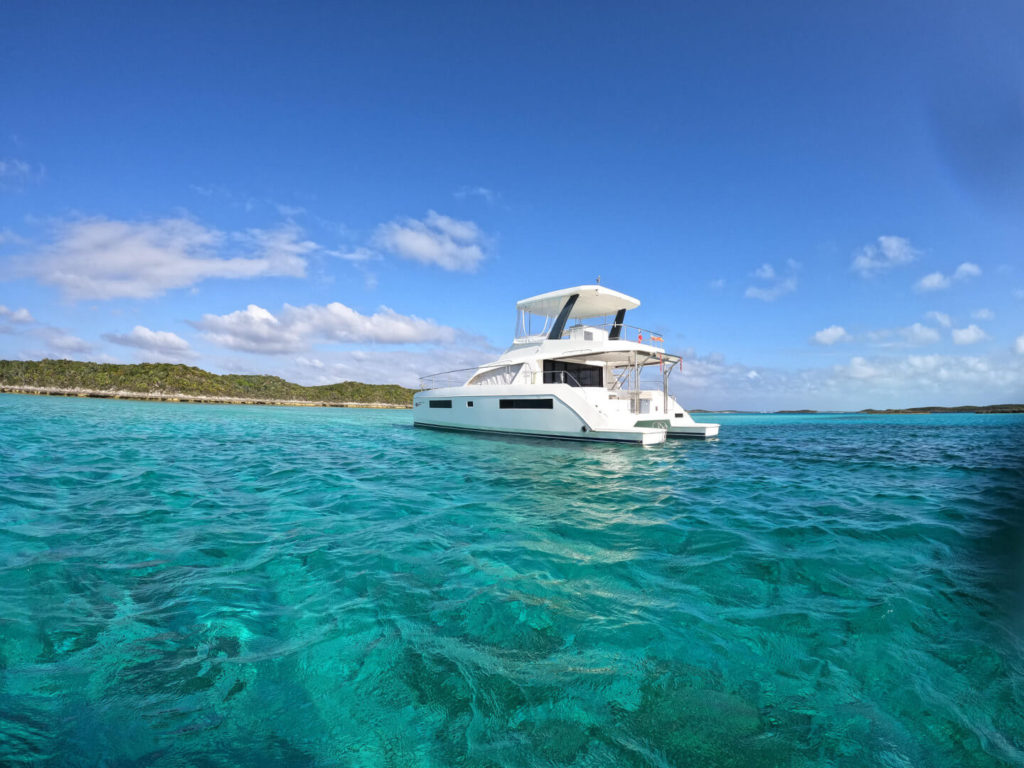
What advantages does a power catamaran have over a sailing catamaran? To find out, we bareboat chartered the Leopard 43 Powercat (aka 43 PC) from The Moorings in Nassau, Bahamas to cruise the Exuma Cays for a week. Let’s see how fast she goes, much fuel she burns, how much gear she can store, and how she handles in the marina and at sea.
The Good
- Twin engines make close quarters maneuvering a breeze
- Tons of storage and space to swing your arms
- Speed to support an aggressive itinerary
- Shallow draft for navigating shallow water
The Bad
- Disappointing handling in heavy seas
- Thirsty on fuel when compared to sailboats
- Poorly looked after by The Moorings/Sunsail Base in Nassau
How Big is the Leopard 43 Powercat?
The Leopard 43 Powercat is the smallest power catamaran in the Leopard line. She blends the bones of the Leopard 40 sailing catamaran and the Leopard 51 Powercat. Between the waterline and the salon roof, the 43 PC seems almost identical to the Leopard 40 sailing catamaran, carrying her extra three feet in the swim platform…possibly to improve prop pitch and trim the yacht out while on a plane. However, like the Leopard 51, she has over 500 horsepower to get up on a plane and GO!
She also shares similar lines to a Leopard 51 with a hard-topped flybridge in lieu of a boom, mast, and cockpit helm. This easily doubles the outdoor deck space compared to the Leopard 40. She also trades a trampoline up front for a hard-decked bow. With a draft of 3’1″, the 43 PC is a full foot shallower than the 40-foot and 2″ shallower than the 51. This is also an improvement of three feet or more when compared to sailing monohulls in this size range. Heck that’s even a few inches less than the Nordic Tug 26 we tested last year. In the shallow waters of the Bahamas, this gave us a ton of confidence when venturing close to shore and through shallow passages.
How does the Leopard 43 Powercat compare to other types of yachts? Being a catamaran, the 43 PC is incredibly roomy compared to monohulls. I’m not aware of a monohulled powerboat under 50 feet with four very usable staterooms and two heads. While you might find those sleeping accommodations in some monhull sailboats under 50 feet, you won’t find them with the deck space and storage space that you’ll get on the 43 PC.
Even among catamarans, the 43 PC gives you a lot of yacht in 43 feet. Compared to the 38-foot Lagoon sailing catamaran we chartered in the British Virgin Islands, this yacht felt much larger in every part of the yacht. Leopards are designed for the charter market and prioritize space and comfort at anchor. On internet forums, yachts designed for bareboat charter like this one are derisively referred to as ‘condo cats’. I think it is an accurate metaphor, but I don’t take exception to it. Boats are a series of trade-offs, and this one ticks a lot of boxes for the Busy Boater crew that’s just looking for a week of low stress near shore cruising. We aren’t looking to make ocean crossings or deal with long-term ownership issues.
So, while the Leopard 43 Powercat is a small 43 footer by Leopard’s standards, it is about as much boat as you’ll find packed into 43 feet elsewhere.
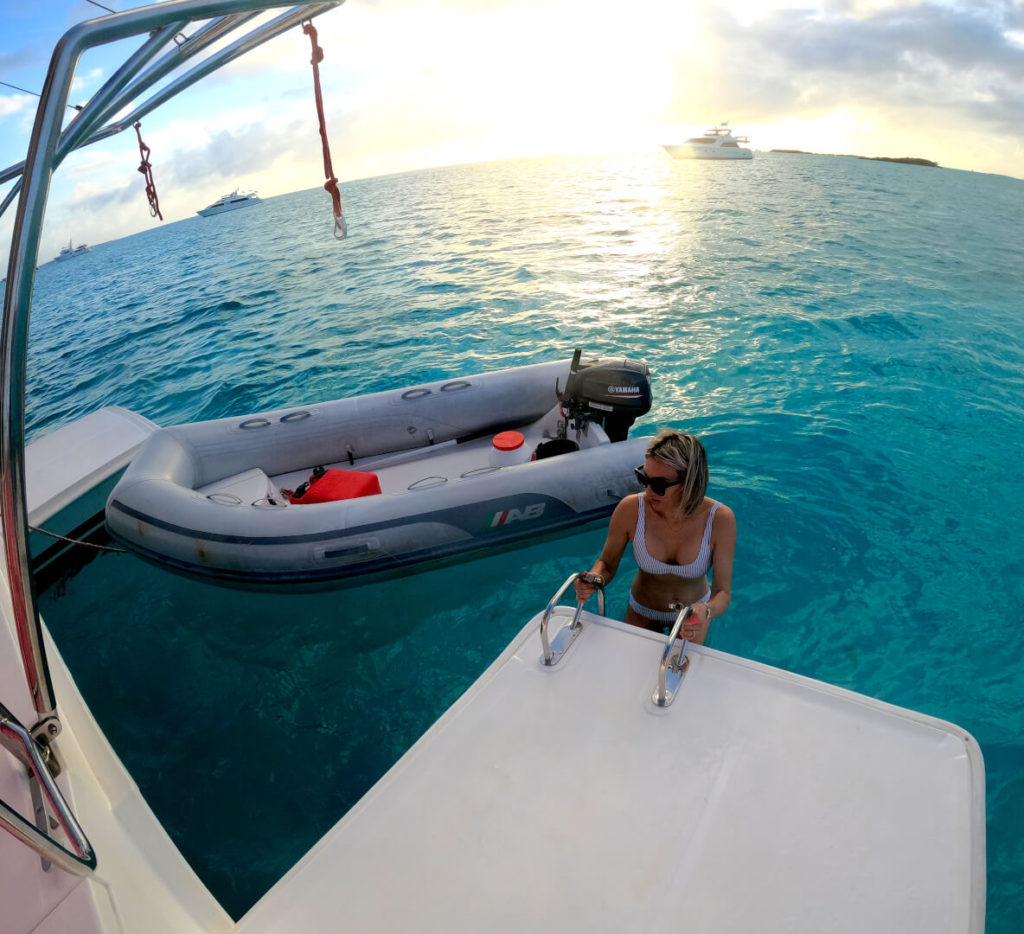
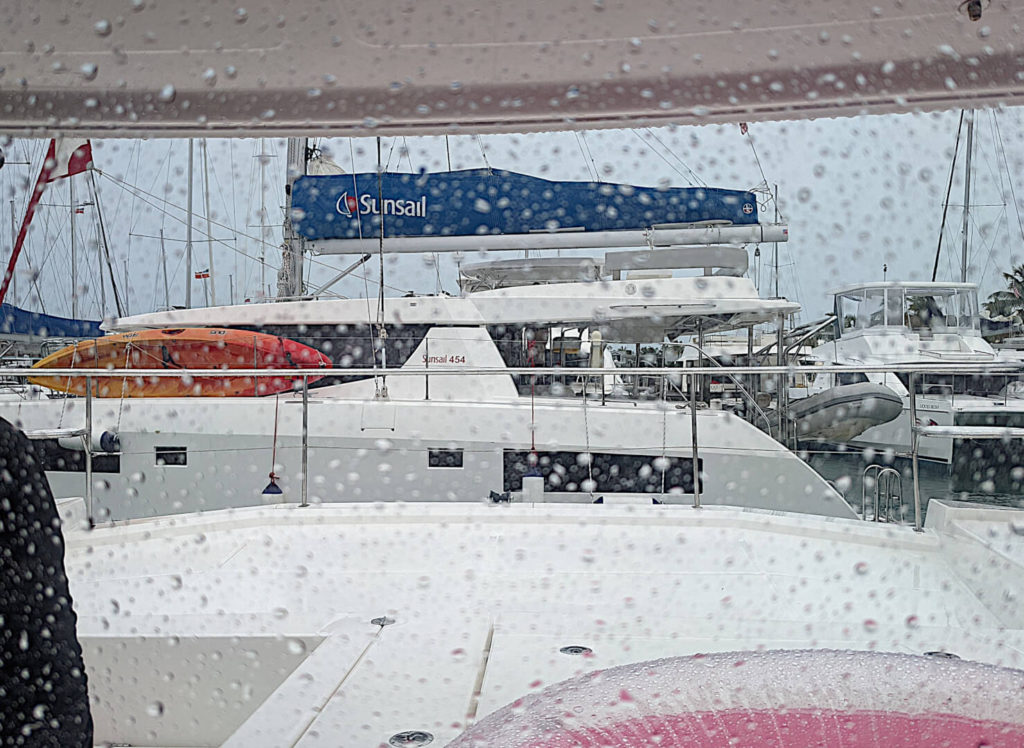
At the Helm of the Leopard 43 Powercat
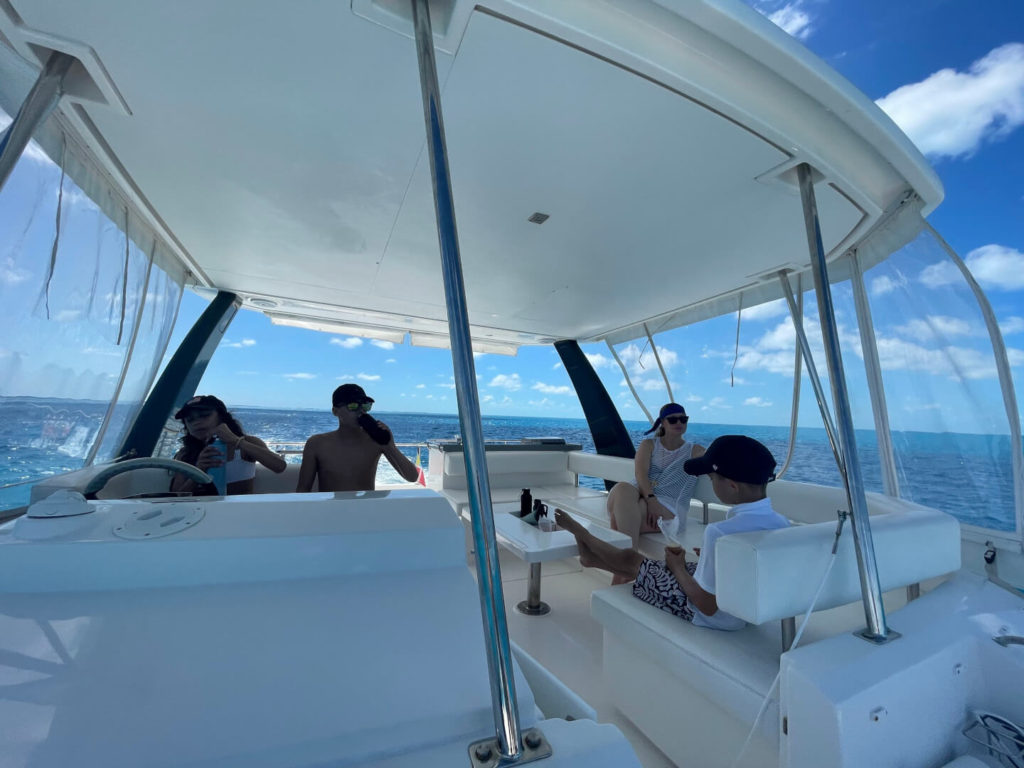
This power cat has one helm station. It is located on a flybridge that caps the salon and cockpit. Most of the flybridge is covered by a hardtop. It comes standard with vinyl windows on three sides to protect you from the weather. Without a lower helm, this feature is very handy. When you are cruising at 15 knots against a 20 knot headwind, that’s 35 knots of wind at your face. Add in some rain, and it ain’t a pleasant experience without at least this plastic sheet to shield you from the weather.
Luckily for us (/sarcasm), the yacht we chartered did not have its front vinyl panels. We asked to swap or pull some from another yacht, but were denied. This made running in a downpour on our first day out a downright miserable experience. We were surprised to also get sprayed all the way up here when cutting through some 4-foot seas in Exuma Sound. The windows can be rolled up out of the way on a nice day, or, like in our case, when an incomplete set gets ripped from its threads and you have to makeshift repair them at sea.
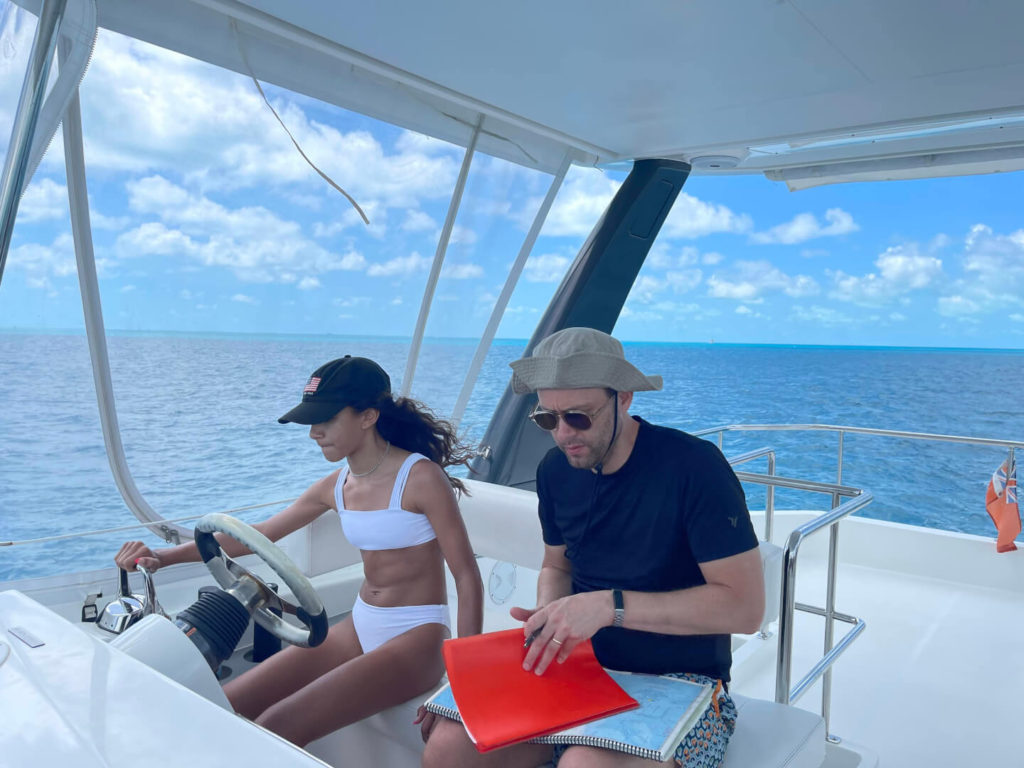
The helm seat is against the port (right) side of the flybridge. The seat is wide enough for two to sit comfortably with space in between. However, the small wheel is offset to the right and the throttles are set low and to the right of the bench. So, its hard to share the controls or take over when training a newbie. While the seat is very comfortable, the controls are mounted too low to stand at the helm, and there isn’t much to hold on to or lean on. Although, when getting drenched in a deluge one day, I set the autopilot and watched from the back of the flybridge at the stairway to get a bit further out of the rain.
The Yanmar engines come with electronic controls. The throttles can be synced to run at the same speed with a single handle when cruising. On twin engined powerboats you can sometimes find the engines out of phase just enough that they resonate with an annoying wah wah sound and vibration, but electronically synchronizing throttles eliminates that. The Yanmar engine display only showed the status of one engine at a time, and we were unable to figure out how to toggle between the two. You could watch RPMs on the Raymar multi function display, but I had to crane my neck to the left to see them while adjusting the throttles on the right.
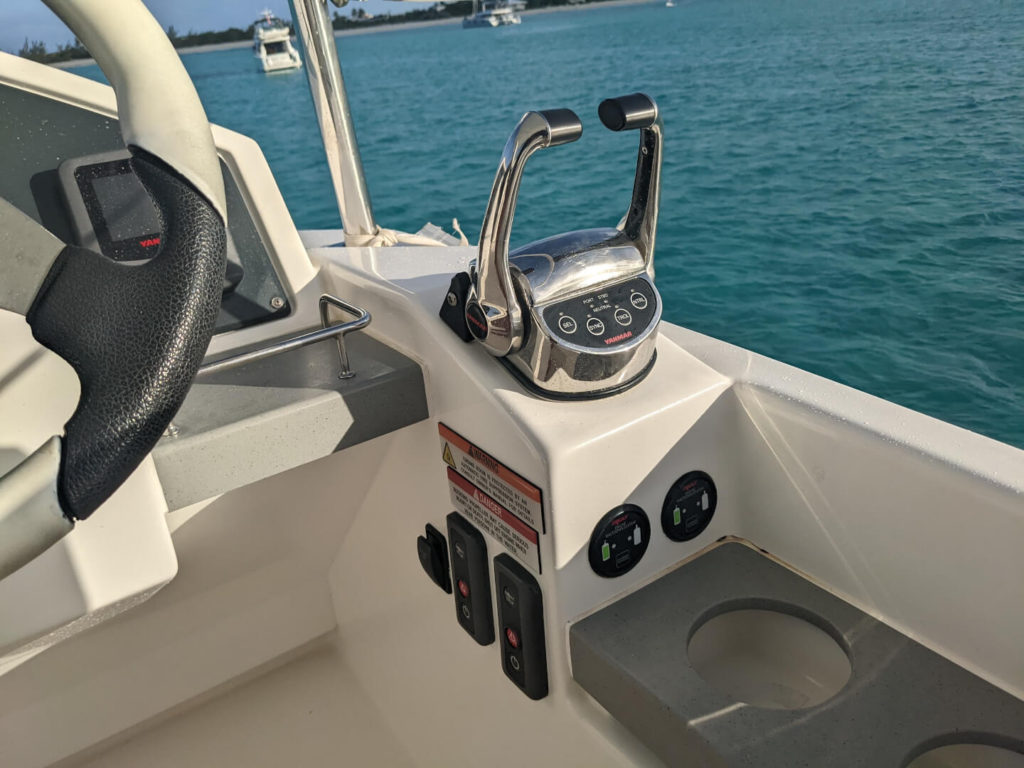
Electronics
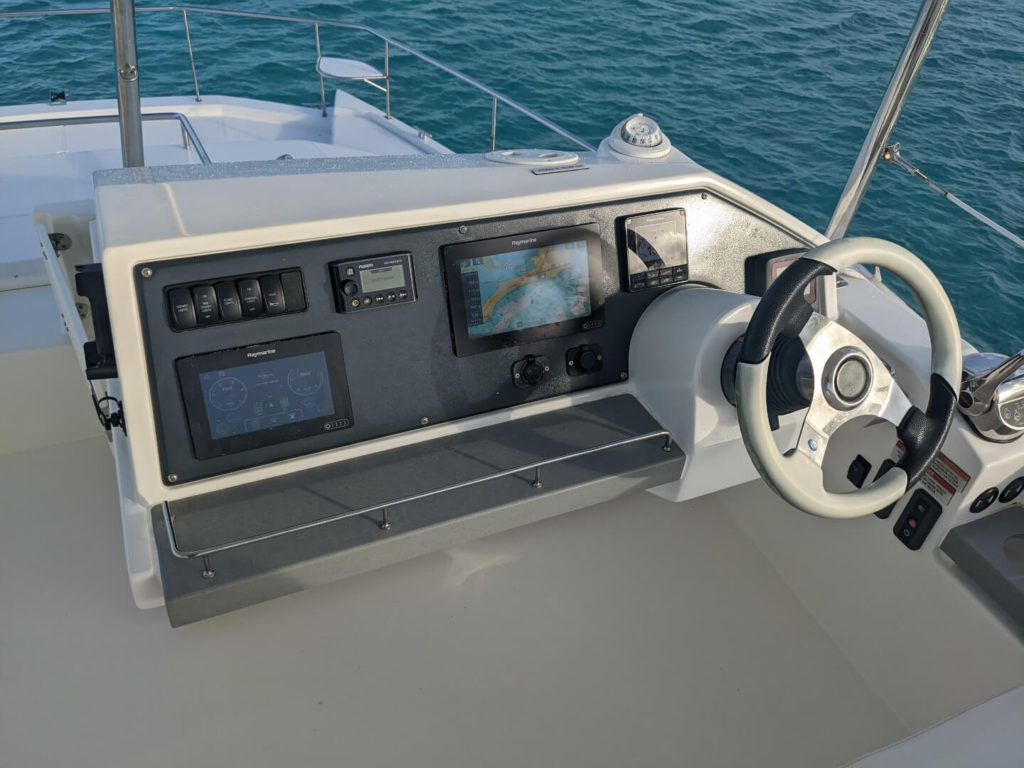
The Leopard 43 Powercat comes from the factory with a VHF mounted above the electrical panel in the salon with a remote VHF mic hung on the side of the helm. At the Moorings Nassau base, they remove these because they get damaged by the salt spray…like my hat, face, etc. No matter, our VHF didn’t work anyway. The yacht had a charging station for a handheld VHF, but that too was missing.
Our yacht had onboard wifi available from The Moorings for a fee. We spoke with returning charterers at the base who said it was no more effective than the wifi on their cell phones, so if you have a good international cellular plan or a Bahamian SIM card, this isn’t a worthwhile option. We did find that when cell signals were weak, we could turn set one phone up as a hotspot and leave it on the flybridge for better reception and connect to it with other phones in the cabins to improve performance.
The yacht has a Fusion stereo, controlled with the RA70 head unit at the electrical panel and MS-NRX300 remotes at the helm and the galley. This system is a very popular OEM choice for good reason. It is solid, simple, easy to use, and easy to read in harsh conditions. Plan to bring a few mixes downloaded to your phone to pair to the Bluetooth as access to radio stations and cellular internet may be spotty. There’s also no holes for CDs or tapes.
You can control everything from the remote units except balance levels across the four zones: bow, salon, cockpit, and flybridge. The zones could only be controlled from the head unit on the electrical panel. This wouldn’t be annoying except that if you have one zone turned all the way down at the head unit (to mute it), but turn the volume up from a remote, it brings each zone up proportionally and will turn on the muted zones. You can overcome this by controlling the volume on your phone. With a pair of 6.5″ marine speakers in each zone, you can crank it up plenty enough to annoy everyone in the anchorage, but you won’t be blowing any doors off. We had to tinker with the tone and volume settings to get a reasonable volume on the flybridge that overcame the engine and water noises without distorting while underway.
Raymar Electronics Suite
A suite of Raymarine electronics is included from the factory with two multifunction displays that can show tank status, engine status, chartplotter, fishfinder, and a camera pointed at the stern. It does not come equipped with a radar or AIS. The two displays are different sizes, but work identically and can toggle between the same screens. We used the larger screen for the chartplotter and the smaller to show the engine and fuel info while under way. The displays could also had a screen for levels of tanks and batteries, as well as an alarms screen that demanded attention with loud beeping until you toggle through and acknowledge.
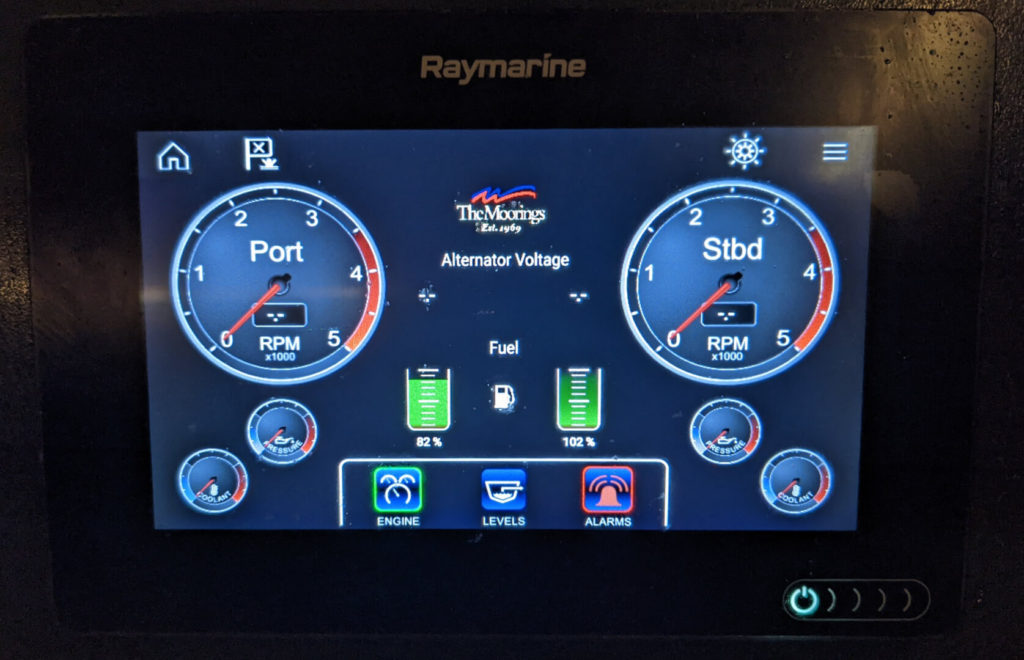
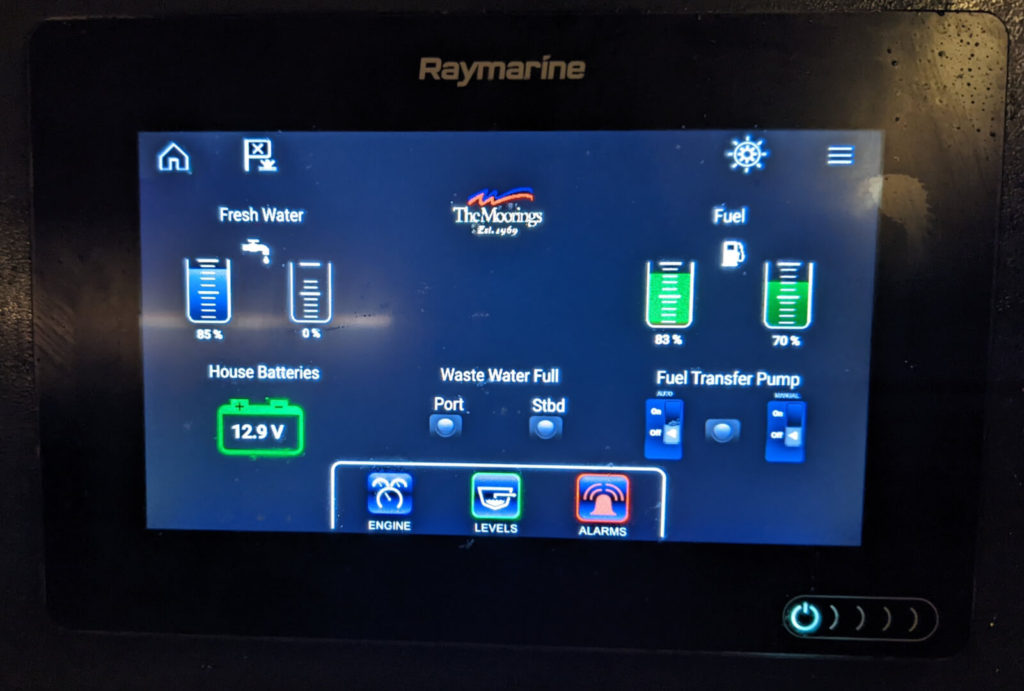
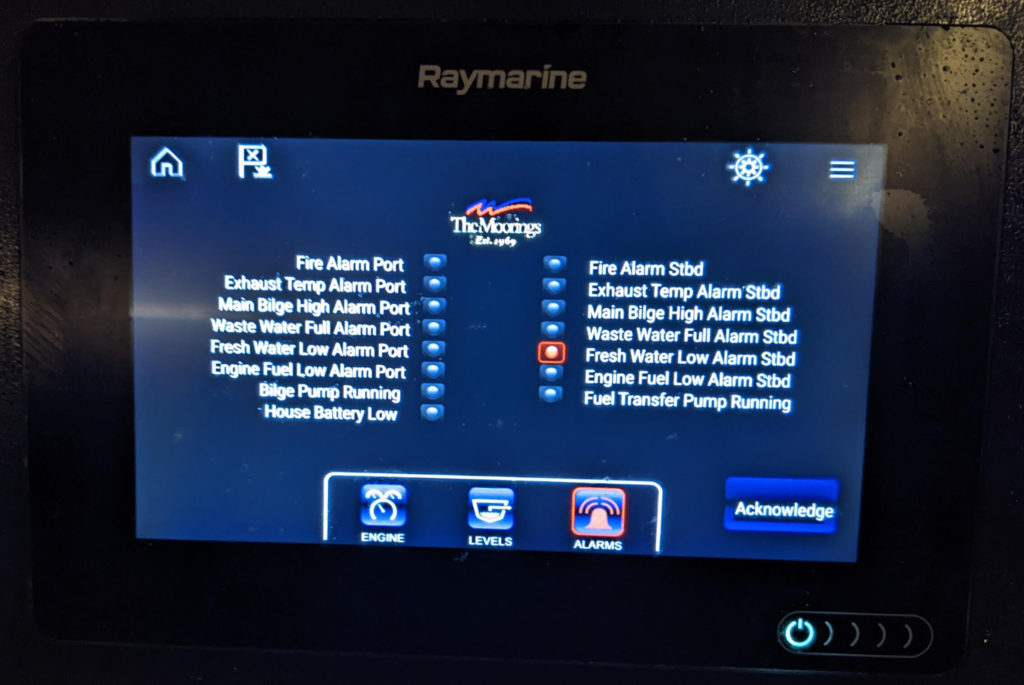
The multifunction displays are touch screen and work very effectively with two exceptions. One, the power button is a PITA, so we mostly left them on and covered in the evenings. Two, once sprayed with saltwater, the touch functionality is seriously impaired; this is not good when in rough seas trying to adjust the chart.
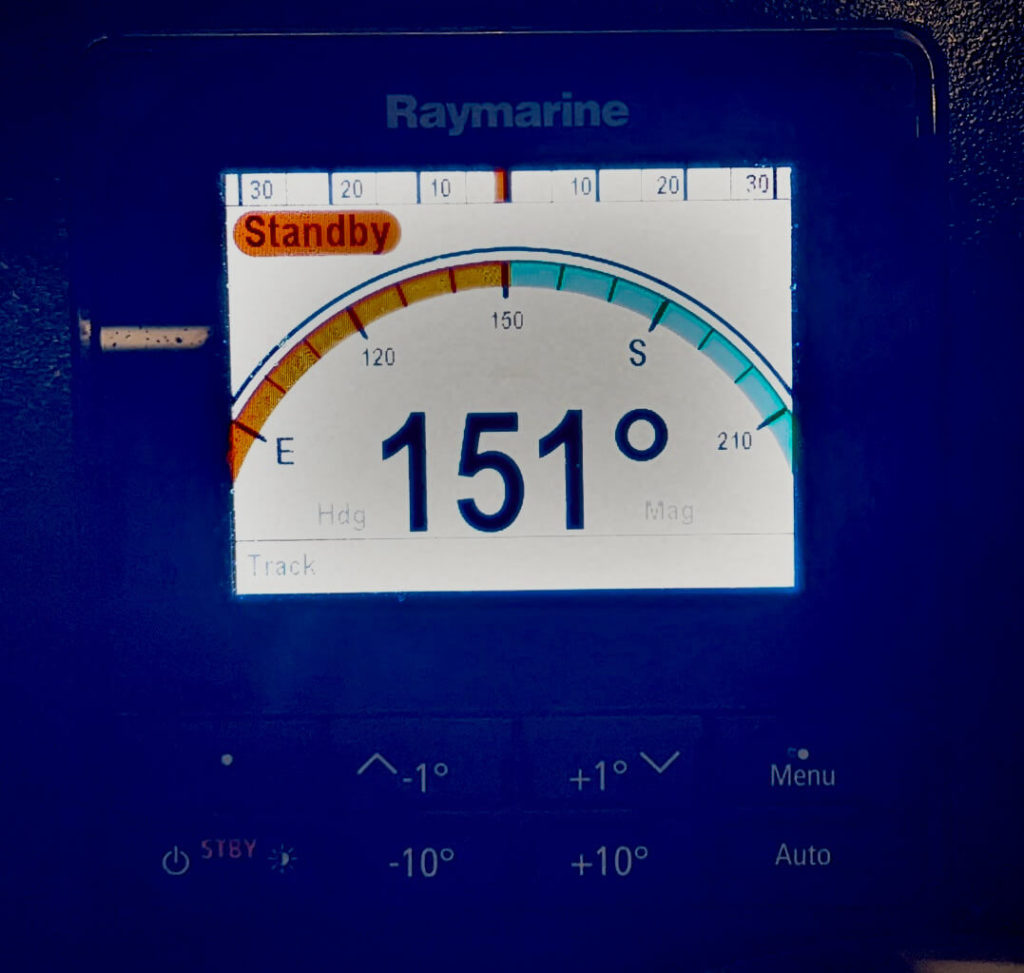
There’s also a separate screen to control the autopilot that includes rudder indicator (you know how I love rudder indicators!) and heading. There is no water speed indicator on this yacht, only speed over ground from the chartplotter.
According to Raymarine, the chartplotter module can be connected to the Navionics boating app on your phone to transfer waypoints and routes. We were unable to connect Navionics to send our waypoints. The checkout skipper didn’t know that was possible, but was eager to figure it out. The manual was not helpful (common theme), but we eventually found the menu and needed a password to connect to wifi, which we didn’t have.
Under Way in the Leopard 43 Powercat
The Leopard 43 Powercat has relatively small rudders, so the yacht is not very responsive to the wheel at slow speeds, and do not induce a pivoting turn like you’d expect on a yacht designed for slower speeds. What I mean to say is turning the yachtt with the wheel SUCKS. However, with twin engines placed a mile apart, it was a breeze to maneuver using the throttles. One engine in forward gear and one reverse easily spins the yacht within its own length. Running one engine at a higher speed than the other, or bumping one into neutral, are very effective at turning while running. Once over 5 knots or so, I relied almost exclusively on the autopilot, which again was easier than maneuvering the teeny little sport wheel. So I never really used the wheel, but the kids always insisted on using it when they took the helm.
There are no trim tabs to adjust the height of the bow while on a plane for comfort and efficiency. I don’t understand the physics, but this is apparently common in catamarans. The yacht did maintain a good trim at different speeds and sea states, regardless.
We found ourselves almost exclusively on the flybridge when underway. When running on a plane, the yacht has enough bounce that its a bit unnerving to climb down the stairs and be anywhere near the stern. Unlike most motoryachts, the stern is open on the sides, and our yacht was missing a lifeline down the center. You also get more engine noise in the salon, and when in rough seas, you get some nasty hull slap that isn’t really noticeable on the flybridge, but throws the floor and table with quite a crash down below.
How Does the Leopard 43 Powercat Handle Rough Seas?
When I describe rough seas, everything is relative. For most of our weeklong charter on this yacht we were on the Exuma Bank, protected from rough seas by the Exuma Cays. When crossing the yellow bank from Nassau, where the sea is a bit more exposed, we got some 1-2 foot seas, which the yacht smoothed right out when on a plane.
One day we crossed a cut between the island chain out into the Exuma Sound to save some time. Well, honestly, we also did it to say we’d crossed a cut and spent time in the Sound…and to give you the yacht test you deserve. The cuts, which are thin channels between the islands, can be challenging because the tides create a lot of current as water is exchanged from one side of the islands to the other. When the current is against the wind coming in from the Sound on the east side of the islands, the surface water in the cuts can also be very violent. However, with 640 horsepower at the stern and good timing, the cuts themselves were no match for us.
Surprisingly though, once out in the Sound, we found some very confused seas. The waves were only four feet, but very close together, maybe a second or less apart. They were mostly (but not all) coming from the East, so we’d have them at our bow on the way out, beam on the way north, and stern as we crossed back into the Exuma Bank.
Taking the waves head on, I was deftly afraid of stuffing the bow and learning more than I ever wanted to about nets vs solid catamaran bows. Then, when we had the waves at our side on the beam, the yacht rocked too and fro with such velocity that my stomach would get roller coaster like butterflies…sitting up high and exposed in the flybridge, this was downright scary.
We found the smoothest ride ‘quartering’ the seas with the waves 45 degrees off the bow with the hammer down going over the waves as quickly as possible. However, we still got pounded something fierce. The bow of the pontoon on the side taking the wave would occasionally plow under it and throw buckets of water up to and across the flybridge, drenching the entire crew.
Perhaps more unsettling was that there’s not much in the way of good handholds when sitting on the U-shaped settee (couch), or on the inboard side of the helm seat. Meanwhile, down below in the salon, the kids thought this roller coaster ride was a blast, jumping with the hull slaps…until one blew ramen chunks in the sink…then the microwave broke loose and fell in the dish drainer, and they realized things were a bit serious and took their seats…using a foot to keep the broken refrigerator drawer from swinging in and out.
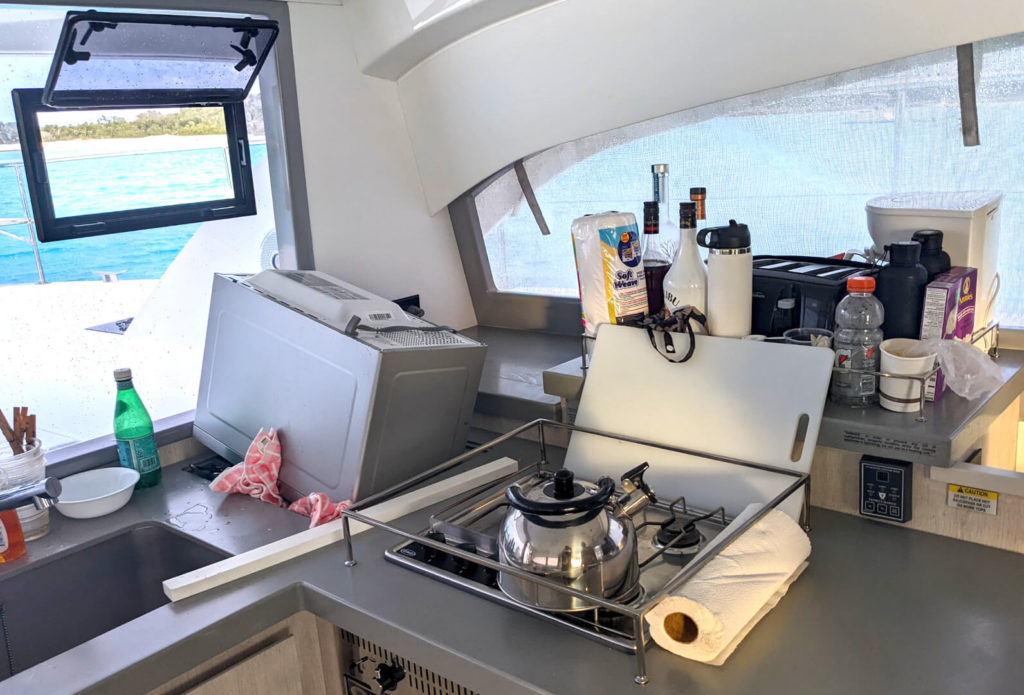
Finally, with a rising tide, we had wind waves and current at our stern when we headed back through a cut North of Warderick Wells. Well prepared to ride the surf like a boss after doing it in Maui, we cautiously turned toward the cut. Unlike the nimble 24-foot catamaran we had there, this yacht could not go as fast as the surf to maintain control. Even with the hammer down, the waves would crash at our bow, pushing us well over 20 knots! I was able to maintain control by throwing the engines in reverse to get behind the waves as they caught us. We didn’t need to turn until we got out of the surf, but if we had, I’m certain we could have turned out with the throttles, but I’d be wary of counting on our tiny rudders to be much help.
Engines
Our yacht was equipped with twin Yanmar diesel V8s with 320 horsepower. These are optional engines. The base engines are 260 horsepower straight sixes; also Yanmar Diesel. Access to fluids was relatively easy, with the dipstick, oil filter, coolant, impeller, sea strainer, and fuel filter all located towards the front of the engine. The sea strainer was located above the water line, allowing it to be cleaned without closing the through hull: if you open a sea strainer below the water line with an open through hull, sea water will rush into the yacht making a mess and causing panic…if you close the through hull to work on the strainer, but then forget to open it when done, you’ll overheat the engine. So this is a simple improvement to help overcome some of our stupidity.
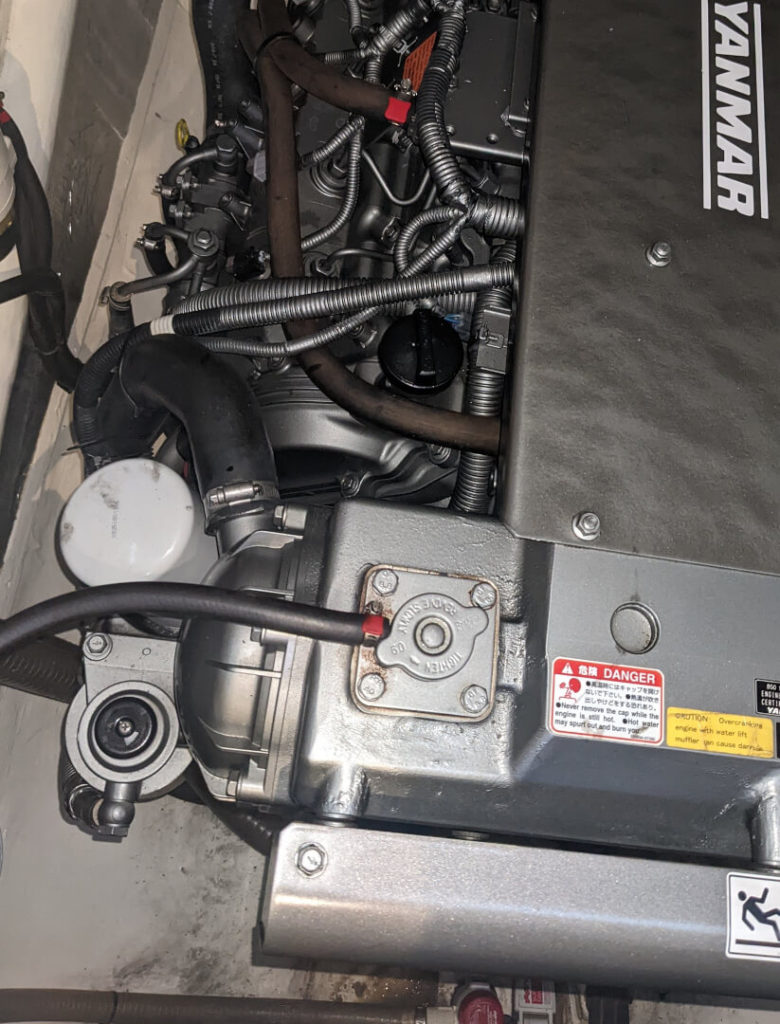
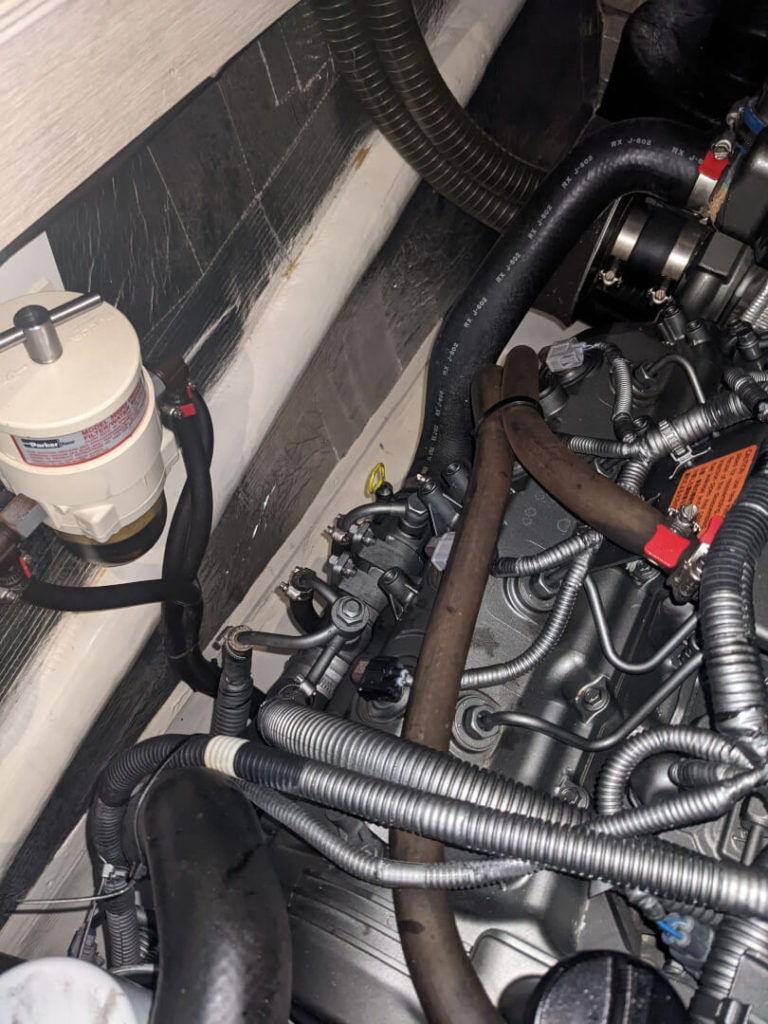
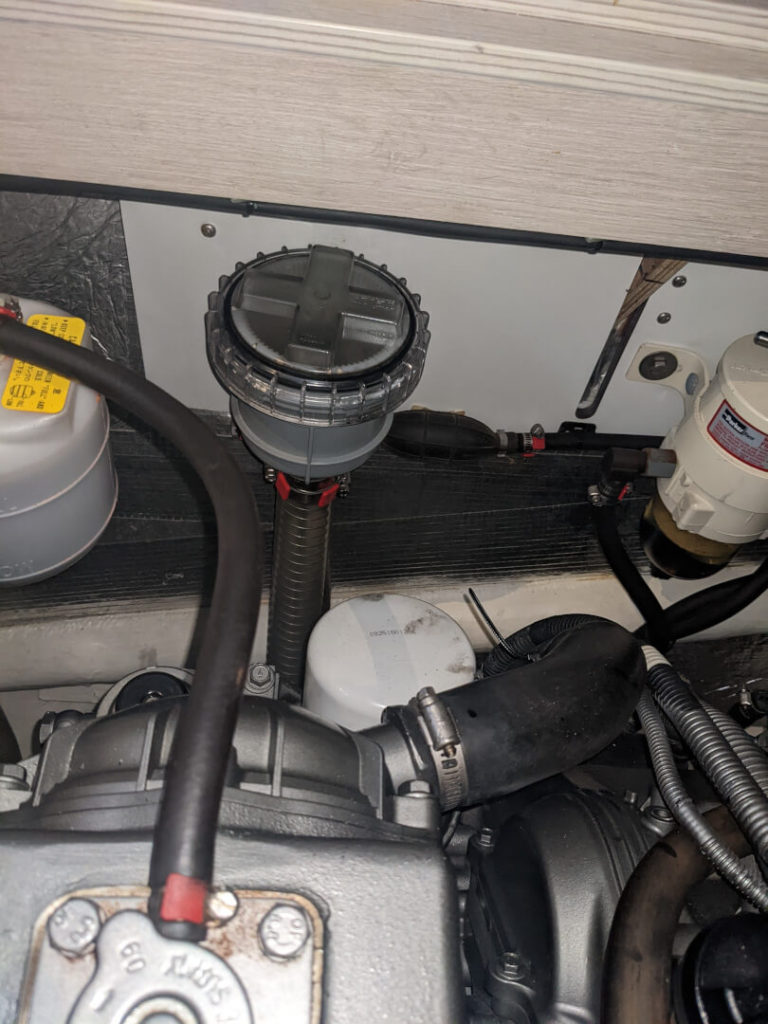
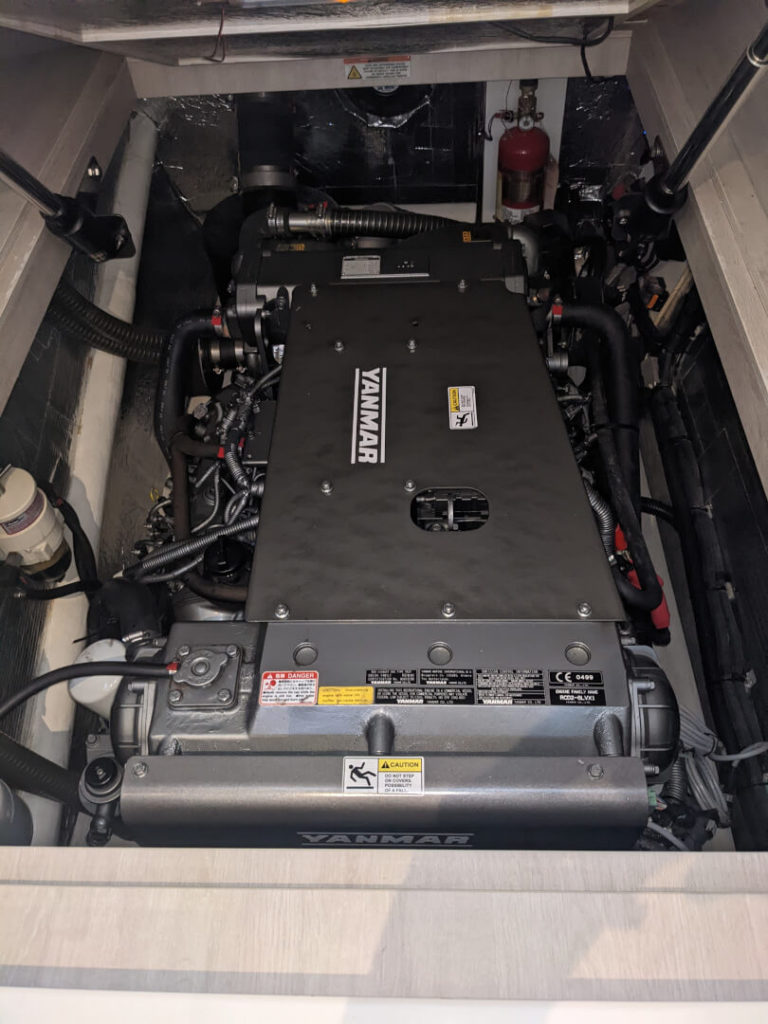
How Fast and Fuel Efficient is the Leopard 43 Powercat?
Without a water speed indicator, or a GPH indicator (that we could find on the MFD), we were unable to precisely measure the engines’ performance. In charter service the engine’s throttles are limited by a piece of plastic screwed into the side of the throttle controls. With the limiter in place, we were able to get the engines up to 3,000 RPMs and cruise around 17 knots (20 mph) in calm seas. This was about a knot slower than specs we read on the internet, which might be credited to the very dirty hull we got. Expect to lose about 2 knots off the top end with the standard 260 horsepower straight-six engines.
What is the Benefit of the Powerboat Speed?
While most of our hours were running with the hammer down at 3,000 RPMs, we also found a comfortable cruise at 2,000 RPMs where we made 9-10 knots and 1,500 RPMs where we made about 7 knots. A 17-knot cruise is 10 knots or 140% faster than we’d expect to motor on a similar length sailboat.
This speed allowed us to run 78 nautical miles from Nassau to the Southern end of our cruising grounds at Big Major Cay in just over 4.5 hours. With our 1:00pm departure, we would not have been able to make that run by sundown on our first day. On our last day we were able to slow down a bit and still run the 37 nautical miles from Highbourne Cay back to Nassau in 2.5 hours. With the yacht due back to Moorings/Sunsail in Nassau by 10am, this would again not be possible in a sailboat.
So, when chartering in a big cruising ground like the Exumas, the powerboat speed buys you, at a minimum, one extra night in the out islands as you really need to head back to the marina the night before a 10am turn-in with the sailboat.
How Much Fuel Does the Leopard 43 Consume at Speed?
On our weeklong trip we burned 185 gallons of fuel with 13 hours on the generator and 18 hours on the engines. Northern Lights states that the 9kw genset burns 0.5-1 gallon per hour (so we’ll assume 13 gallons for the generator). We ran the engines for 11 hours at 3,000 RPMs, 1 hour at 2,000 RPMs, and 4 hours at 1,500 RPMs. We ran mostly at 3,000 RPMs before our first refueling, so I can estimate that we burned about 16 gallons per hour with the hammer down at the 17-knot cruise. That’s actually about 2 gallons per hour better than the internet told us to expect.
With 264 gallons of tankage, we could have gone the full week without refueling, but we did refuel after our big run south on the first day (90 gallons). At sea, it isn’t wise to plan to burn more than half of your fuel, especially when you aren’t familiar with the boat. On a similarly sized monohull, we might would have run 34 hours to make the same distance, but closer to 1 gallon per hour. So, fuel burn would have been less than 50 gallons under comparable use on the monohull, or much less if we sailed and used less generator. However, running a speed in the mid-teens at about one gallon per mile like we did is very comparable to a similarly sized pilothouse monohull motoryacht.
The engines are mounted under the beds in each of the stern staterooms. Many sailing catamarans have the engines mounted further aft (towards the stern). Often in these cases, a sail drive is used to allow the prop to mount at a perfect 90 degrees to the hull. However, sail drives are not rated for the kind of horsepower this cat carries. So, like most motoryachts, the Moorings 43 power cat uses a driveshaft that puts the prop at an angle. The more angle on the prop, the less efficient it will work. So mounting the engines as far forward as possible reduces this angle. With regular access needed below the bed, the platform is raised and lowered on a motorized switch.
I was surprised at how quiet the engines were under way. While, they were nowhere near as quiet as our Nordic Tug 26, they were tolerable even when in the laying in the bed. directly above the engine. Sitting on the flybridge, you are far enough away from the engines that the noise isn’t bothersome at all.
Leopard 43 Powercat Galley
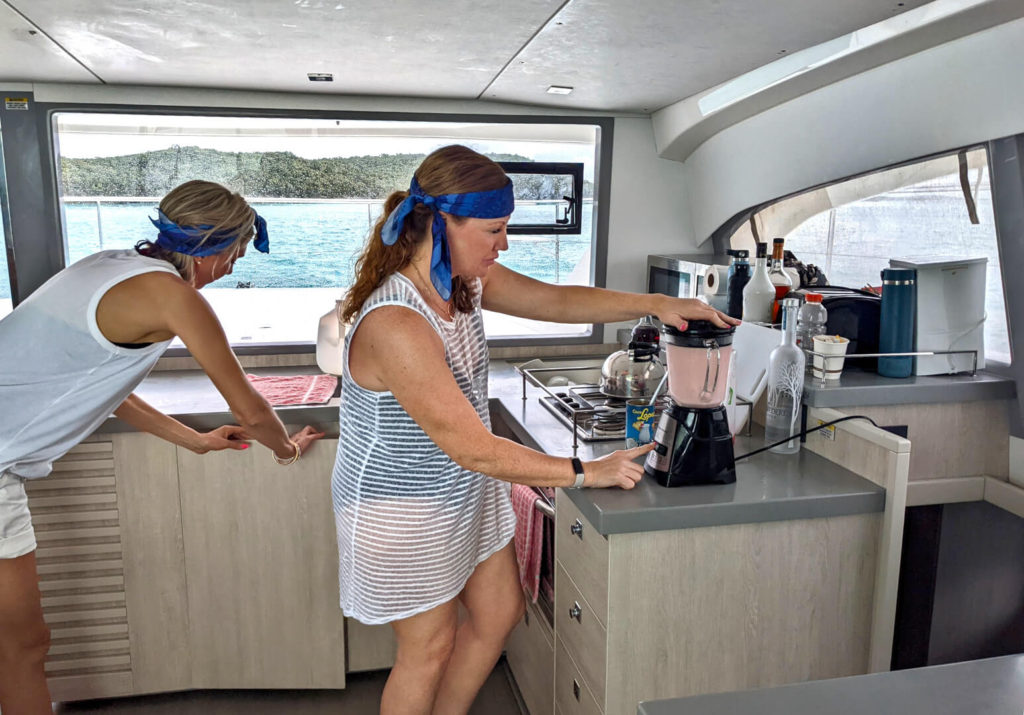
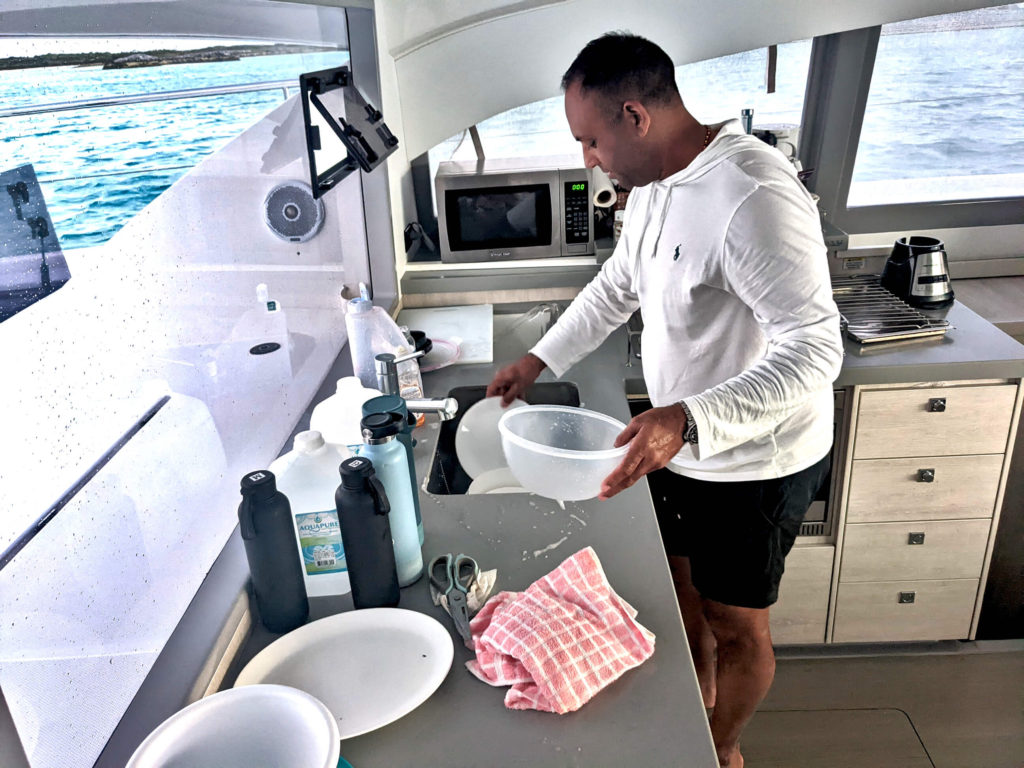
The galley in the Leopard 43 Powercat spans the port and forward edges of the salon. There’s a lot of counterspace with the dish drain recessed with a cover when not in use. The design also takes advantage of space that had to be elevated for headroom down below by elevating the rear of the counter for appliances and storage.
Galley Storage
There’s lots of storage with generous bins for in the salon floor. These work great for bagged dry items like cereal and rice if you remove the box before departing (also reducing trash to hold later)…just be sure not to step in them while open or not properly set or you’ll have little bits of ramen to clean without a vacum or broom/dustpan. There’s also a small cabinet in the stairwell for dry food storage. A very deep cabinet next to the sink holds a generous amount of cups, bowls, plates and storage bins for leftovers. A set of drawers next to the oven holds the utensils.
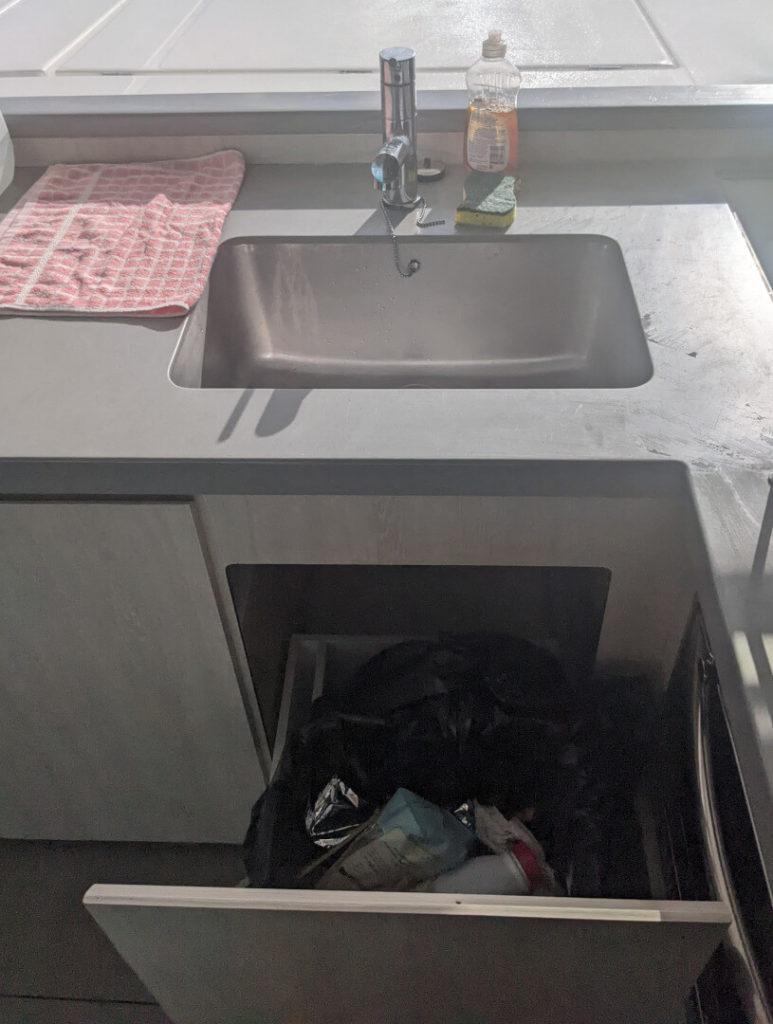
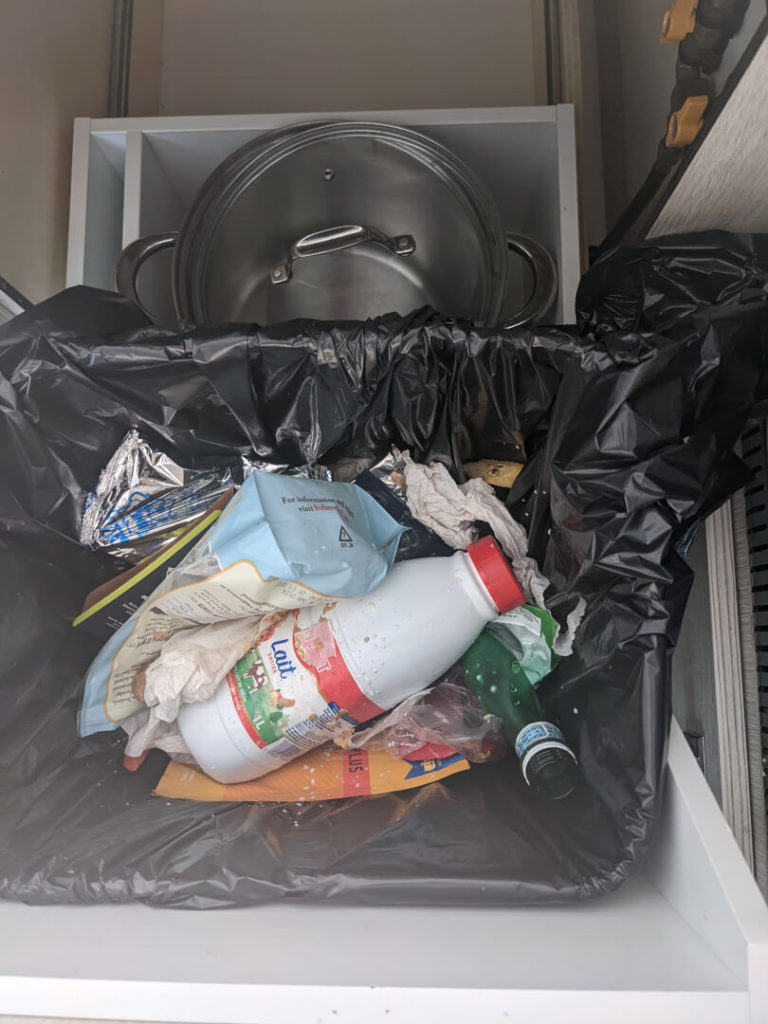
There was a trash drawer below the sink that hung two bins to allow for sorting.
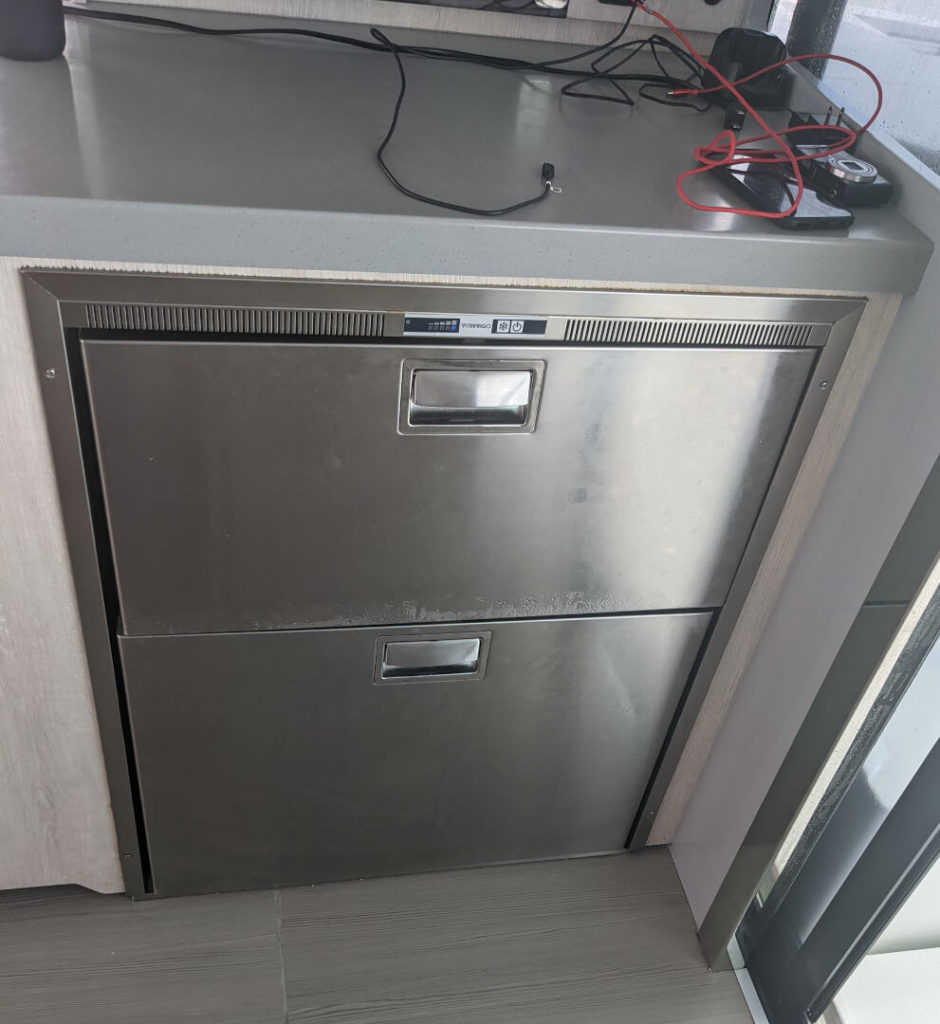
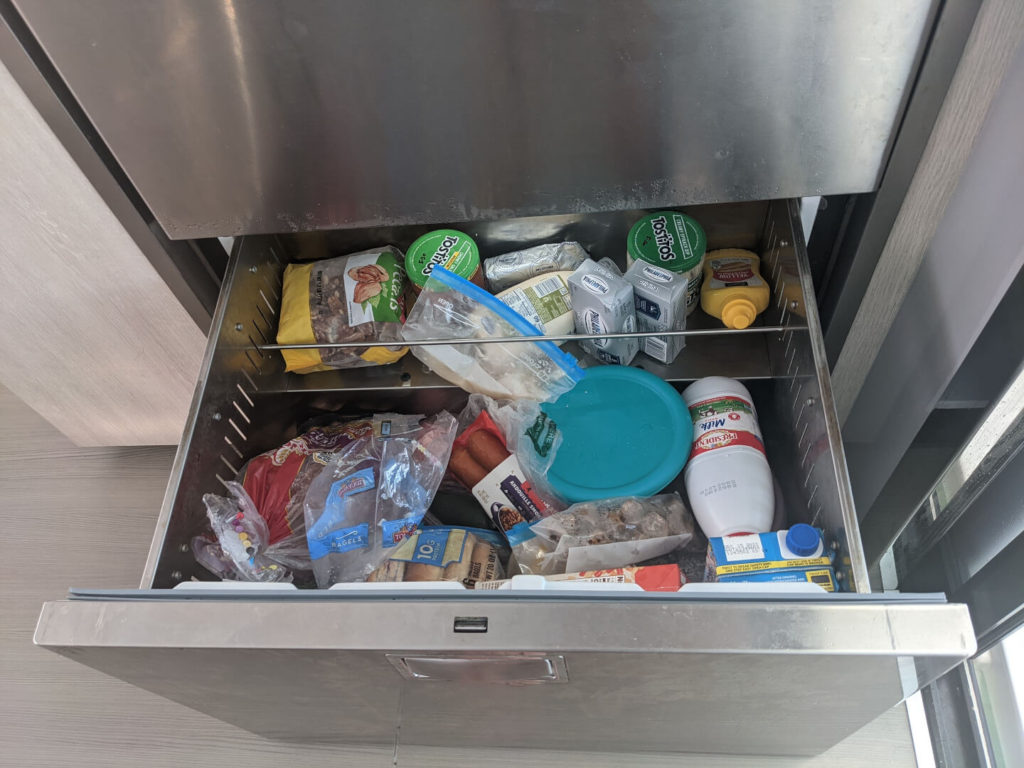
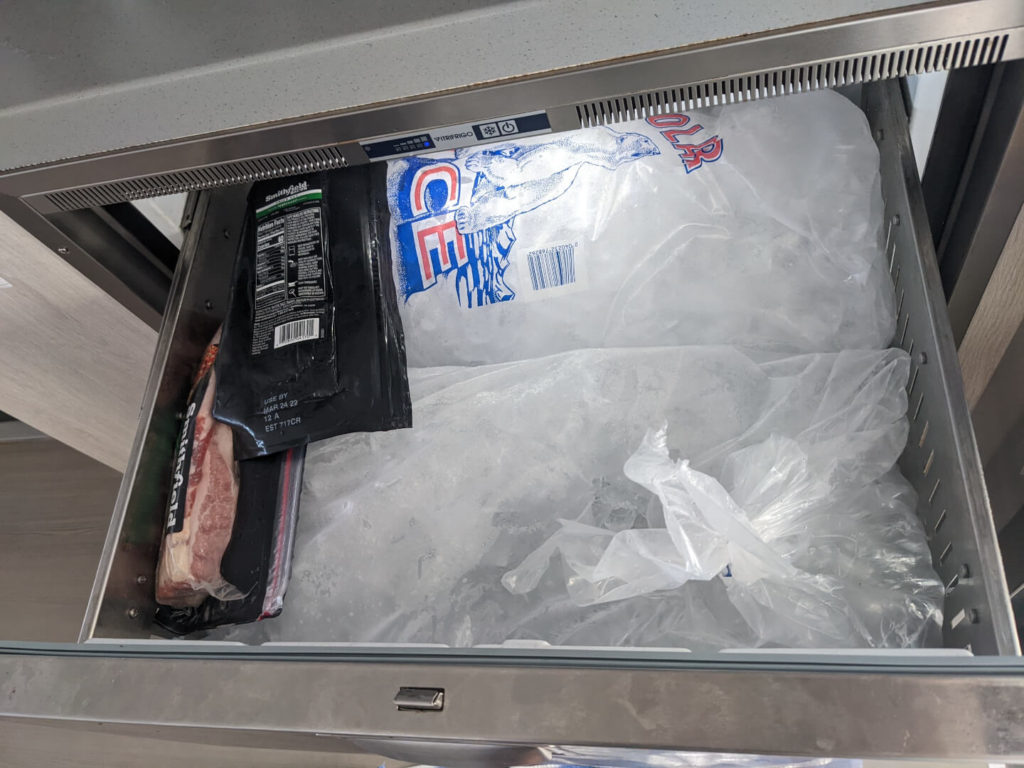
The combination refrigerator/freezer is away from the kitchen at the companionway door below the electrical panel. It utilizes two drawers to facilitate easy access down low. Our drawers were helplessy misaligned in their tracks, so the refer wouldn’t latch and would slide open and closed in rough seas, while the freezer had to be lifted and pulled open from beneath because it was too tight to get enough purchase with the handle.
The freezer was very effective at keeping things frozen. There was room for two 10 pound bags of ice in here plus more. It is cold enough to make larger blocks of ice to keep a cooler cold during your trip if needed. The bottom drawer is a fridge, while the top is a freezer. The fridge drawer was slightly larger with a shallower shelf in the rear 2/3 to make room for the compressor beneath. There is only one temperature control for both drawers. We had no trouble holding ice in the freezer all week without freezing anything in the fridge.
Galley Appliances
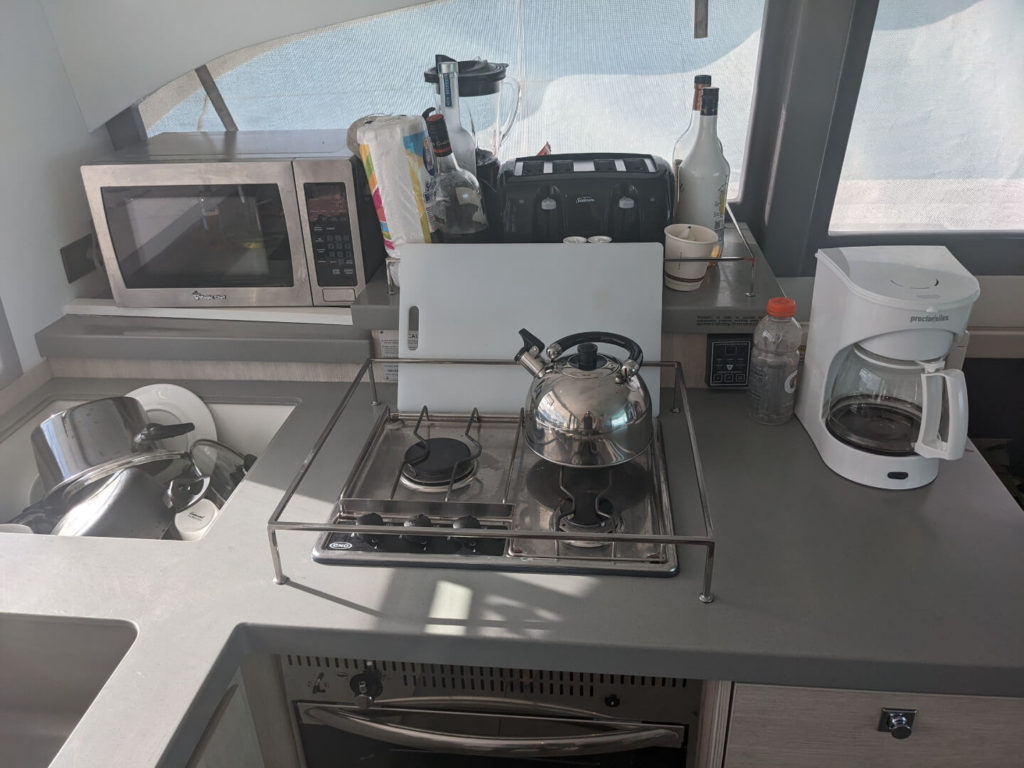
Range
The 3-burner range operates on propane. The electronic ignition on the burners did not work, but The Moorings includes a grill lighter with utensils knowing they can be finicky. The stove was adequate, if a bit crowded, for preparing meals. The oven was relatively small, but included one glass and one aluminum pan that were designed to span the full width of the oven, allowing you to make the best of it…which was fine for anything other than a turkey or crown roast. Our checkout skipper was surprised that the electronic ignition worked on the oven, so plan on lighting that with the lighter too. We were unable to get the broiler to work, and the user manual only had info on installation, not operation. This wouldn’t have been frustrating if our flybridge BBQ was operational.
The range was equipped with an electric propane valve and propane sniffer. Our valve sounded the propane alarm during our sea trial. After finnicking with it for a bit and throwing the breaker, it stopped complaining, but the valve never closed, allowing propane to the stove regardless of setting. Our checkout skipper told us it was fine. While it wasn’t ideal, we closed the tank valves when not using the range and didn’t get blowed up.
Electric Appliances
Our test yacht was equipped with a microwave, blender, four slice toaster and coffee maker that all ran on 120v electricity. With no stovetop percolator or French press, that meant that you needed to start the generator to make morning coffee: put the first couple to rise in the starboard stern stateroom to minimize the impact. You could also consider bringing a pour over funnel or aeropress to reduce generator usage.
Another issue with the appliances is there are two 120v appliance circuits with one serving each side of the yacht. This meant that while there were three sets of outlets in the galley, they were all on the same circuit and could only power one appliance at once (without tripping breakers). So, we had to run the coffee pot from the chart table (which was on a separate circuit) in order to make toast and coffee at the same time. Finally, I will note that we started out with a fully functioning four slice toaster that failed on one side a few days into our trip and then eventually the other side failed, leaving us with floppy bread for the rest of the voyage.
The sink is served exclusively by the electric fresh-water pump. There’s no foot pump for sea water pre-rinsing, or as a freshwater backup to the electric pump.
Auxillary galley: flybridge grill station
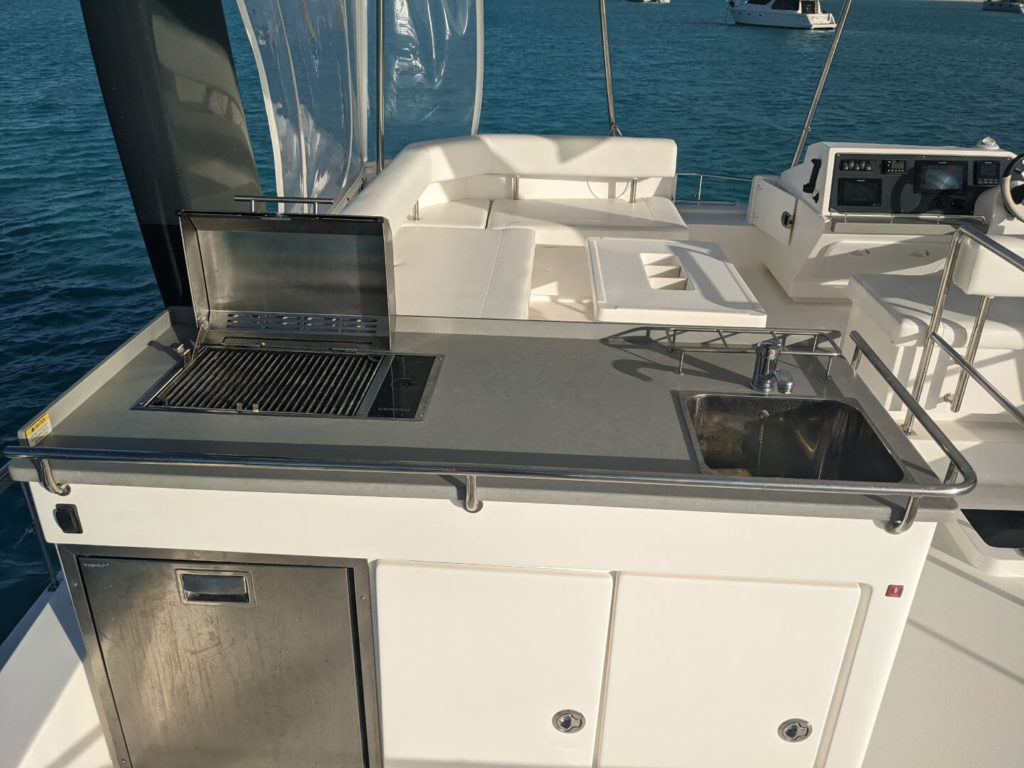
All Leopard 43 Powercats come with an electric grill and sink behind the flybridge settee. Some, like ours, also have an additional refrigerator up here. The extra cold storage is theoretically handy for a long voyage with a large group, or just to keep beverage traffic out of the main fridge. Unfortunately, our refer control was broken and would not get below about 60 degrees, so we just used it for beverage storage. I also can’t tell you how the grill worked because ours had an electrical short that popped the GFCI breaker immediately when turning on. This would have been a great place to cook most meals while without heating or stinking up the galley/salon.
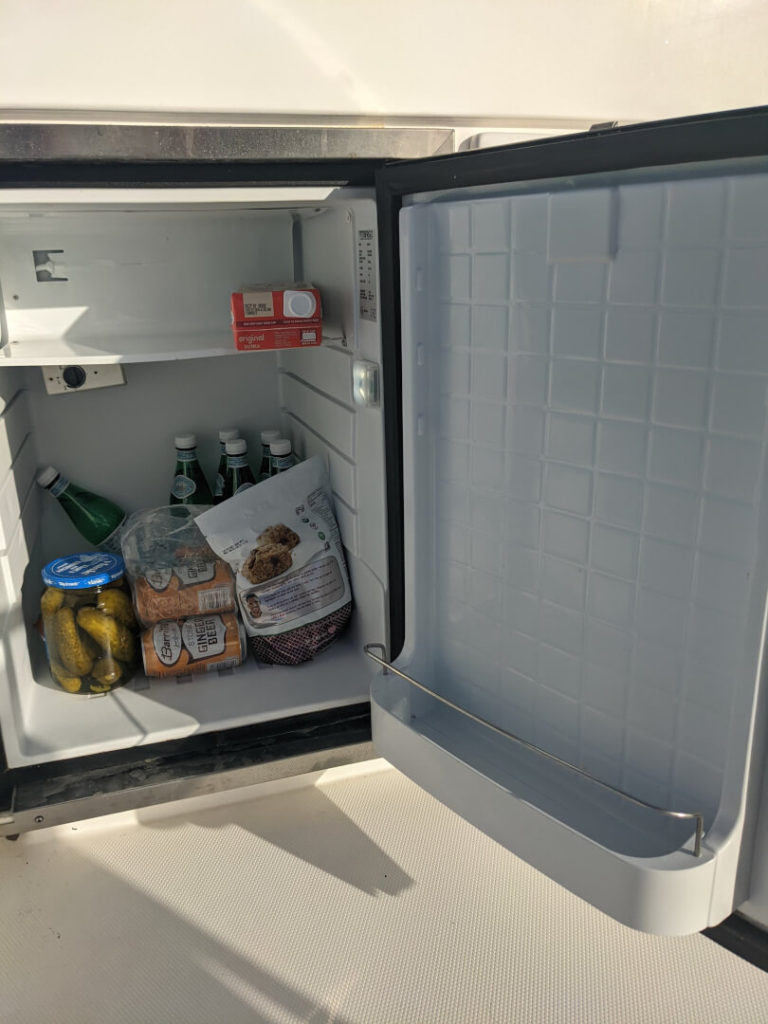
Leopard 43 Powercat Flybridge
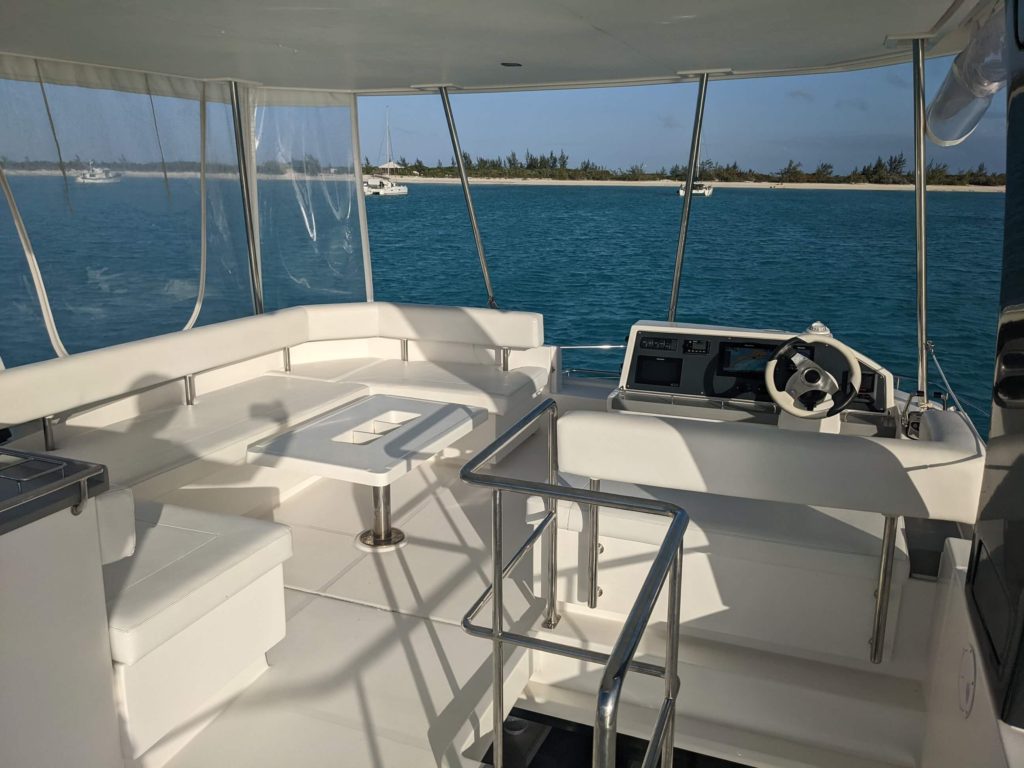
A big advantage of a powerboat over a sailboat, at least in this size class, is that the lack of a mast and boom allows for a large flybridge above the cockpit and the salon. When under way, the crew can sit with the wheelperson and enjoy an unobstructed 360-degree view. Our crew parked here almost exclusively while motoring. There’s lots of room up here to move around, sit, and lay down. A large table inside the u-shaped settee (couch) has three molded bins that are great for keeping phones, snacks, and water bottles from flying around while at sea.
A few downsides to note on this flybridge. There are only two cupholders up here, and they are located outboard of the helm seat, inaccessible to passengers. They also have an opening in the bottom that allows cell phones to slide out and fall on the floor. Perhaps more annoying: there isn’t much to hold onto when sitting at the settee. This can be very unnerving when getting tossed around in rough seas.
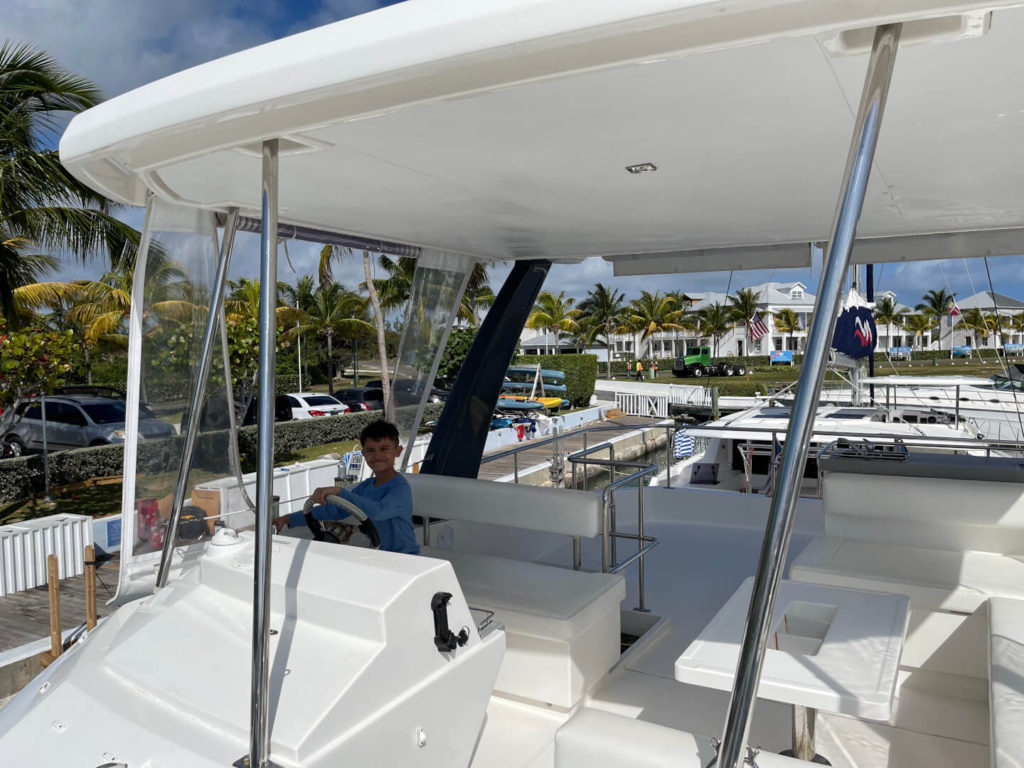
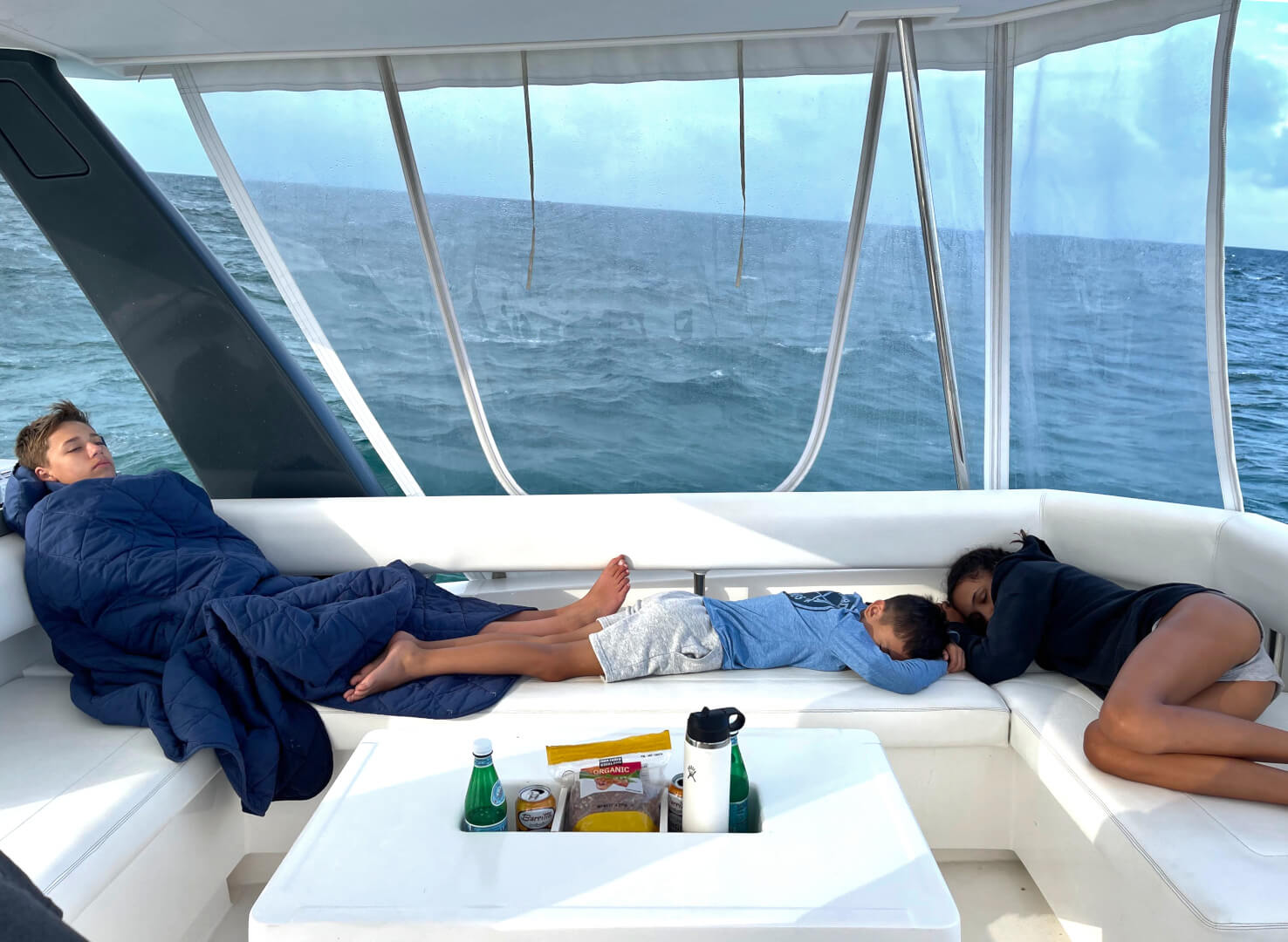
Ahead of the helm and settee, there is a passthrough to a sundeck that can be used while at anchor or under way in calm seas. In the absence of a trampoline on this cat, this ended up being our crew’s favorite spot to relax in the sun. There’s a back cushion, but no bottom cushion.
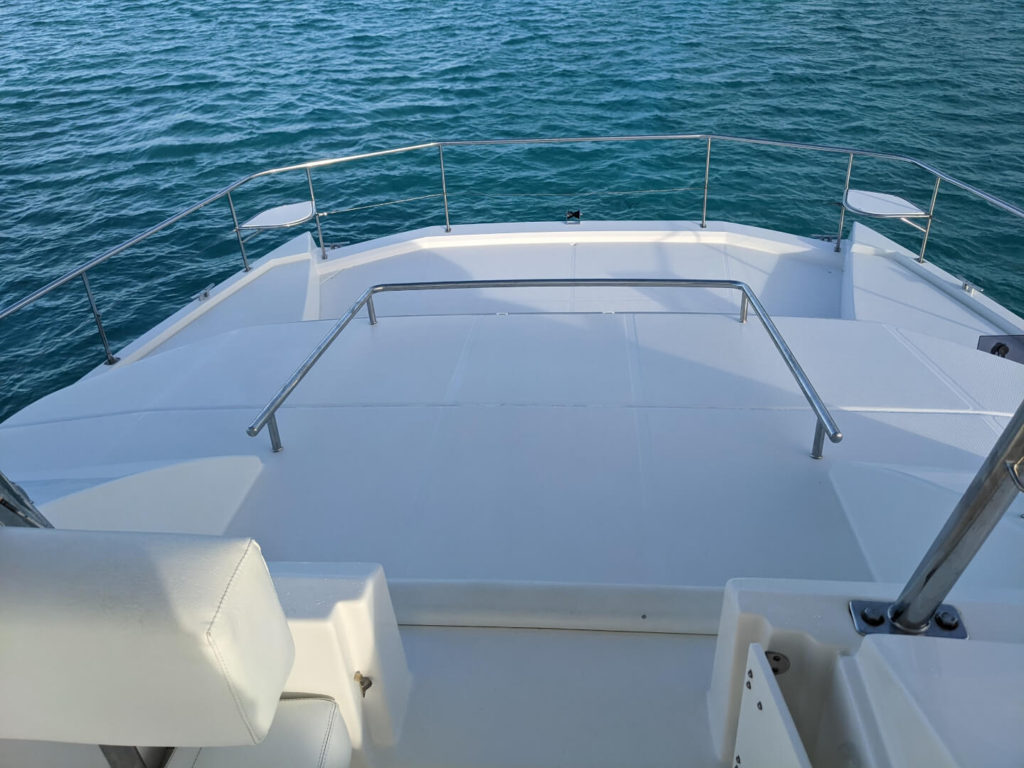

The settee cushions can all be lifted out to reveal an absolutely incredible amount of storage space. The gallon water jugs in the photos give some perspective as to the space. You could pack this with 60-70 gallons of water with space above the jugs for more. Similar storage is available below the helm seat, which we used to keep our charts, hats, and binoculars neat and dry…without the flybridge curtains, everything wanted to blow away.
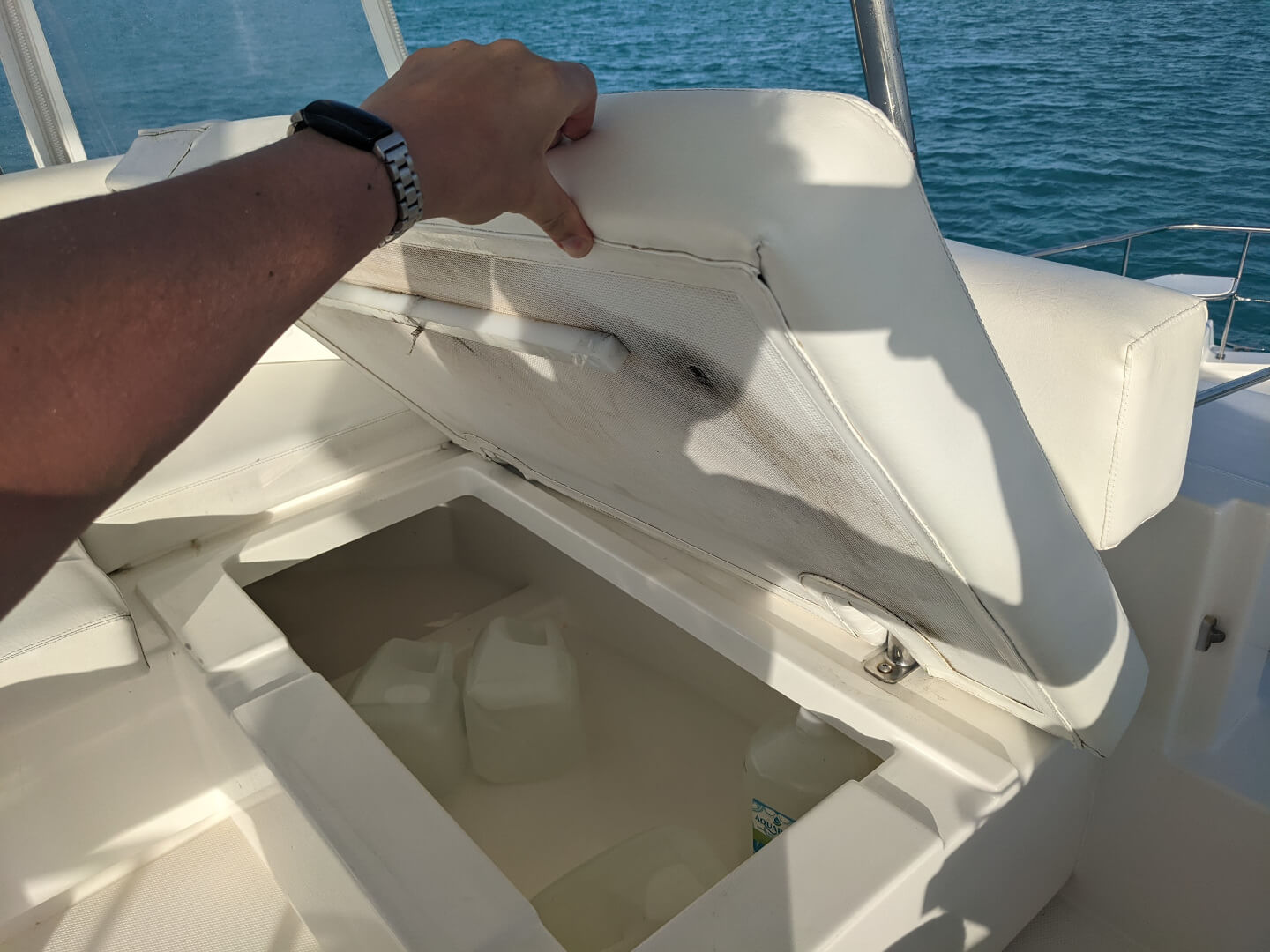
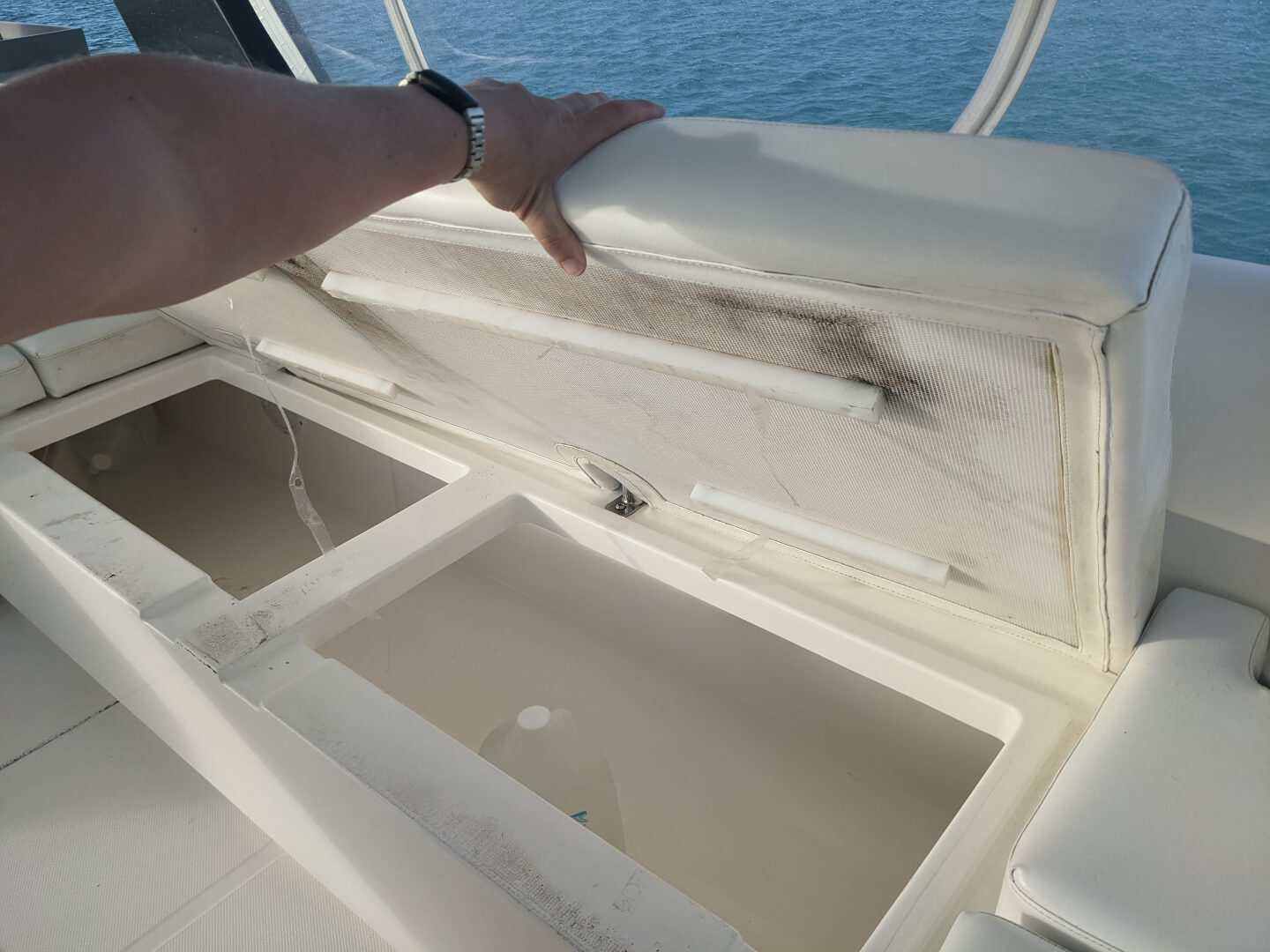
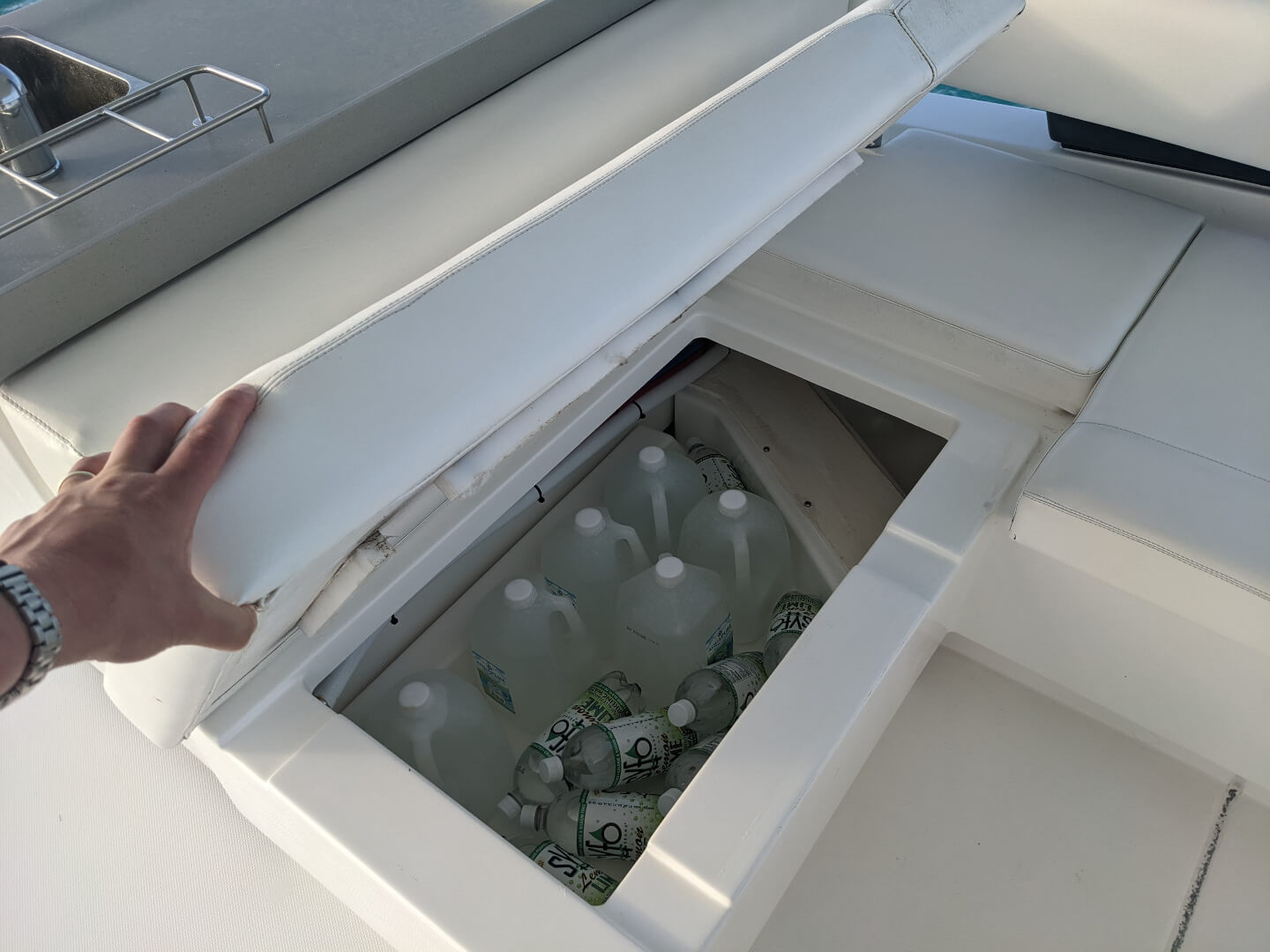
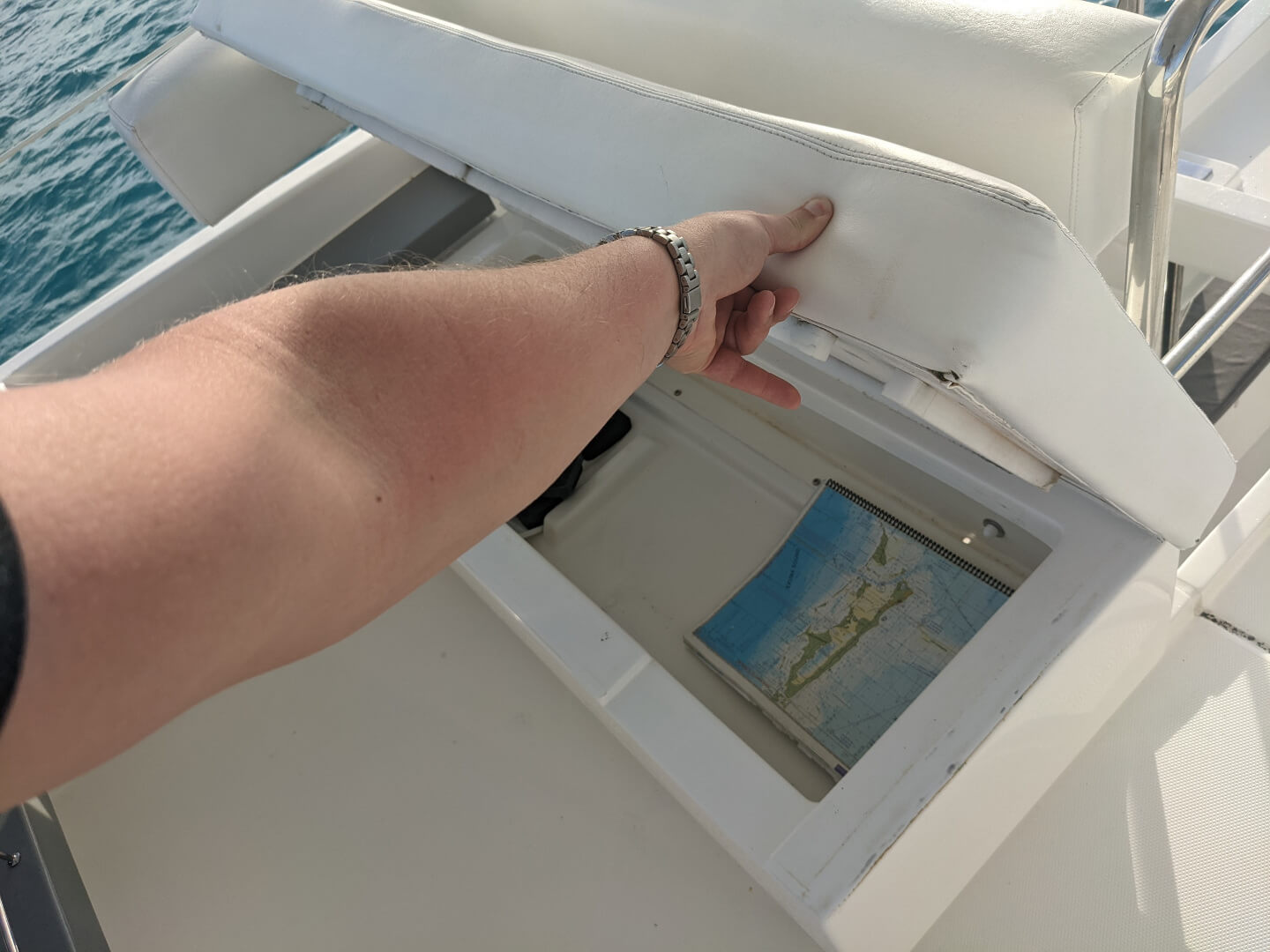
Leopard 43 Powercat Bow Area
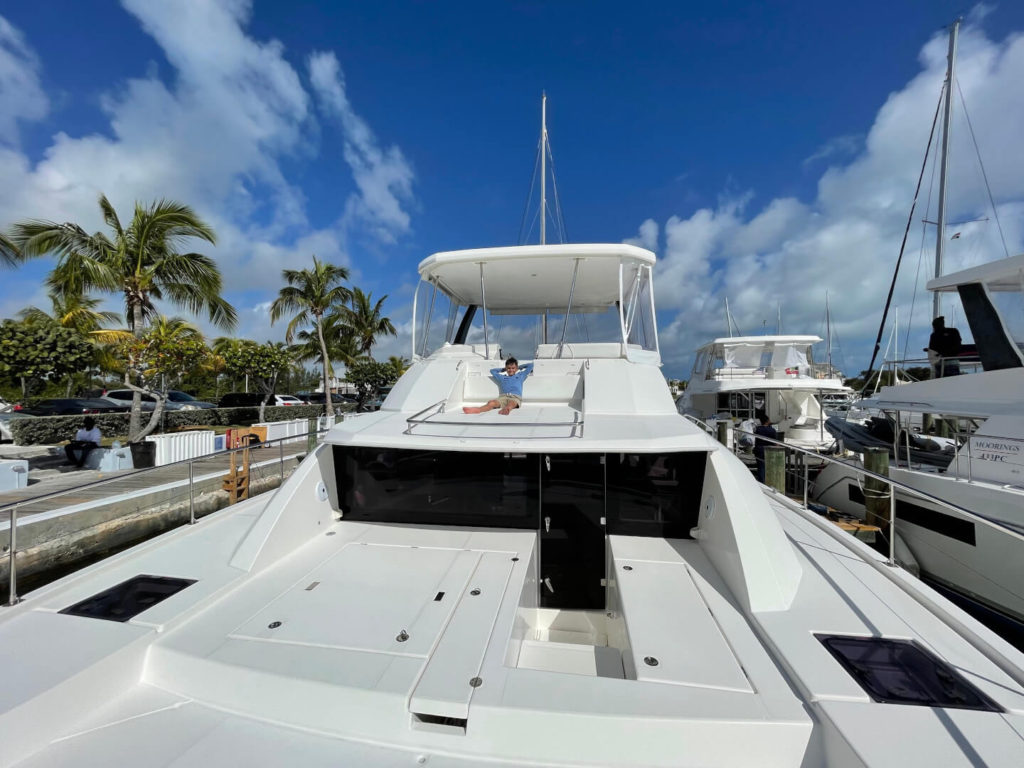
Many newer catamarans, especially power cats have eliminated the trampoline in favor of a full-length deck. The Leopard 43 Powercat follows this trend. There’s a lot of internet pontification about the dangers of stuffing the deck vs the benefits of riding the top of a wave. There’s also concerns about hull slap, which occurs when the wide deck between the catamaran pontoons gets banged by a wave. When we were in rough seas we got some very loud, crashing hull slap, but it was further aft under the salon where the trampoline wouldn’t have made a difference. We never stuffed the bow, so I can’t speak much to that, although in rough seas the fear or that giant deck going under a wave was very real.
We honestly didn’t spend much time on the bow or think much about it. However, I can’t help but think the kids would have loved laying on the trampoline and getting splashed like we did on our Lagoon 380 in the BVI.
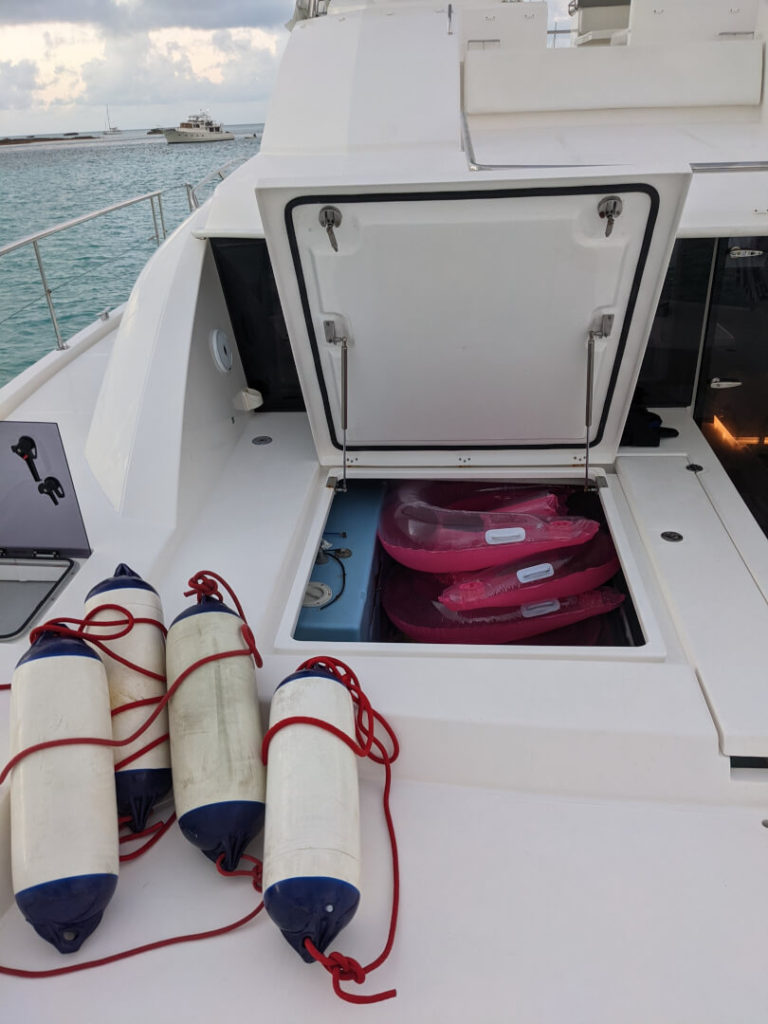
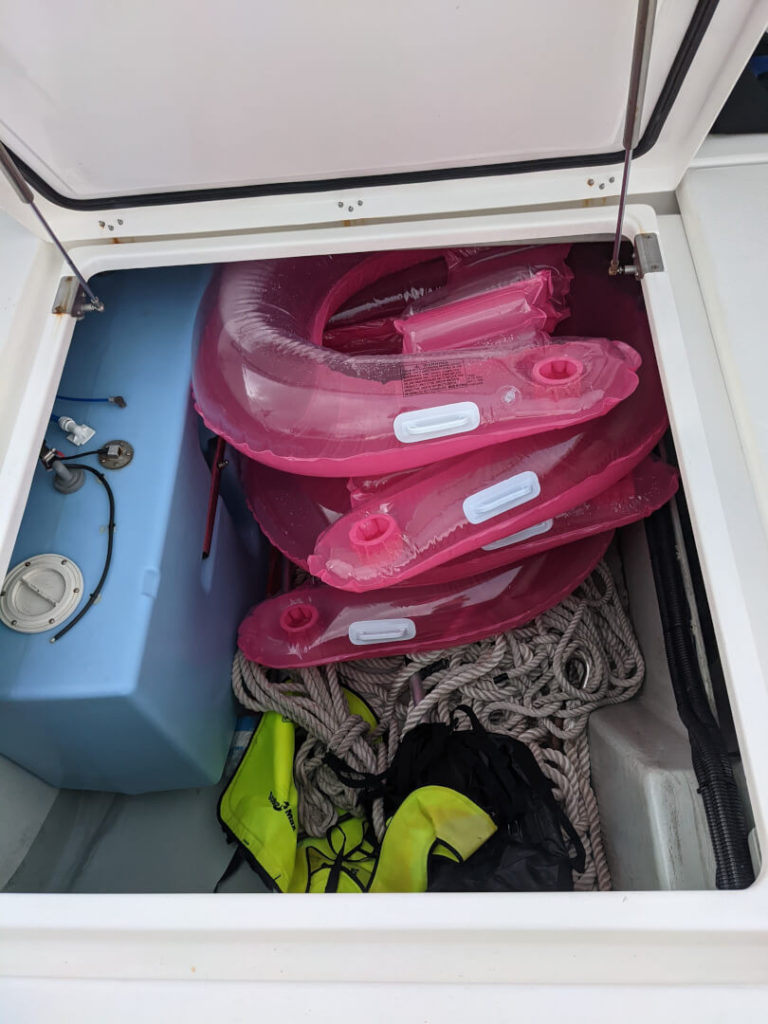
There was a HUGE storage locker in the deck that held the spare anchor, fenders, dock lines, and snorkel vests. This was a great place to throw wet toys and clothes while underway. We were able to store four large fully inflated floaties along with the secondary anchor and road, and four 8″ fenders with plenty of room for more. One of the two water tanks is located here; its translucent sides made it easy to confirm how much water remained. The other tank is is in a smaller locker on the opposite side of the steps.
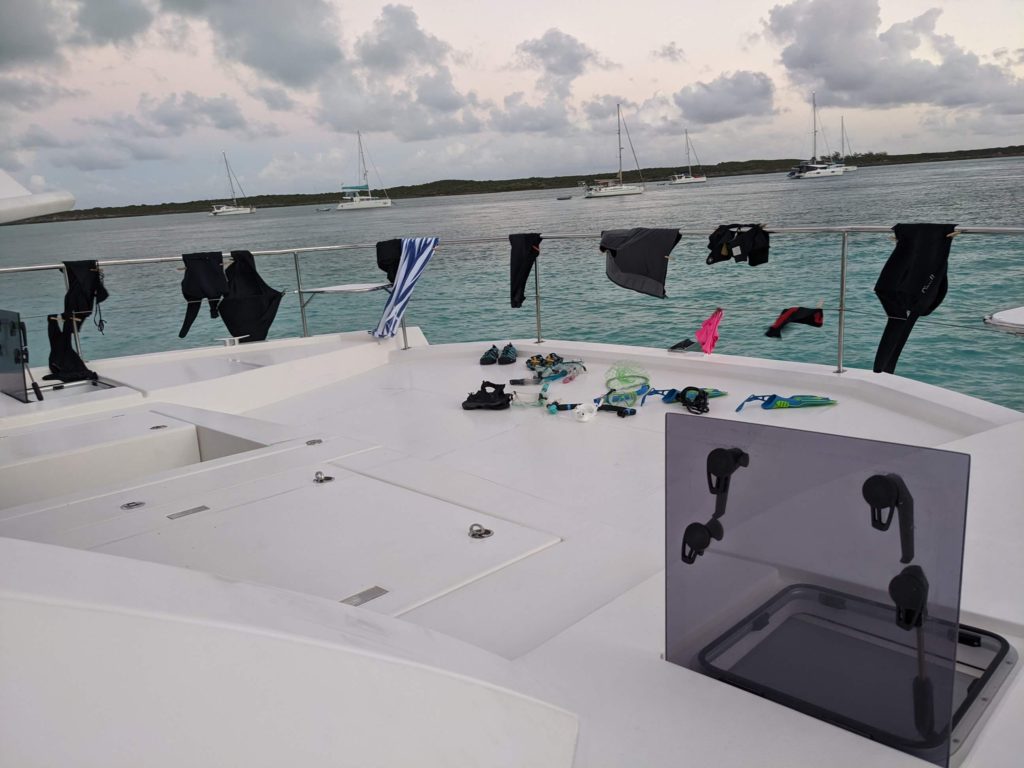
Leopard 43 Powercat Cockpit
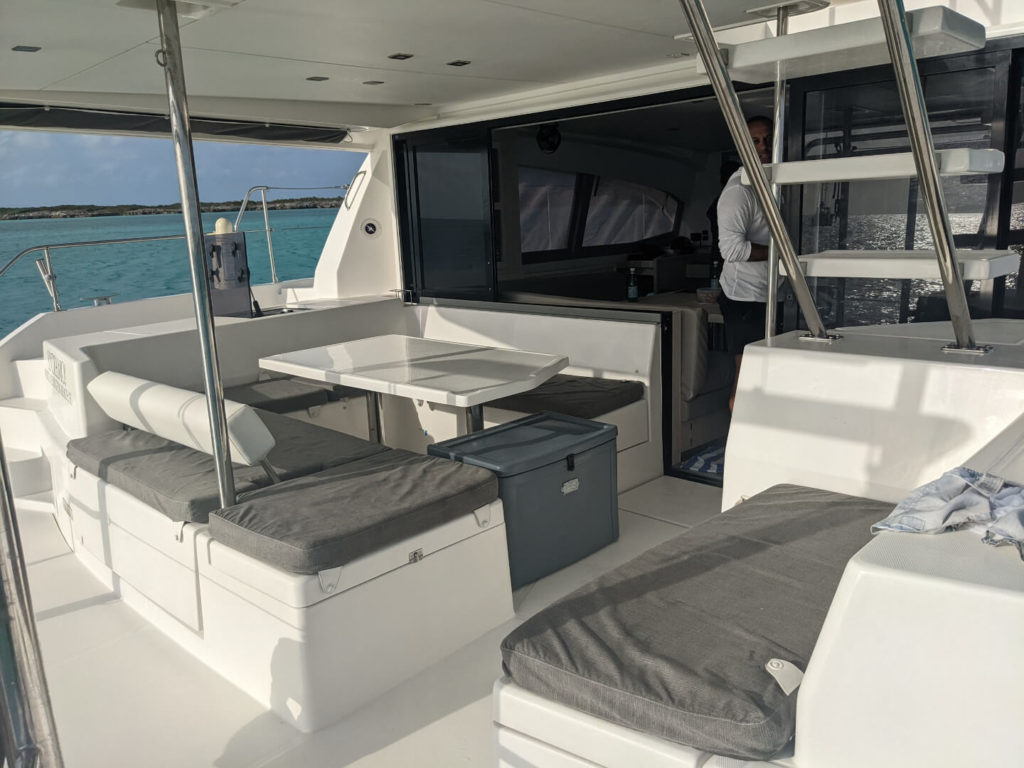
The cockpit (rear seating area) on the Leopard 43 Powercat cockpit has yet another roomy U-shaped settee (couch) and dining table. This setting accommodates a larger crowd than the salon. The settee has fitted bottom cushions, but fiberglass backs. It is a bit easier to slide in and out of a crowded table because you can climb out onto the deck from the rear of the bench. The rearmost bench has a movable seatback that can be reversed; this allows your mates to sit facing the stern while at anchored.
The forward part of the bench can be lifted to reveal a large storage, along with the batteries. The rear bench holds the life raft and shorepower equipment on one side and a drained storage locker on the other. Our yacht had dinghy pump and inflatable life jackets stowed in the drained locker. This seemed logical, but the inflate handles on the jackets can get stuck in the large drain holes. When pulling the jackets out, one of them blew with my head in the locker…very startling!
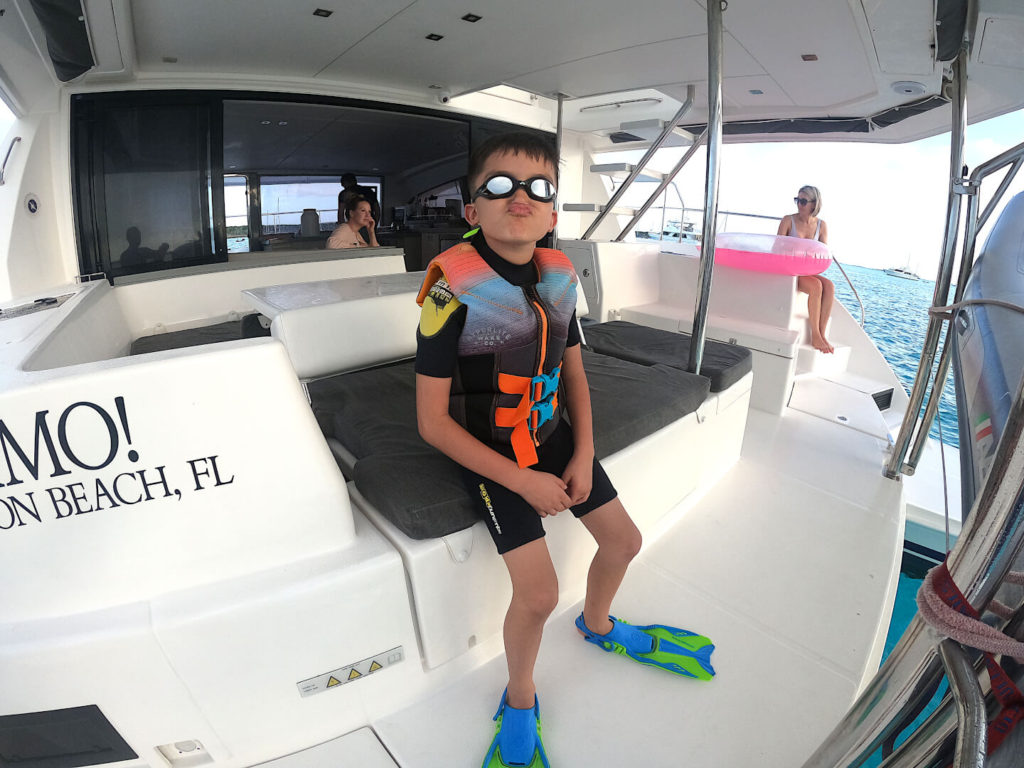
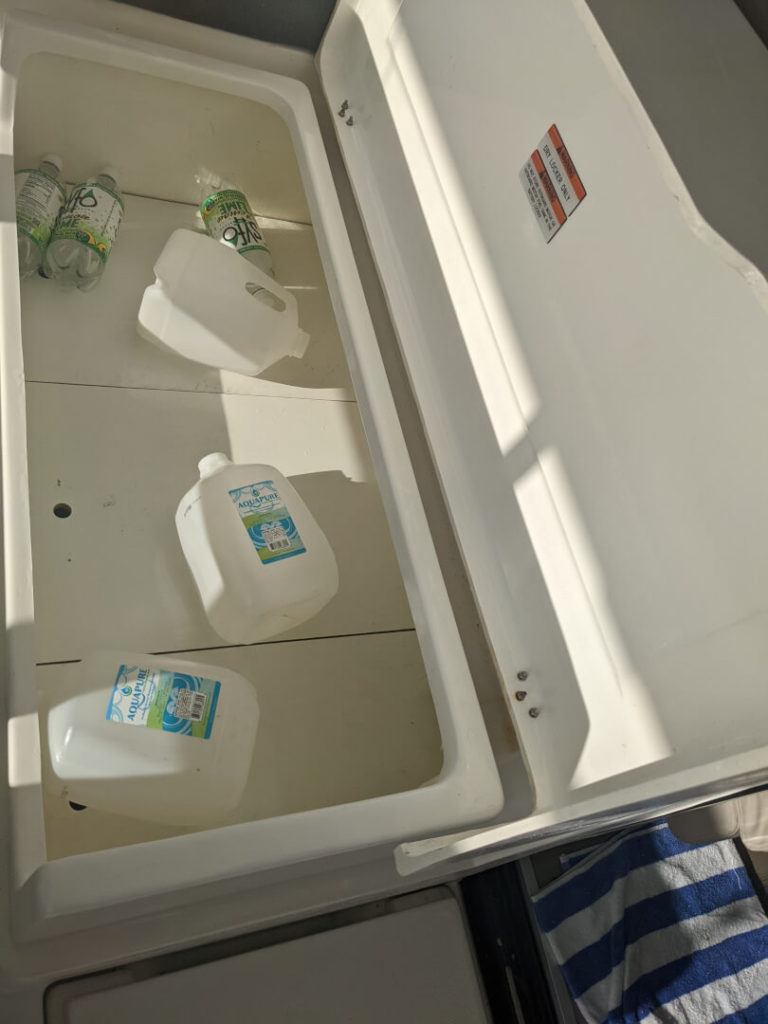
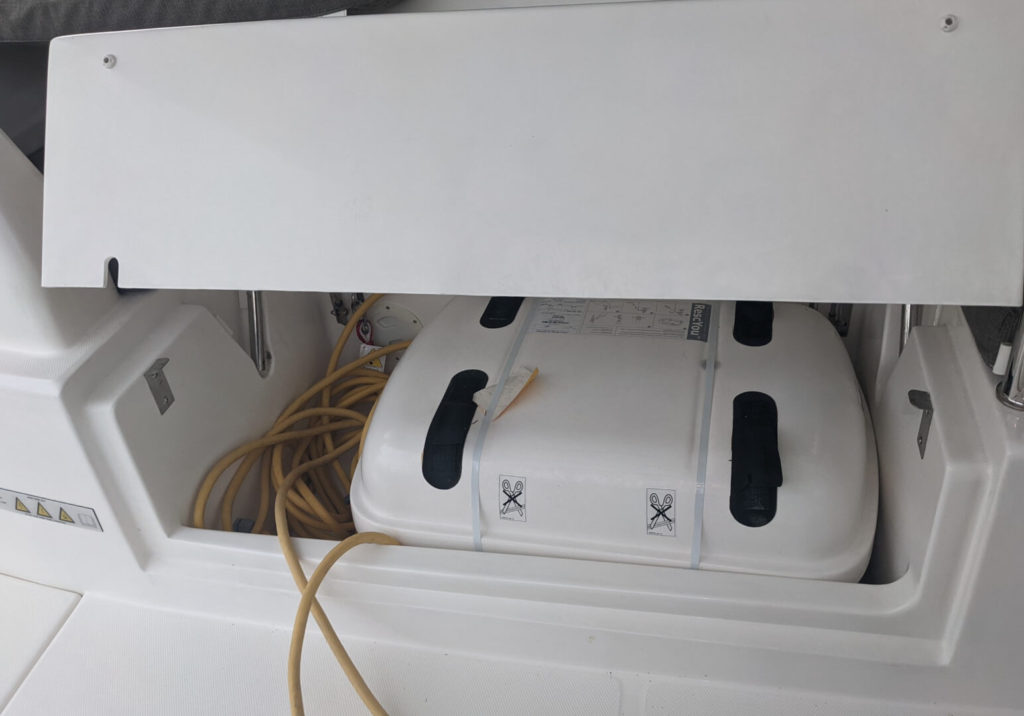
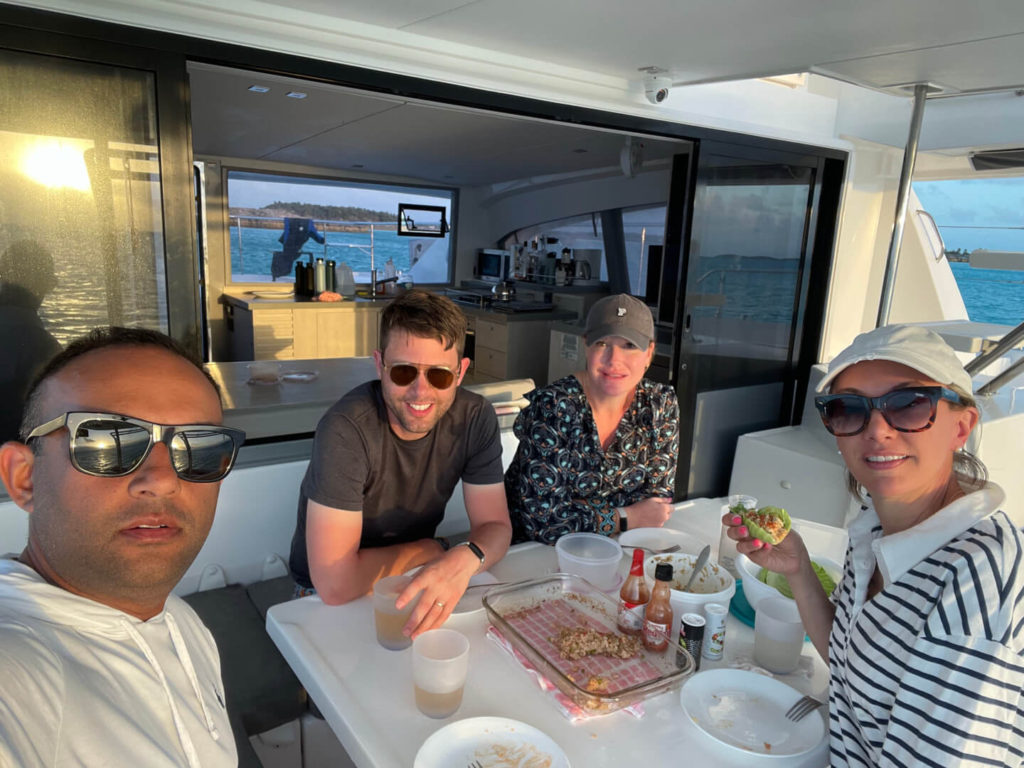
Another locker next to the life raft was used to store life jackets on our yacht; this locker has drains which is nice for this sort of thing, but the drains are large enough that one of the inflation handles got stuck and scared the shit out of me when I pulled it out and caused it to inflate with my head in the locker. Fortunately, there were a dozen or so rearming kits under the salon bench, so I was able to re-arm this one along with a few other vests that he been pre-inflated prior to us taking delivery of the yacht.
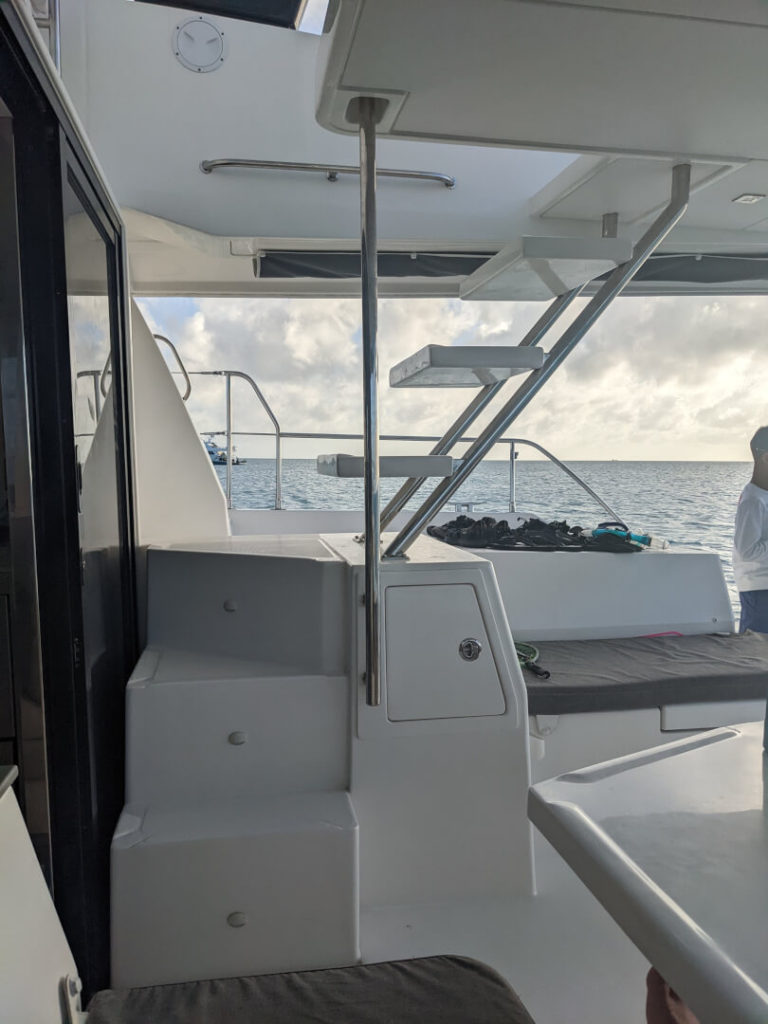
Opposite the settee you’ll find stairs leading to the flybridge. Under the stairs is a small bench that stores two propane tanks beneath.
The dinghy hangs from a davit between the hulls at the stern. An electric cable windlass is used to raise and lower it. In rough seas it can really get to swinging, so we used the dinghy painter (rope on the bow) to tie it more securely against the davit hardware. This is the most convenient dinghy stowage system that I’ve ever used.
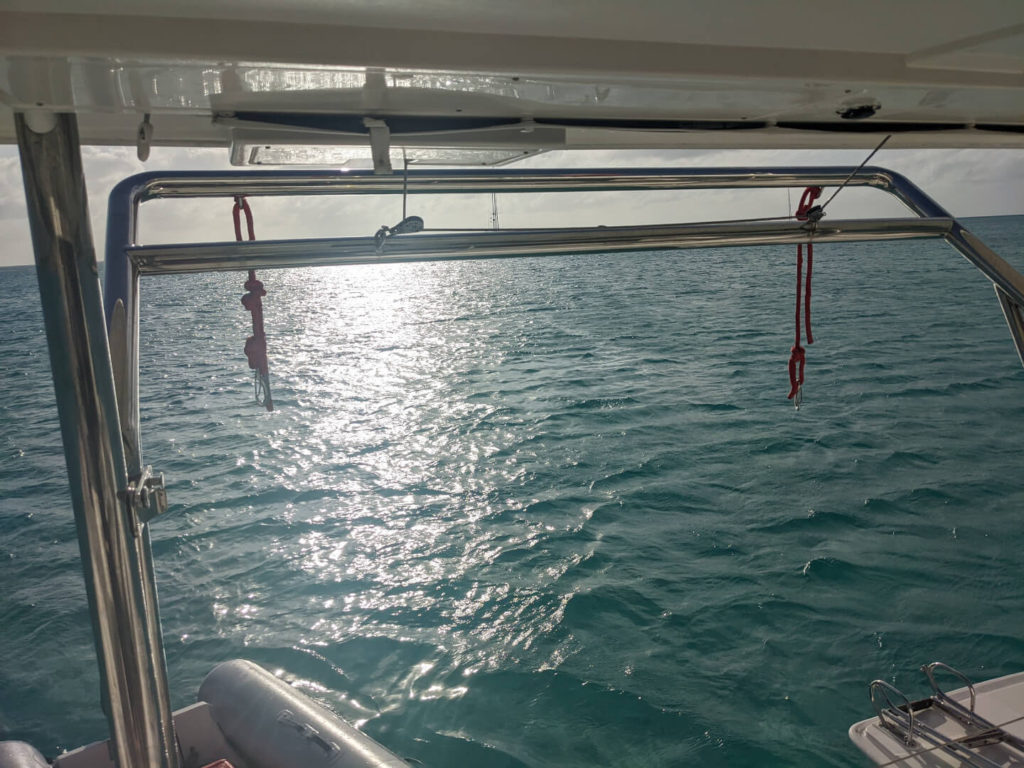
Stairs on either side of the stern lead down to a 3′ swim platform that makes up the Leopard 43 Powercat three feet longer than the Leopard 40 sailing cat. The swim platforms are welcome as they make it easier to board the dinghy. They also contribute to a straighter prop shaft that we discussed earlier, and likely help maintain a natural trim when running at higher speeds.
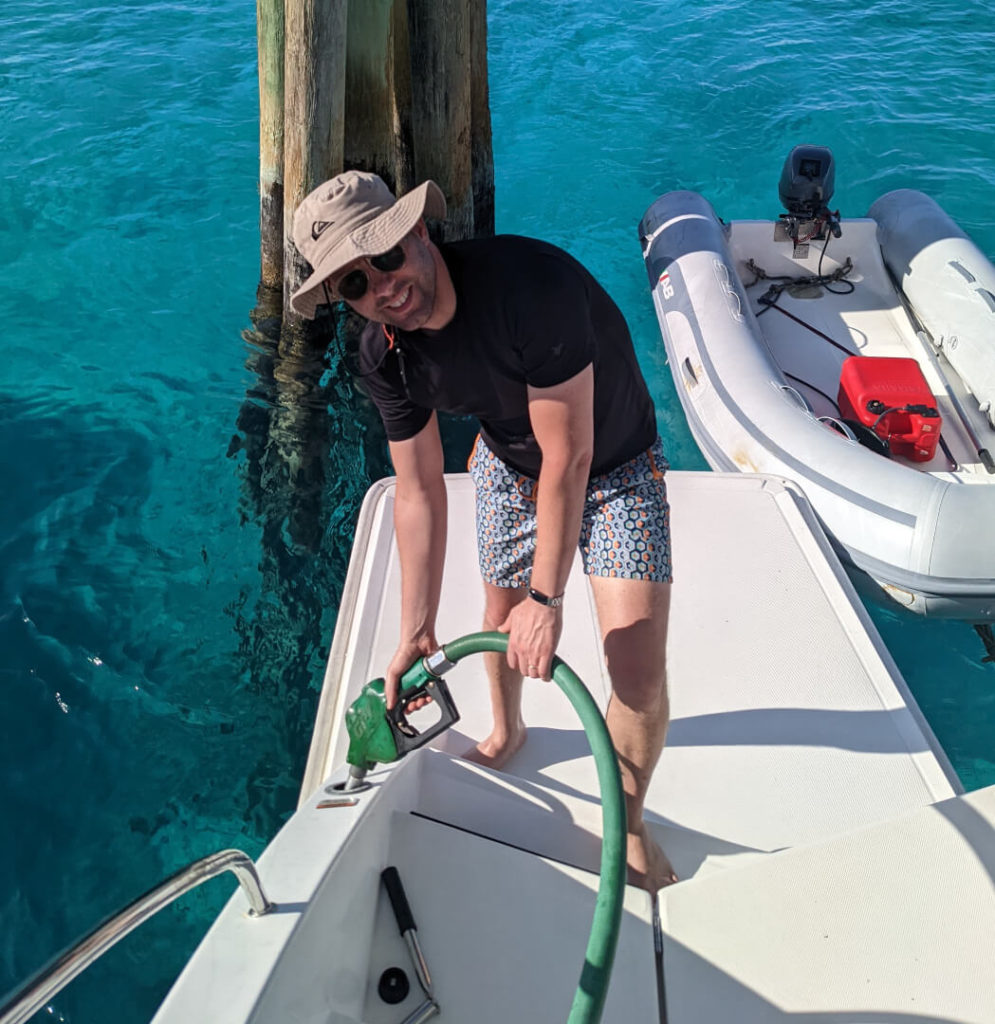
Half-way up the outboard side of the steps on either side is the diesel fill. These are positioned directly above the tanks so they are less likely to get backed up and barf petrochemicals all over your yacht and the sea. Nonetheless, its always helpful to have an idea of how much fuel you need and watch the meter so you can slow down when you think you are getting close. Our yacht did not come with oil absorbing diapers, which are nice to hold around the nozzle in case there’s a spill.
Below the steps on each stern, there was a ‘lazarette’ with even more huge storage areas. The starboard (right) side was wide open, while the hot water heater and generator were mounted in the port (left side).
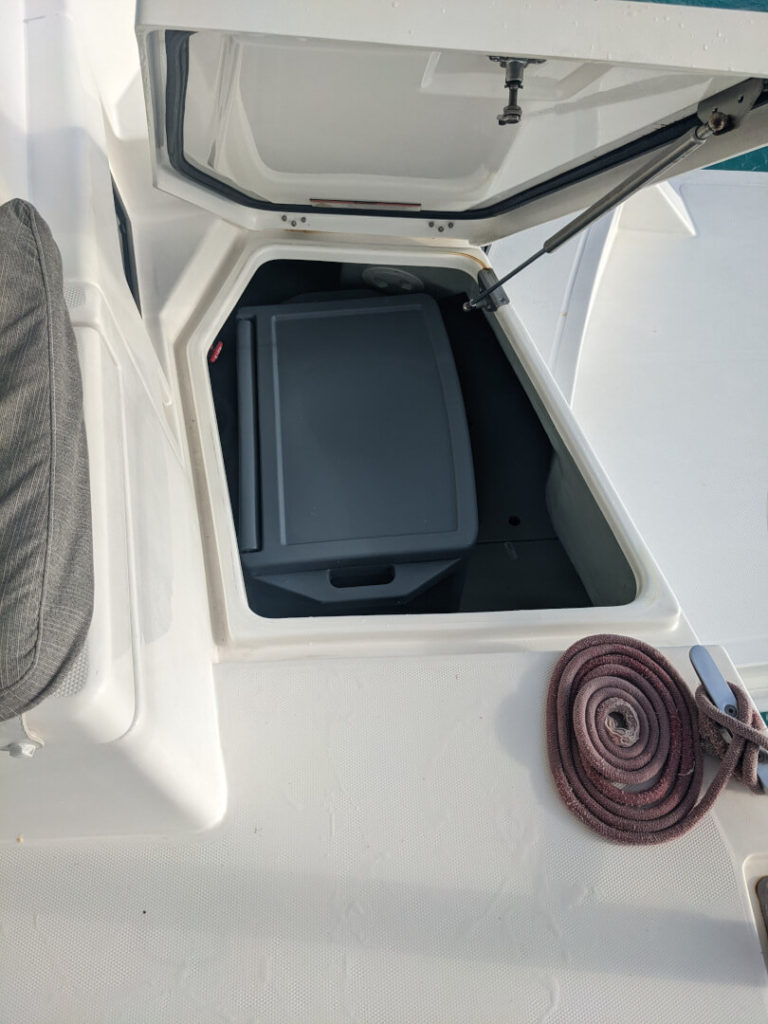
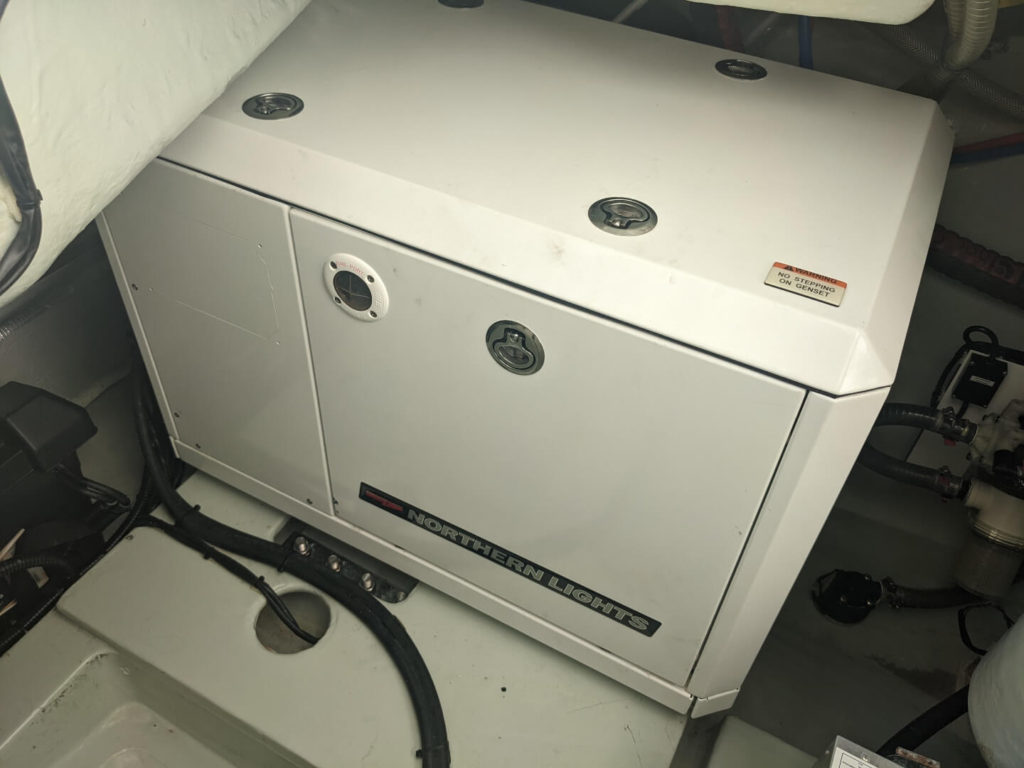
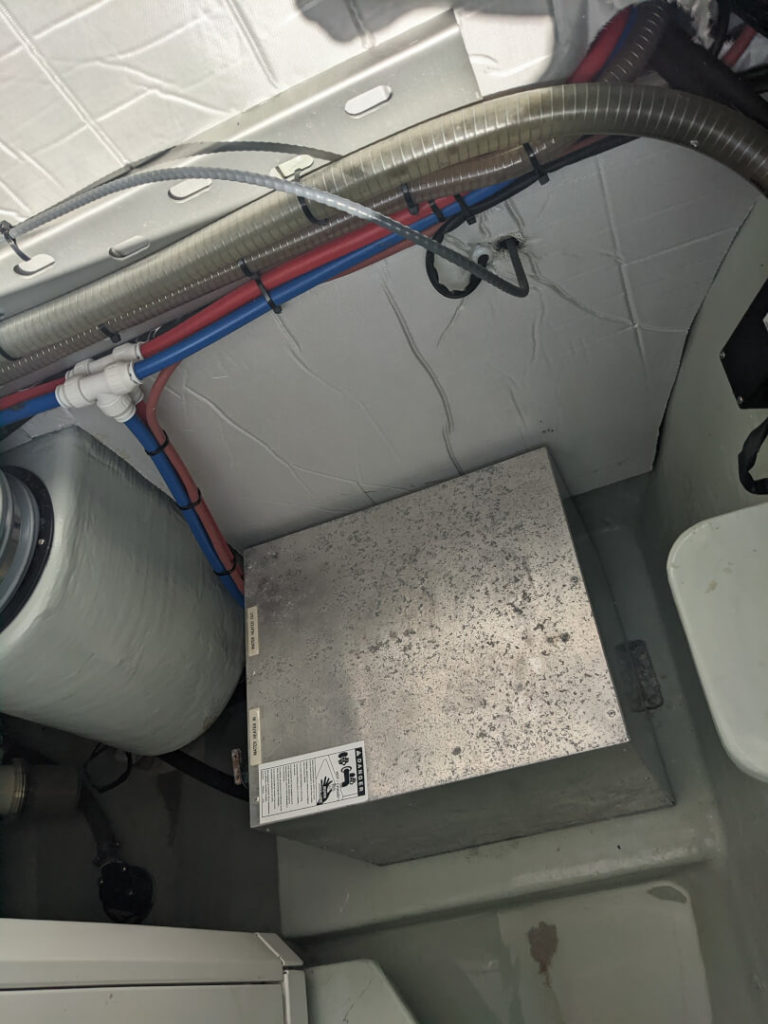
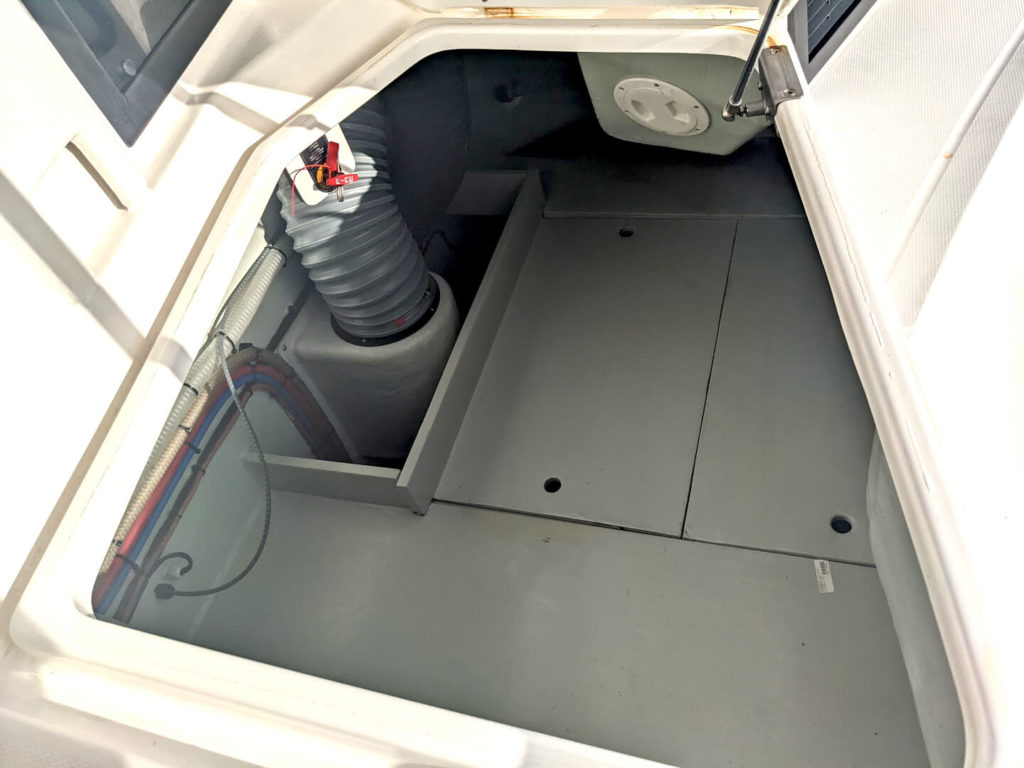
Leopard 43 Powercat Side Decks
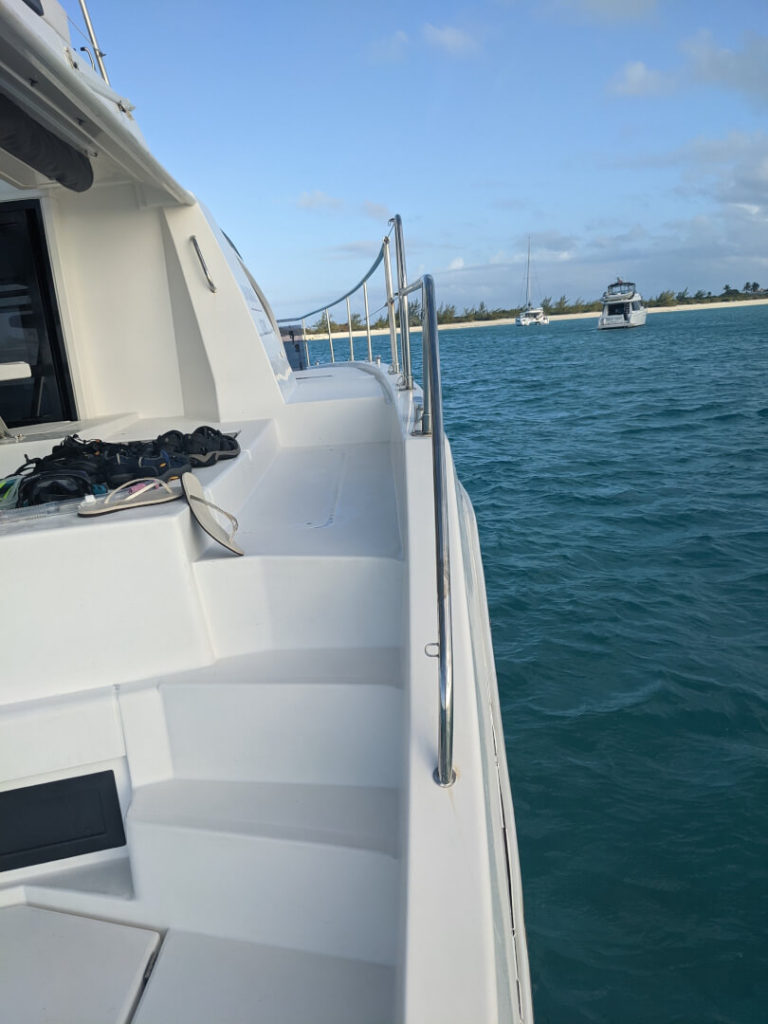
You will never fret getting from the stern to bow on the Leopard 43 Powercat. In addition to being able to walk through the salon, there are generous side decks wide enough to accommodate an above average American without shimying sideways. The decks are flat with solid full inch thick, tall stainless railings. This is a huge improvement over the tight, tilted gunwales protected by loose, low, frayed wire lifelines often found on sailing monohulls. We also found three very large and sturdy cleats along each side of the yacht capable of holding plenty of line for the most hamfisted of attempts to secure this thing to a dock.
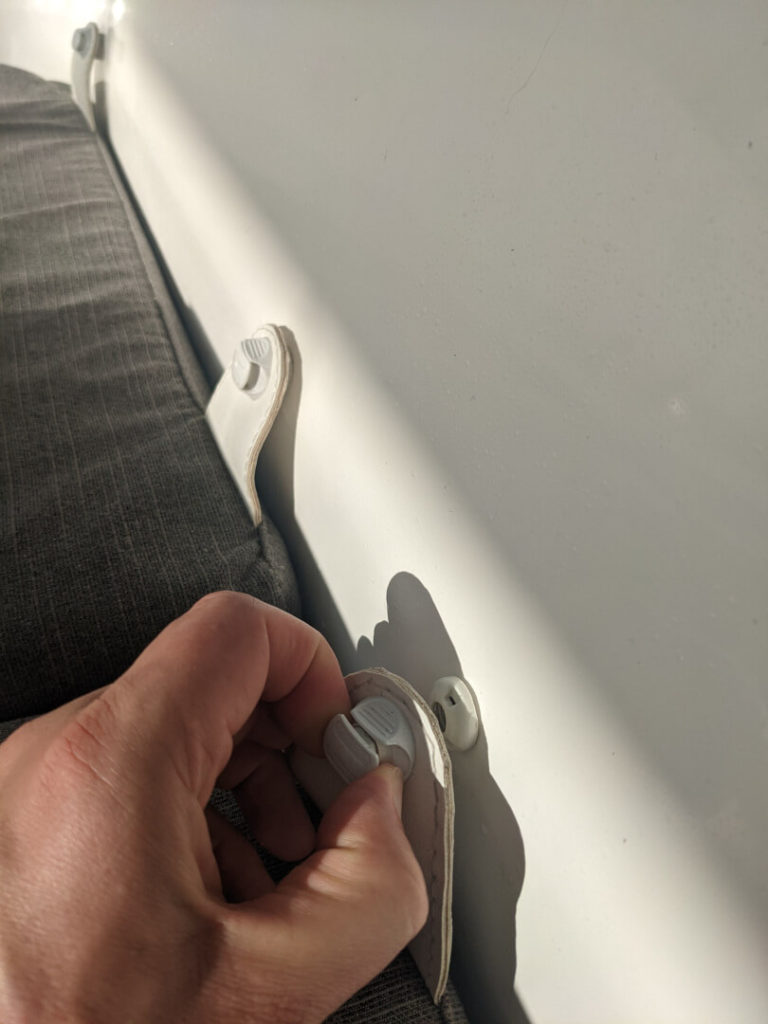
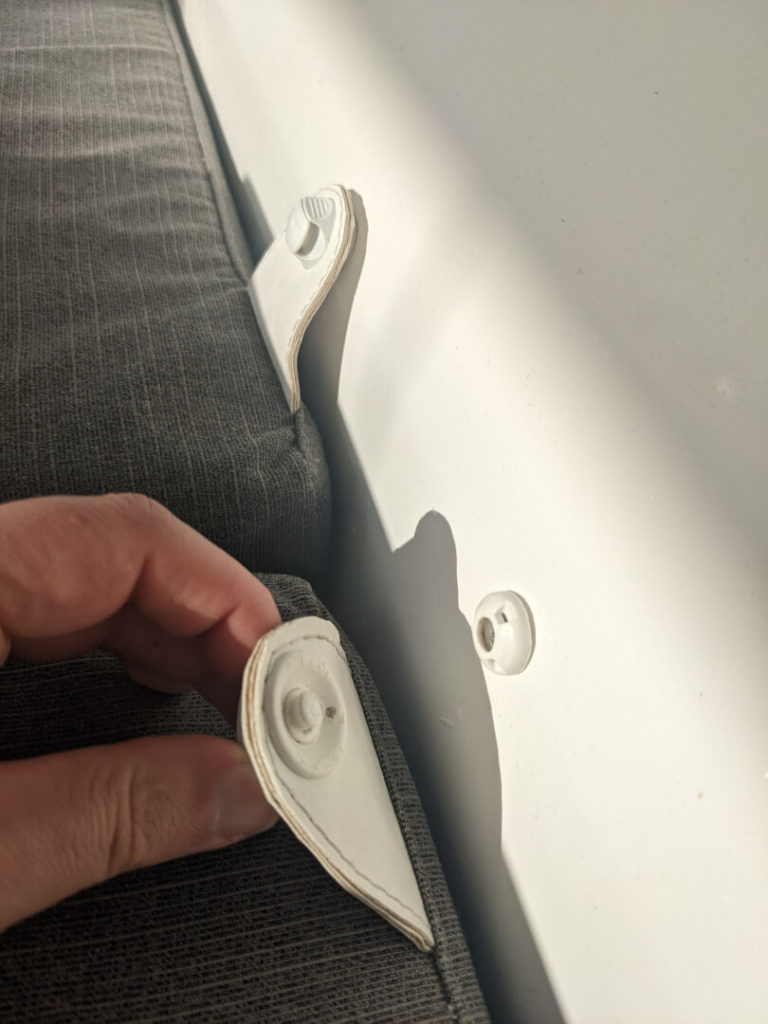
The yacht comes equipped with mesh shades over the side windows that can be rolled up. We snapped them down before leaving port knowing that they would help keep the yacht cool. The snaps are these finicky little plastic things that require patience and world class dexterity to install. The same snaps also secured the cockpit cushions. If you needed justification to bring kids along on your voyage, this is it.
Salon on the Leopard 43 Powercat
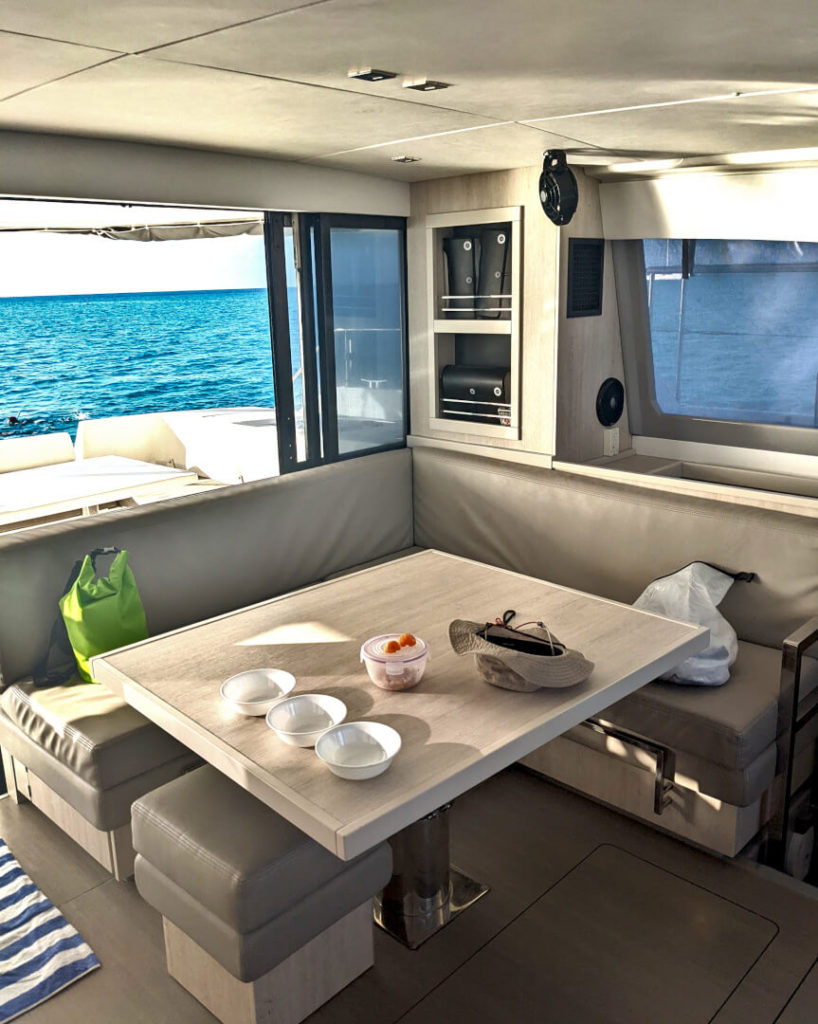
Older cruising catamarans, and many performance-oriented catamarans, have a sloped salon roof making for a marginally useful area forward. However, the Leopard 43 Powercat has a full height salon with vertical windows forward and a door to access the bow. The door is a great way to allow open up a cross breeze while at anchor or on a buoy since you’ll have wind coming off the bow. Careful heading for the bow too quickly though, Abby the Giraffe bonked her head on the flybridge floor on her way up the steps…right in front of the checkout skipper, causing a commotion that certainly gave him pause. The door has a tight seal with three locks; there are two detents, allowing the door to be cracked for ventilation. Be sure to double check this is closed all the way before getting under way if you prefer your cabin dry.
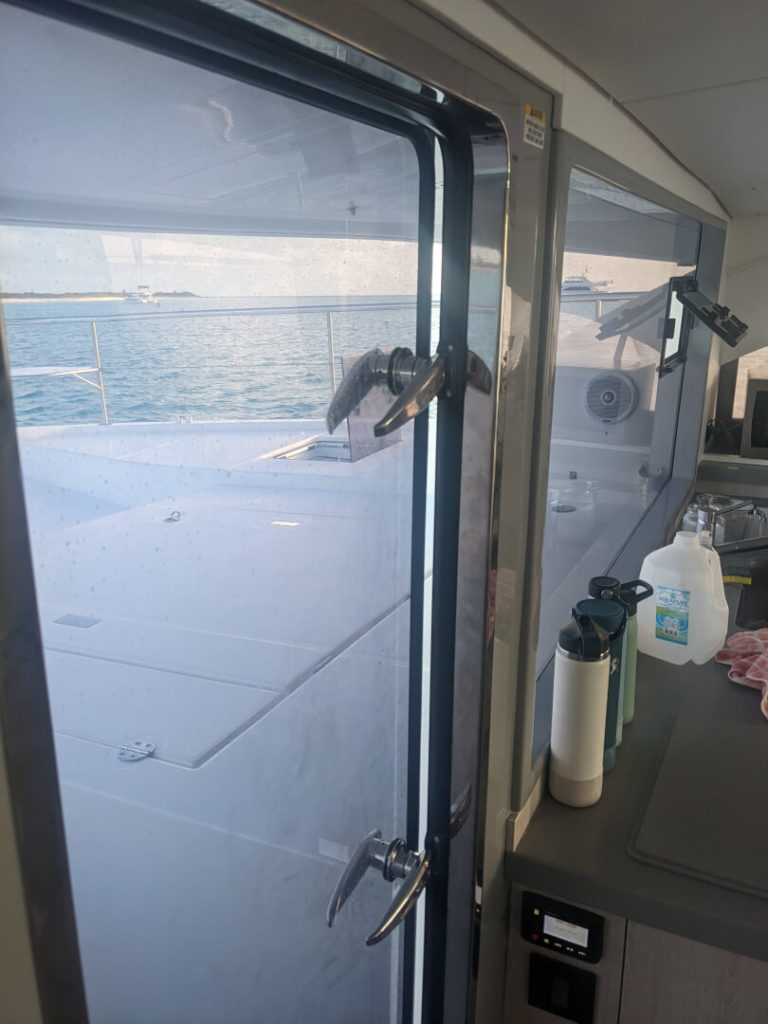
The salon has an L-shaped settee with a table that can be lowered to convert into a generously sized bed. Our 12 year-old slept here comfortably all week without ever executing the conversion. Getting in and out of the bench during dinner service can be a hassle. There are also two stools with storage underneath that can be set on the open side of the table to increase capacity or minimize in/out climbing. The windows between the salon and the cockpit slide open without any framing between that and the companionway door. This offers connection for crew sitting on either side, or just letting in a breeze.
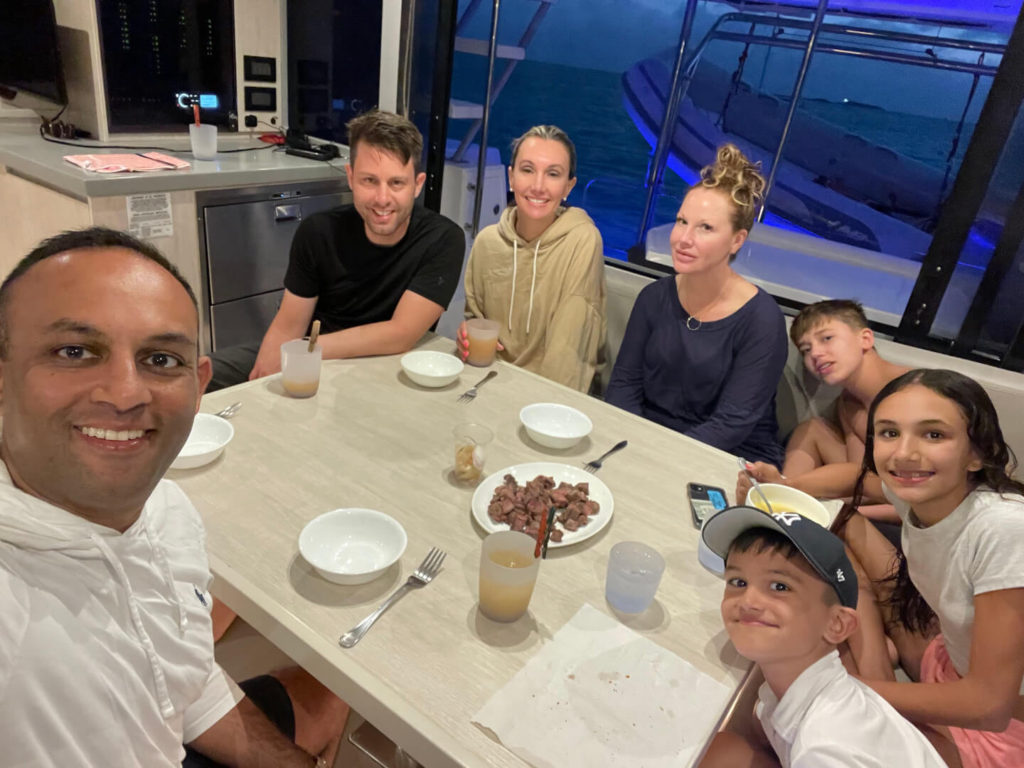
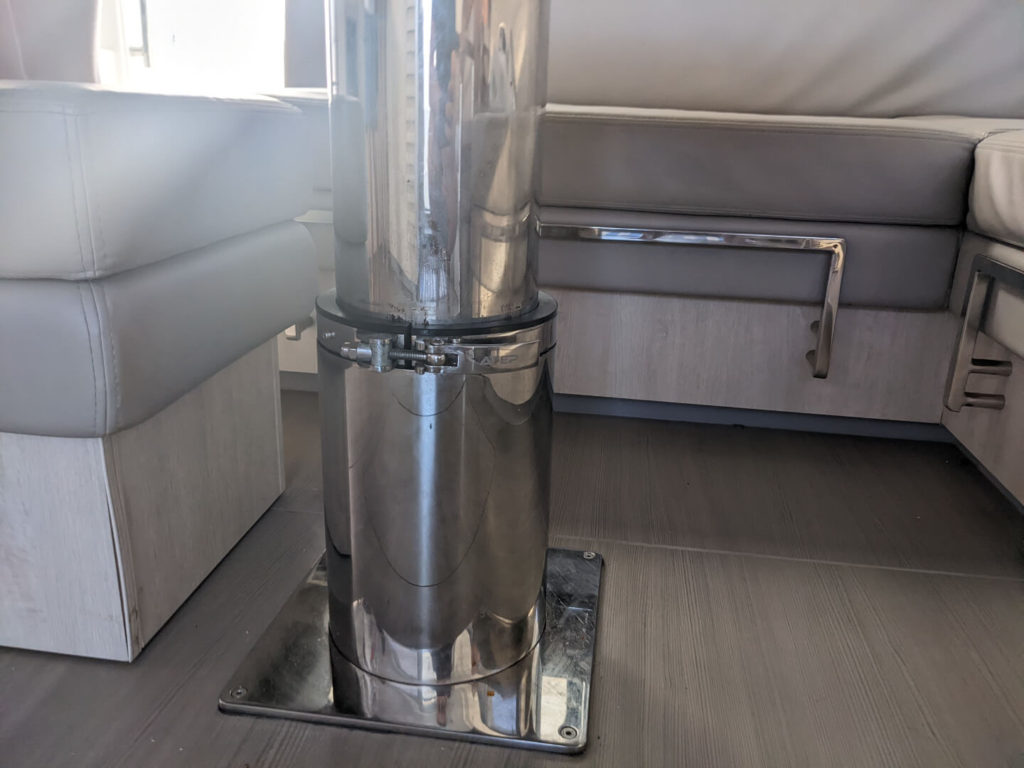
Across from the settee, next to the companionway door is the electrical panel. Behind the glass door, in addition to the circuit breakers is the controls for the air conditioner, watermaker (if equipped), VHF, generator, and stereo. Remote stereo controls are also mounted on the flybridge and next to the forward salon door so you don’t have to dive in there to tinker…although you’ll probably use blueteeth to run tunes from your phone and only need to access the volume settings after the initial paring, which was easy…don’t forget to download a solid playlist before leaving home in case you have limited internet access on your voyage.
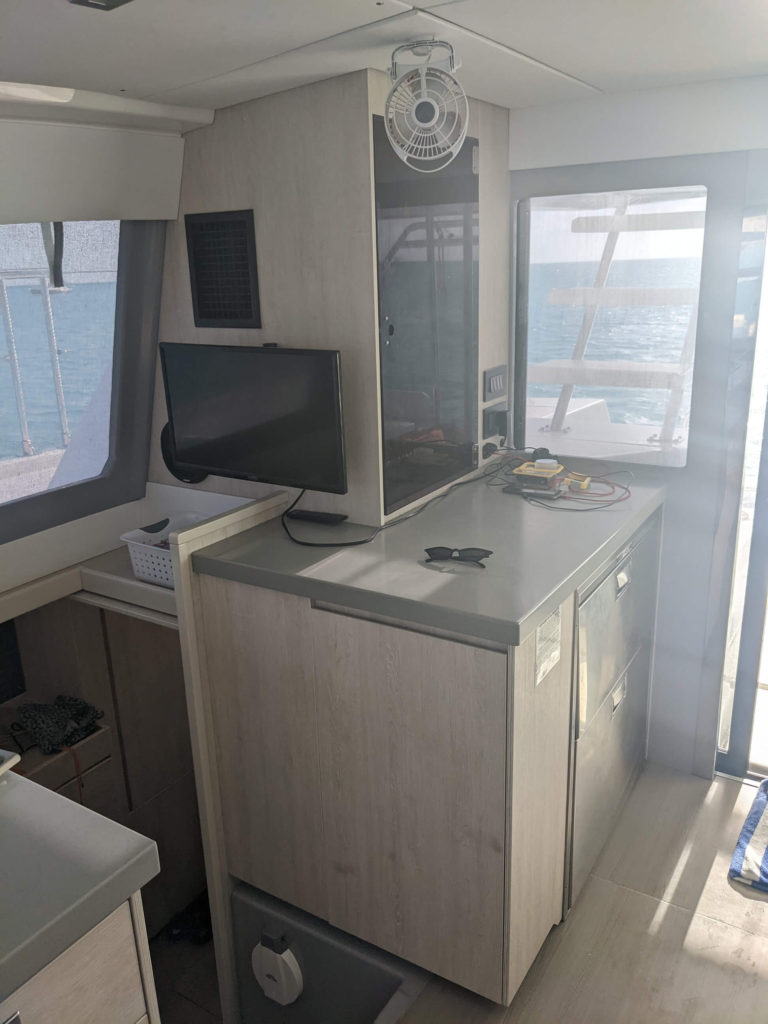
In the final corner of the salon area, forward/starboard, there’s a navigation table with storage below. There’s also a deep long ledge over the living space below that’s great for holding random crap like binoculars, eyeglasses, and water bottles and for charging phones and cameras. There is a set USB and 120v outlets here as well as next to the electrical panel. The USB outlets work without the genset, the 120v do not as the yacht is not equipped with an inverter. With the helm on the flybridge, it isn’t easy to go back and forth to check charts while under way.
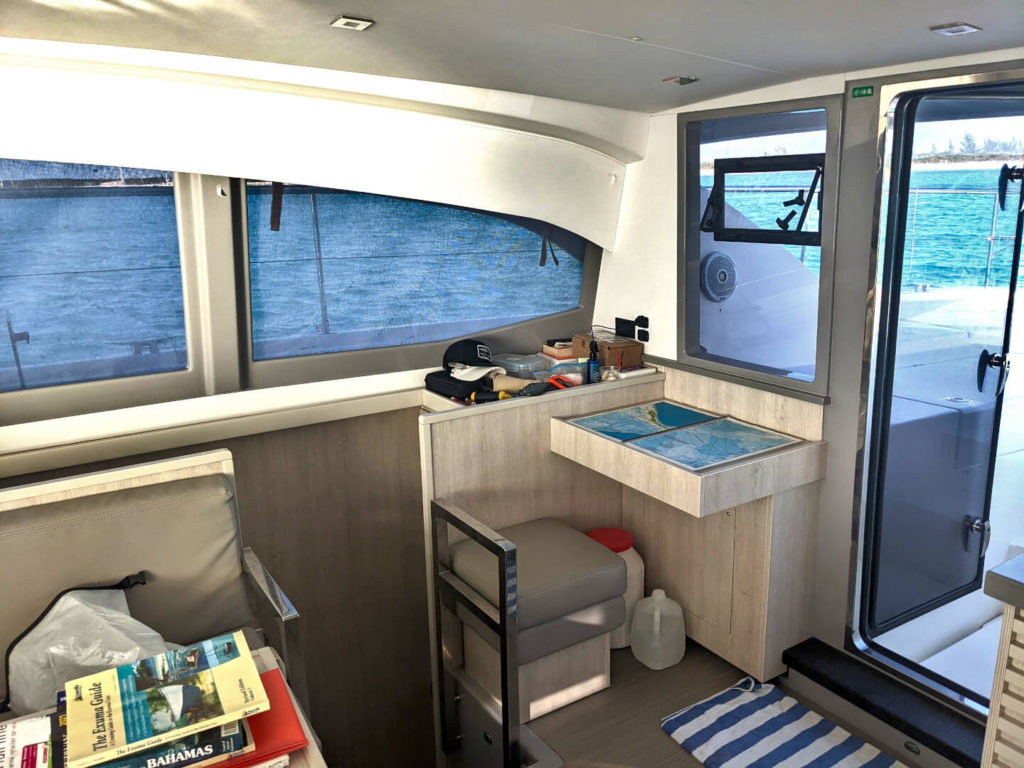
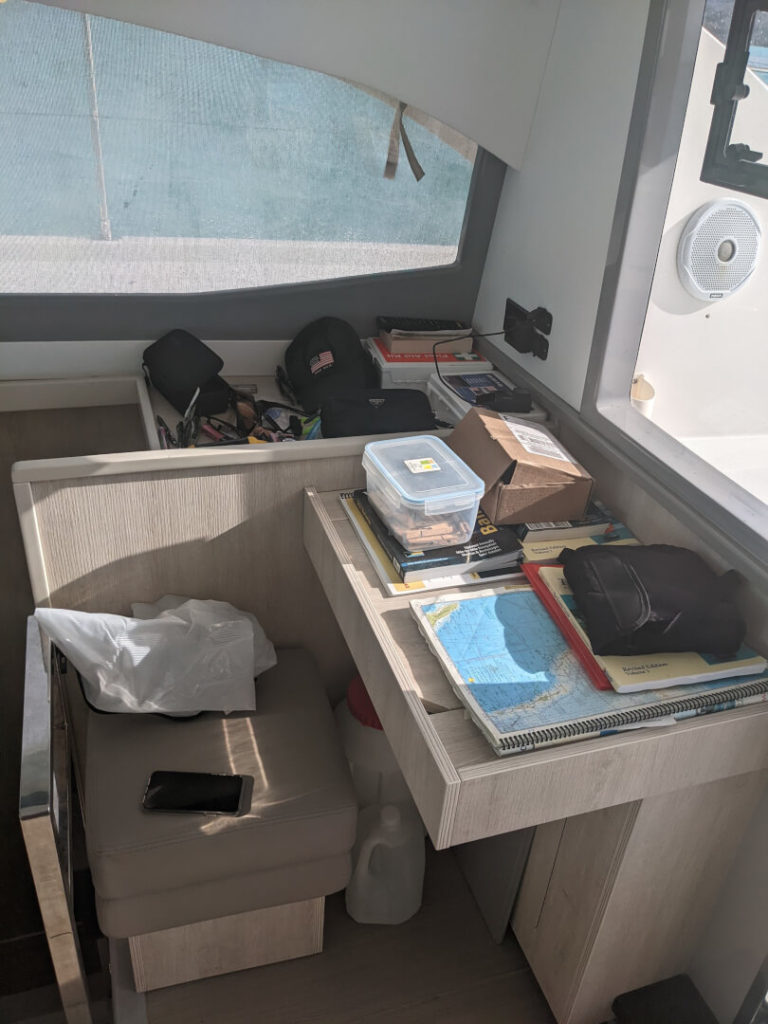
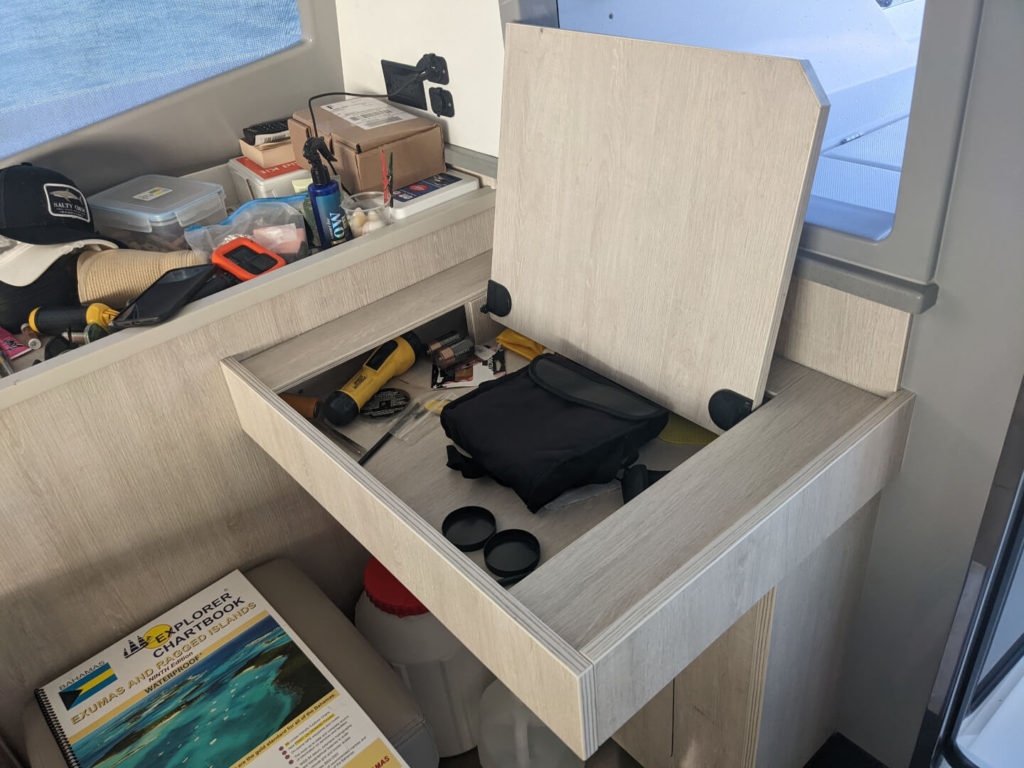
Living Quarters on the Leopard 43 Powercat
The Leopard 43 Powercat comes in two floorplans: the 433 PC is a three stateroom, sometimes called an owner’s layout, as well as a four-stateroom plan, called the 434 PC. The port (left) hull of the 433 has two staterooms fore and aft with a head (bathroom) in between. The starboard (right) hull of the 433 is configured as an “owner’s suite” with a bed at the stern, a larger bathroom forward, and a ‘get ready’ area in the center. In the 434, both hulls are equipped like the port hull in the 433PC, making a four stateroom, two head layout.
Port Living Quarters
When choosing the forward vs aft cabins, each has their advantages. The aft stateroom has a bed with full width end to end and a generous closet. Slightly smaller than a queen mattress, there was ample room for two adults, even if its too hot to get cozy. With the engine beneath the bed and the generator behind the bed, if you aren’t the first to wake up each morning, you’ll be the second.
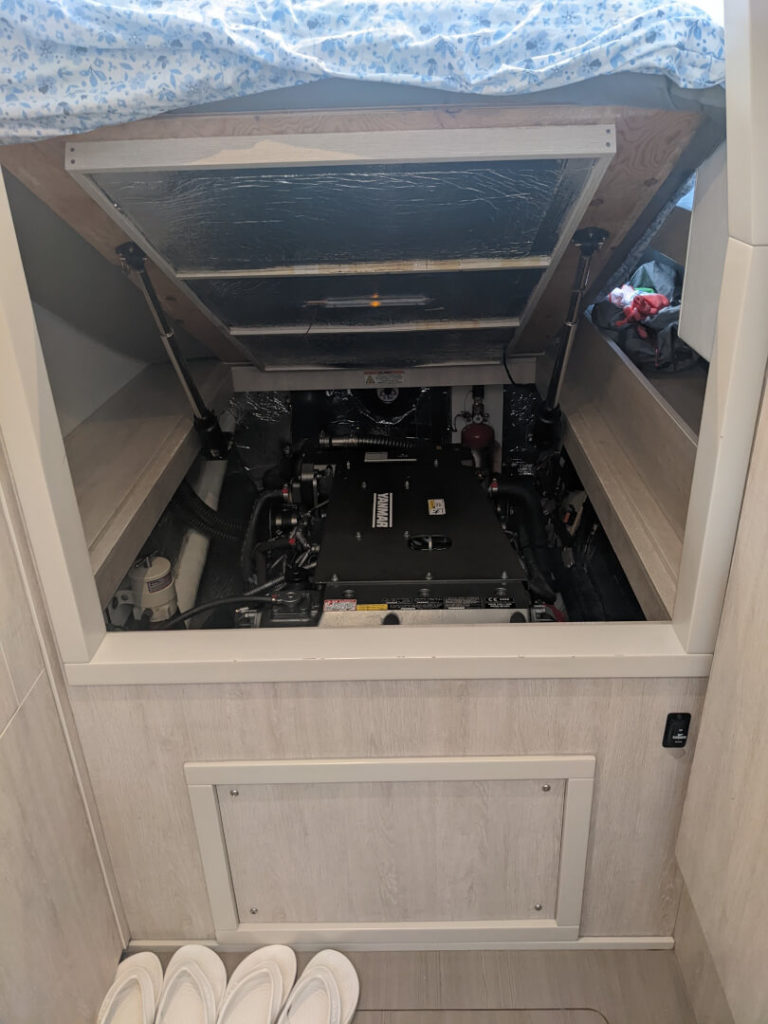
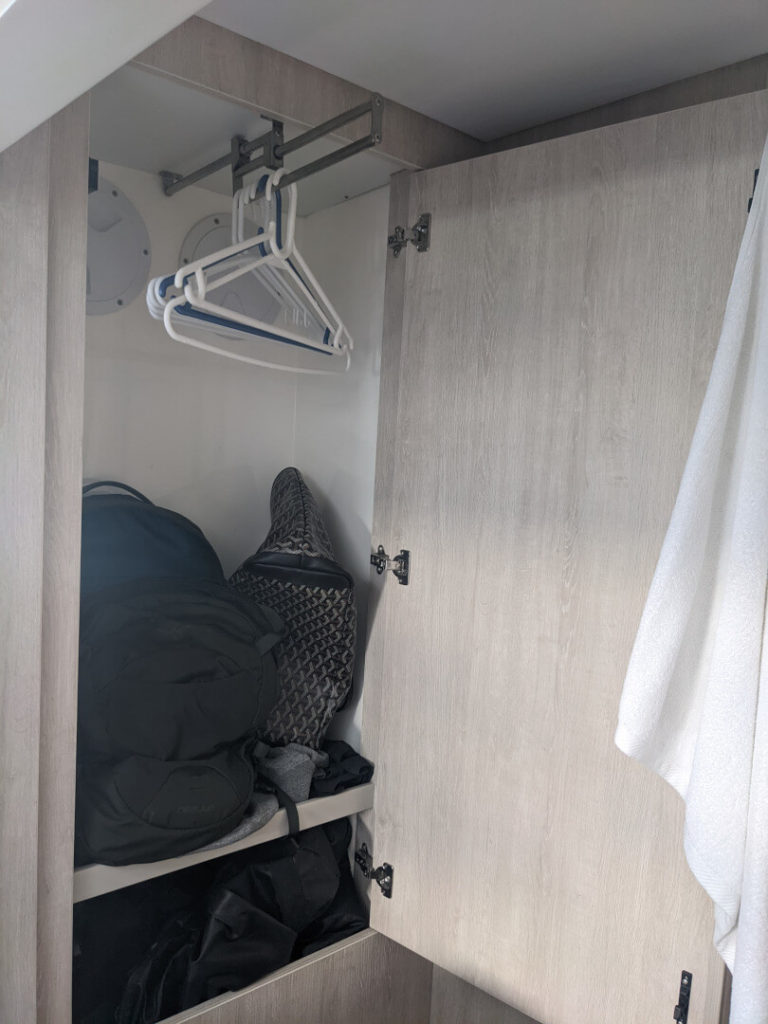
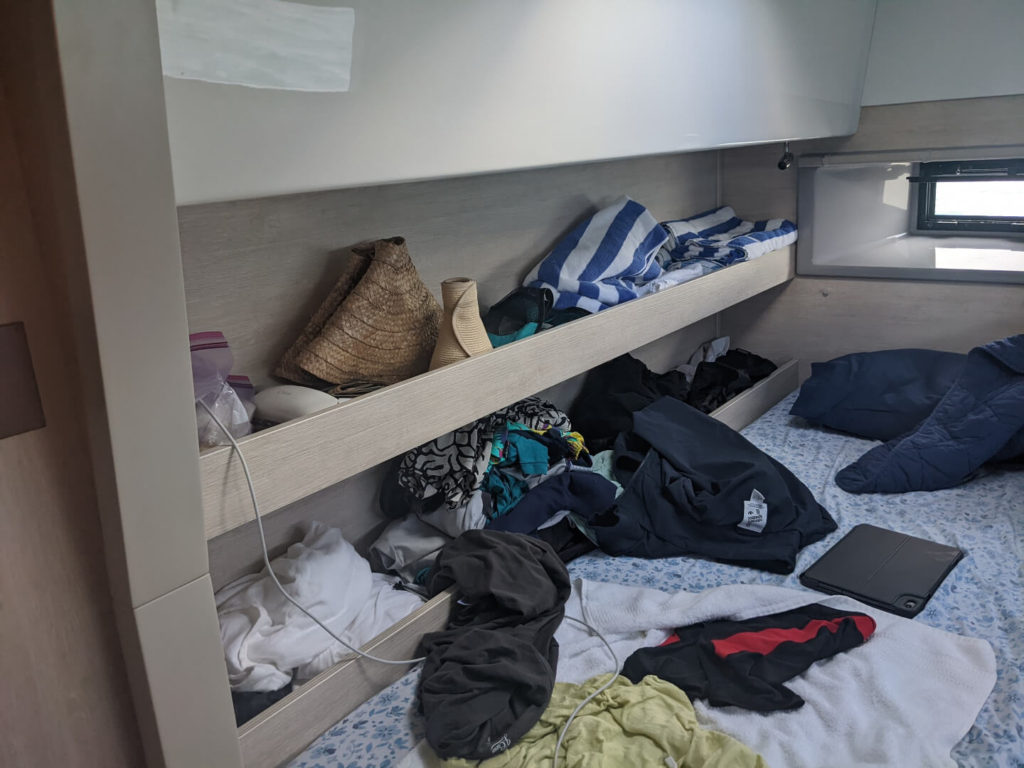
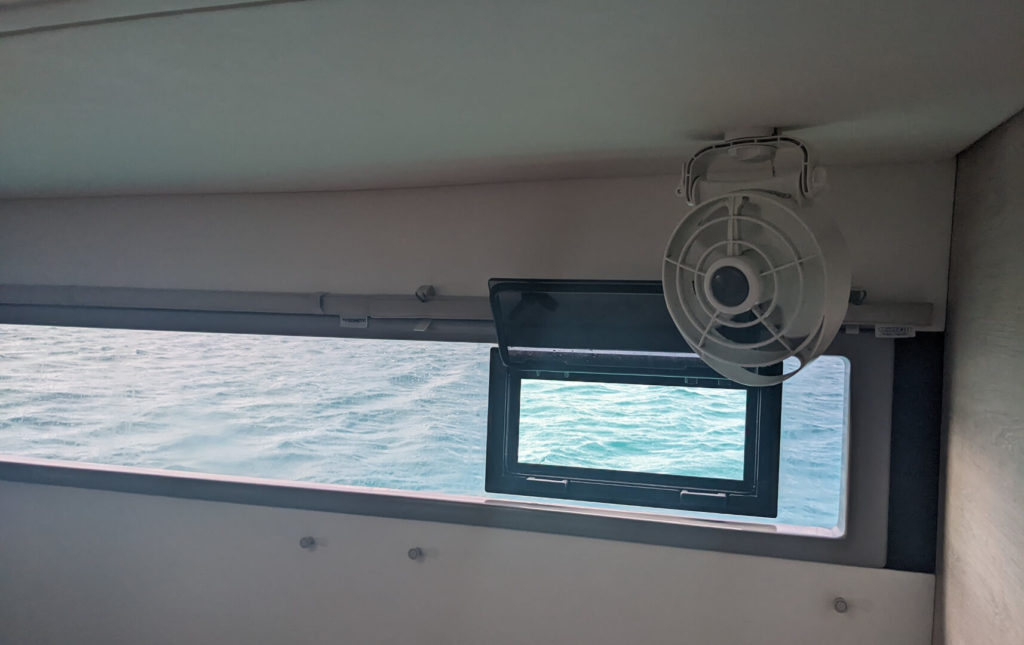
The forward stateroom has a bed that tapers toward the bow, making it a bit smaller in total. It also has a smaller closet than the aft stateroom. However, it also has an open forepeak area at the foot of the bed that can be used for storage or sleeping small/medium children. The lack of engine beneath the bed here allows two drawers beneath the bunk too.
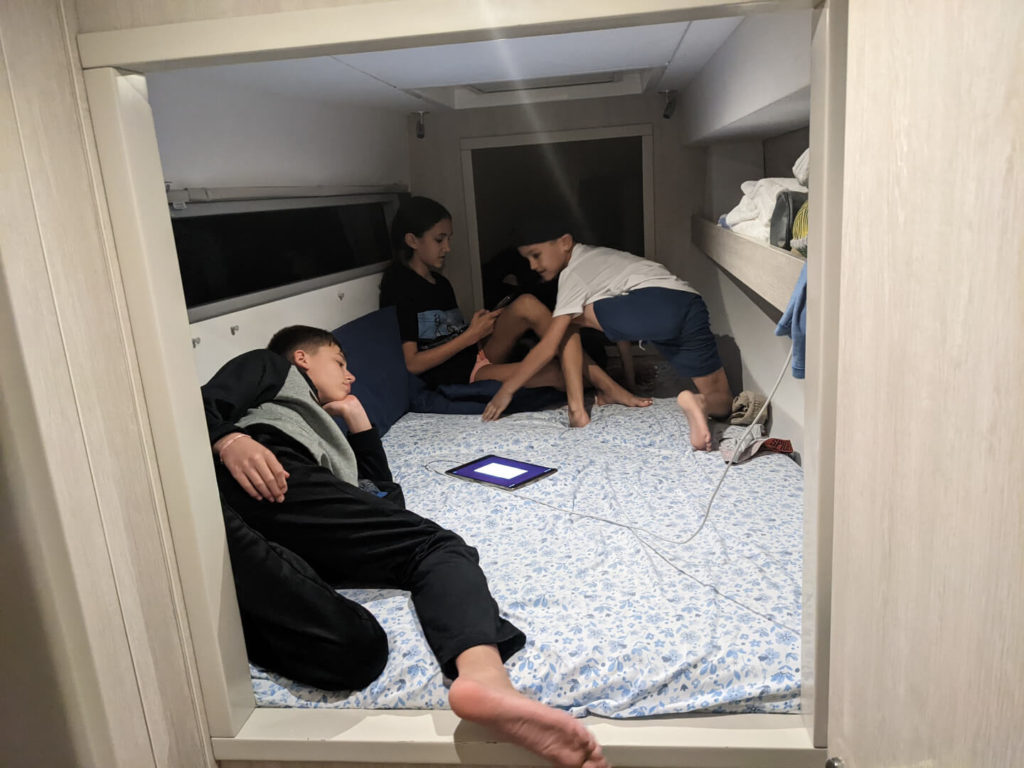
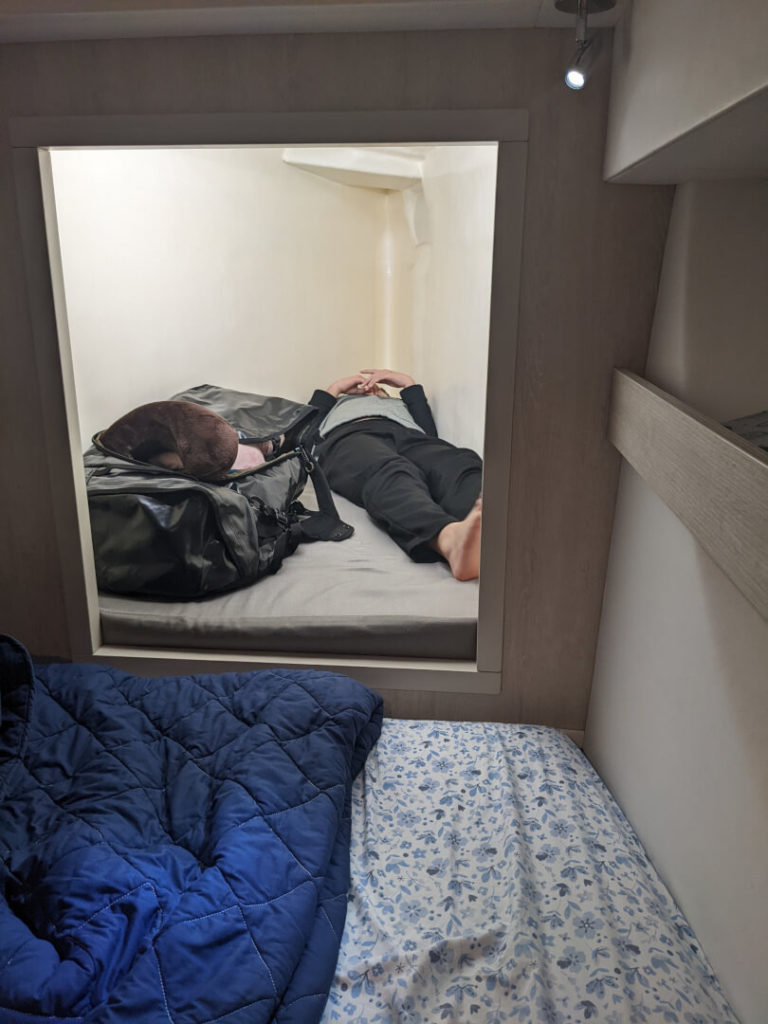
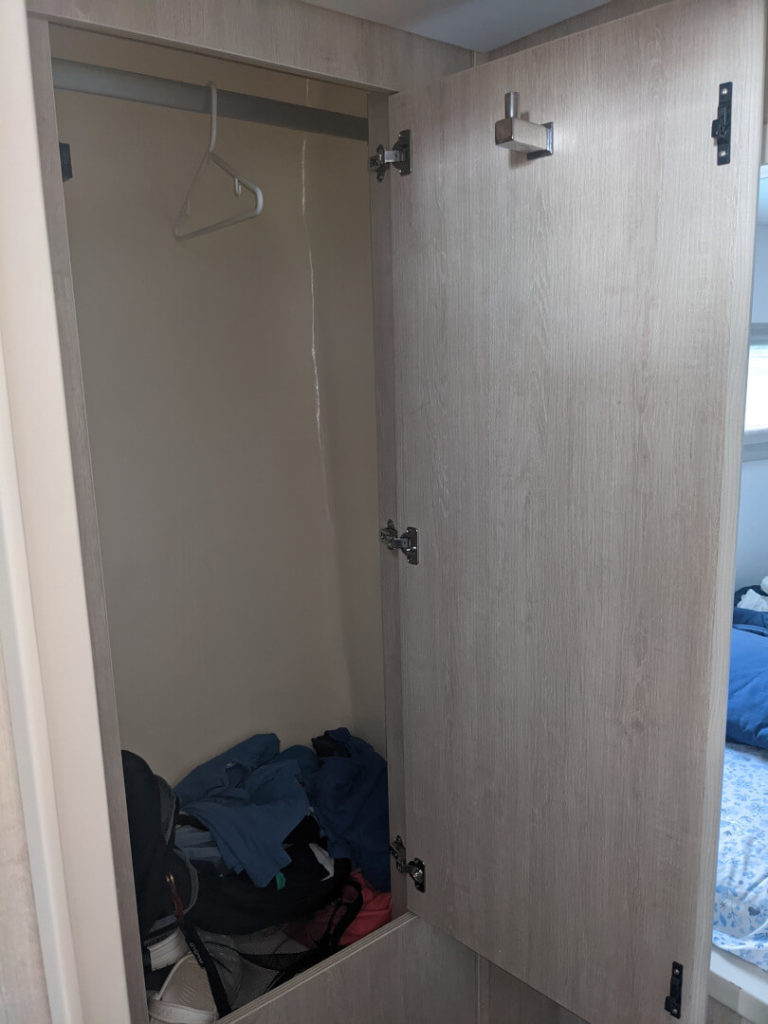
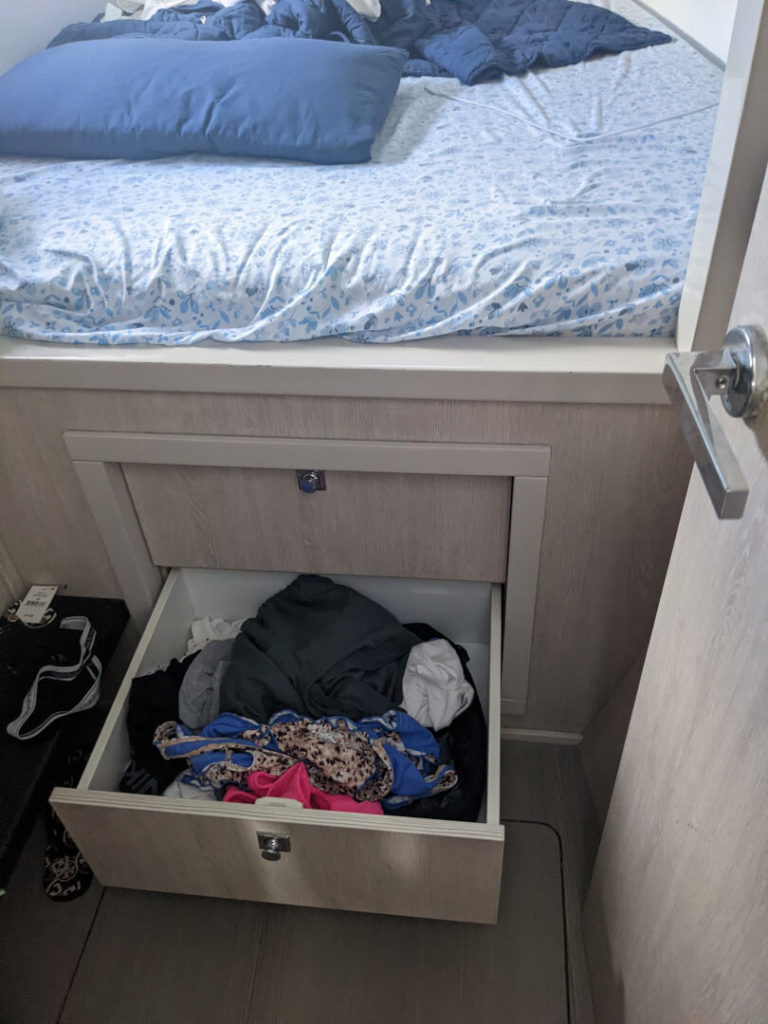
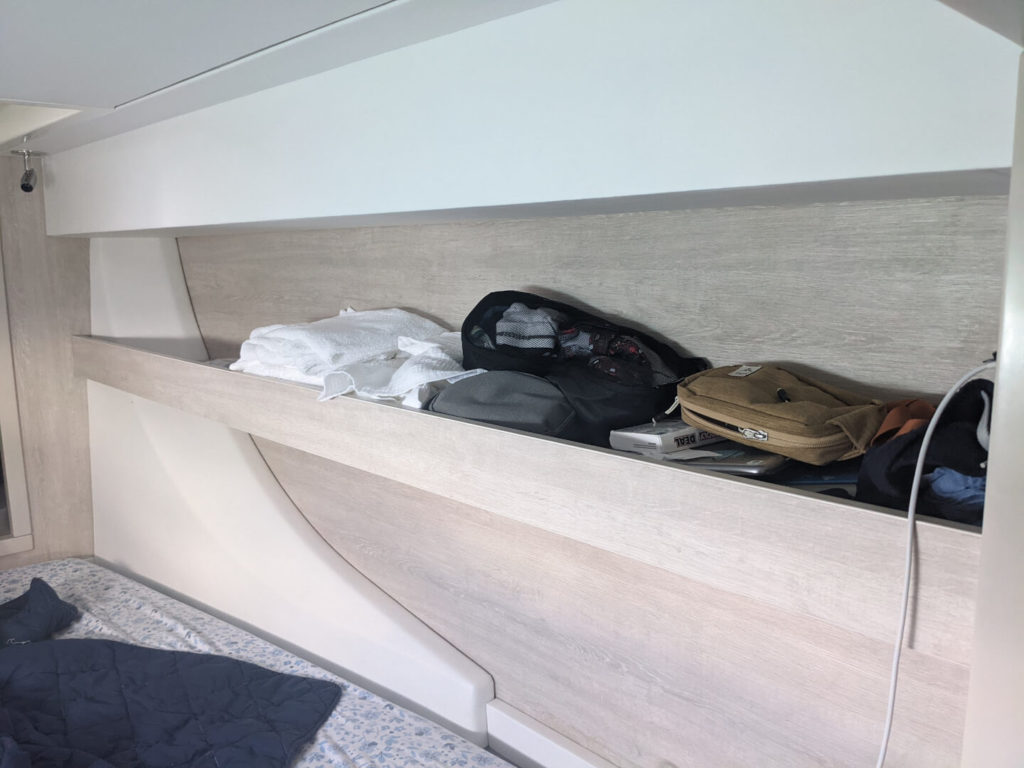
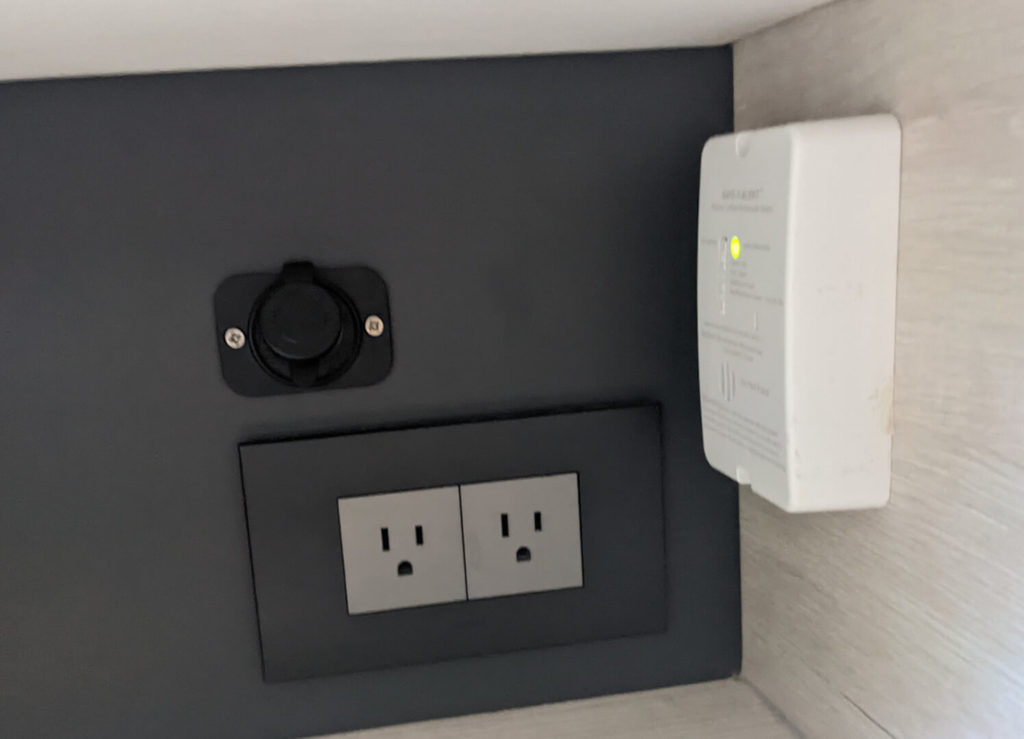
Both staterooms have two shelves that run alongside the bed. They are wide enough to stow emptyish duffle bags, breakables, and charge phones on the well-located USB sockets. Both have locking doors and air conditioning supply ducts. They also both have hatches overhead and to the side, with a fan mounted in front of the side hatch. The aft stateroom has a third hatch at the rear. All overhead hatches have a retractable blackout cover and bug screen. All but one of our hatches still had them entirely intact. The side windows have curtains to cover them. One side window on our yacht was cracked.
Port Head (Bathroom)
The port head (bathroom) has a toilet at one end, a vanity in the center, and a shower with a porthole at the opposite end. There is also a hatch with a screen and shade on the ceiling. A small wastebasket folds out of the vanity where we were instructed to place our buttwipes rather than flushing them since the base does not provide RV toilet paper. There are several hooks for towels and wet clothes. (note that what you hang in the head will smell like the head…raw sewage in our case) All materials are waterproof except maybe the wood veneer pocket door opposite the vanity…that said, the pocket door is a nice touch given the tight space.
The shower comes close to having a true stall but has a flat floor and lacks a door or curtain to enclose it; but at least you don’t have to stand in the shower while using the toilet. The shower wand is height adjustable and removable. The water control is a single lever that turns for temp and pulls for pressure. This makes it easy to pause without resetting the temperature control when taking a navy shower. The drain pump operates automatically as the shower drain fills with water (as long as it is switched on at the breaker panel in the salon). There are several hooks throughout for towels and wet clothes and a ledge with railing in the shower for soaps and bathing supplies. All in all this is a very adequate, if not excellent head for a yacht this size.
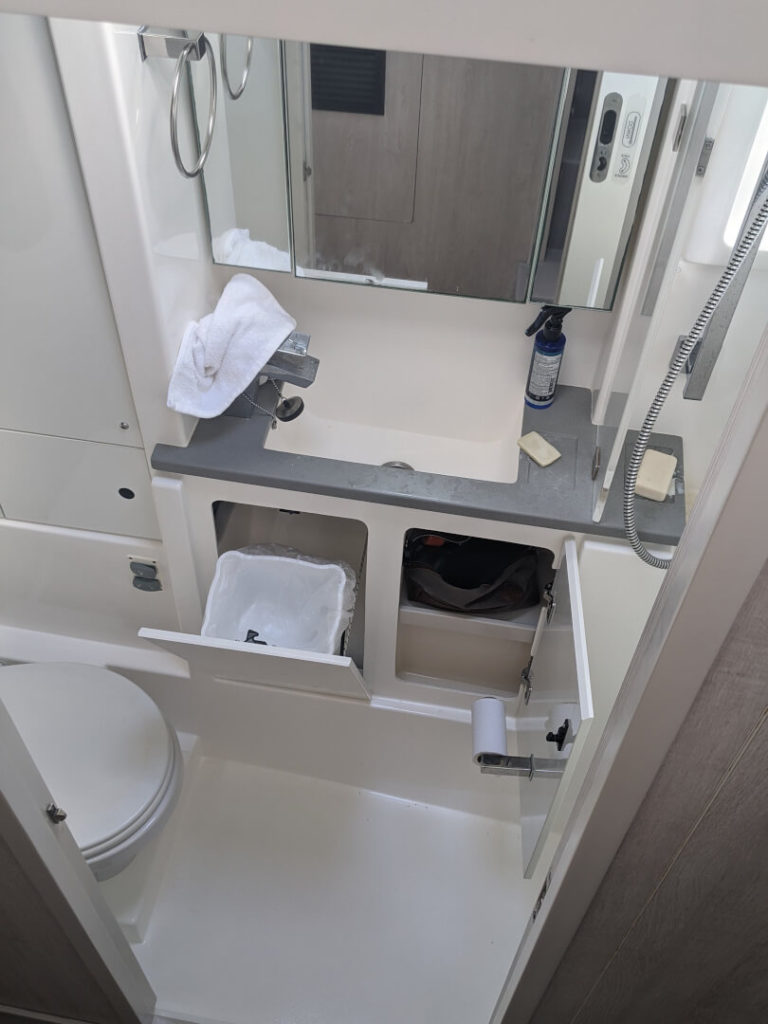
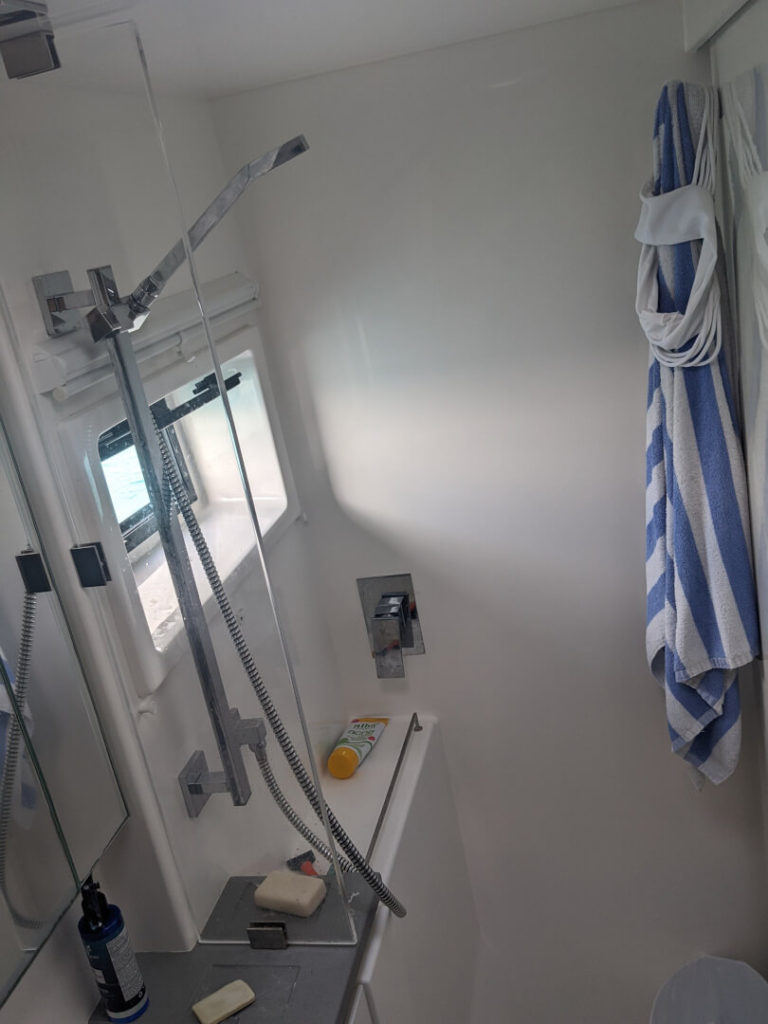
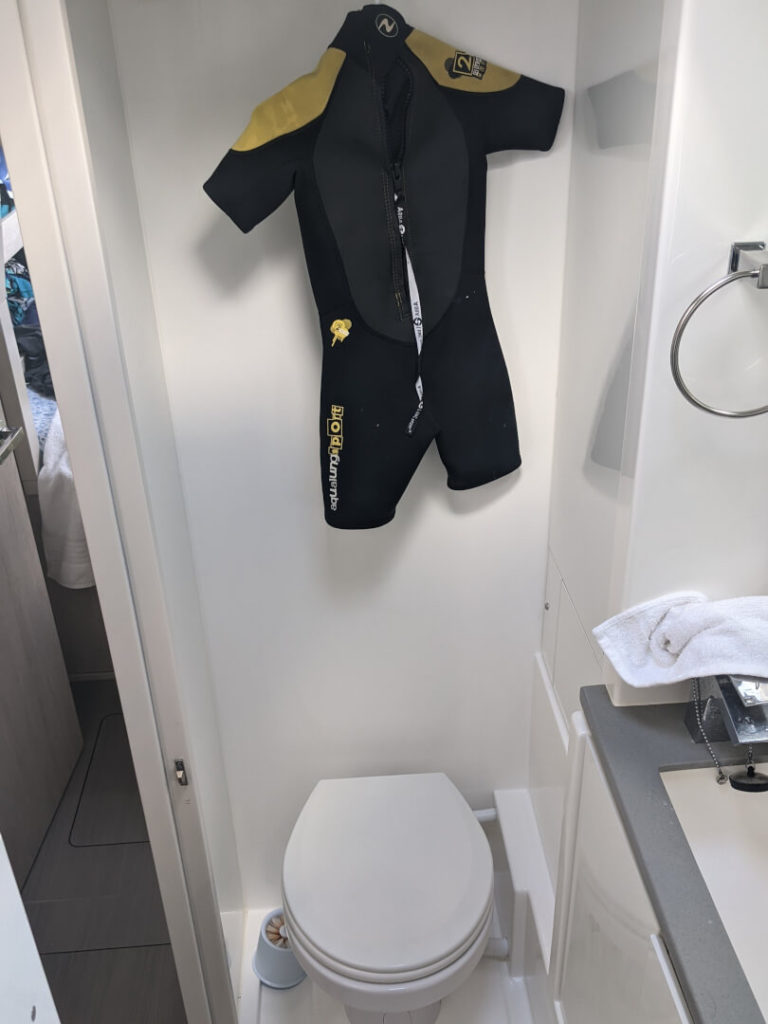
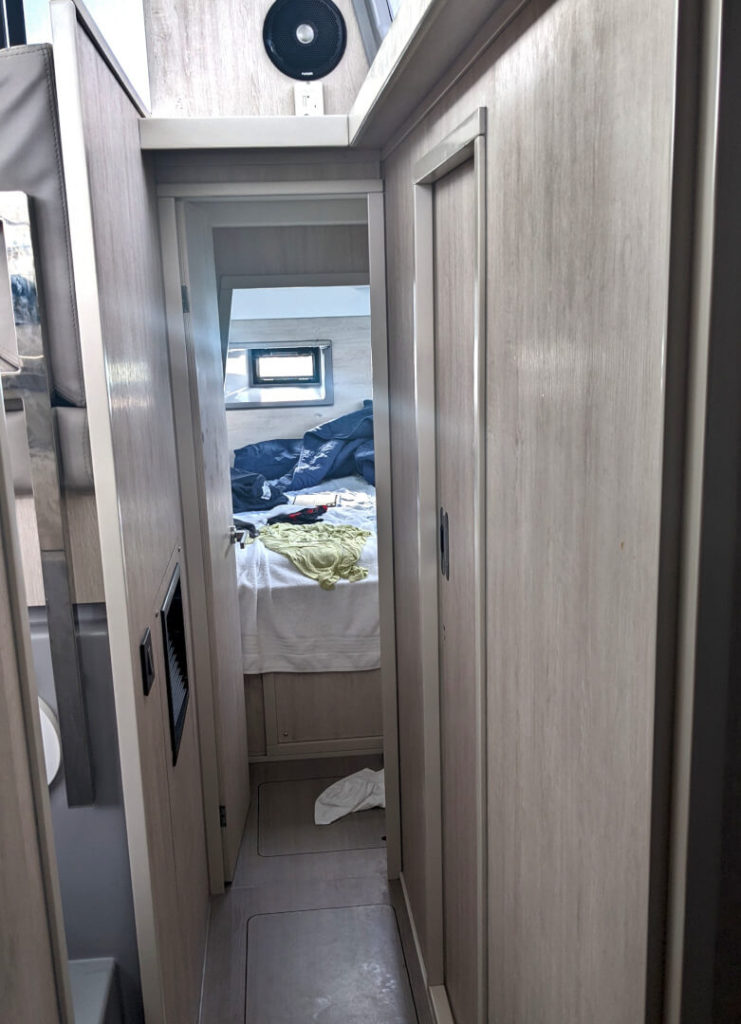
Owners Suite
In the Moorings/Leopard 433 PC, the starboard (right) hull houses the “owner’s suite”. The suite includes a bed in the stern that matches the other hull, a long hallway in the center with lots of storage and a desk/vanity, then a large head at the forward end of the hull.

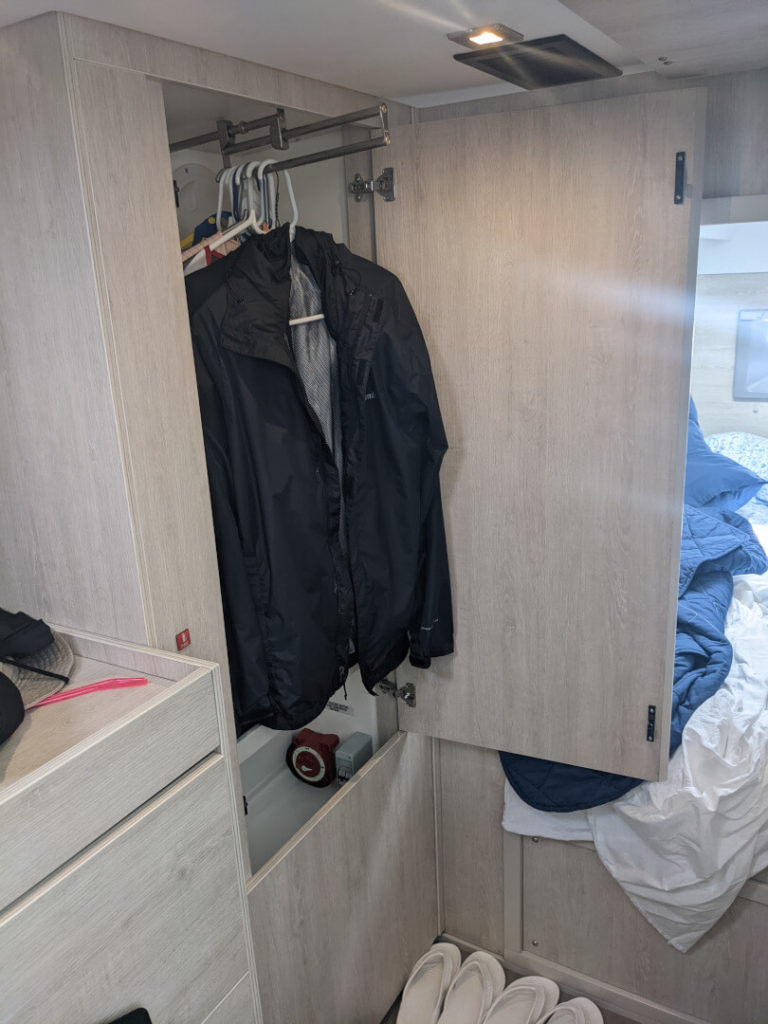
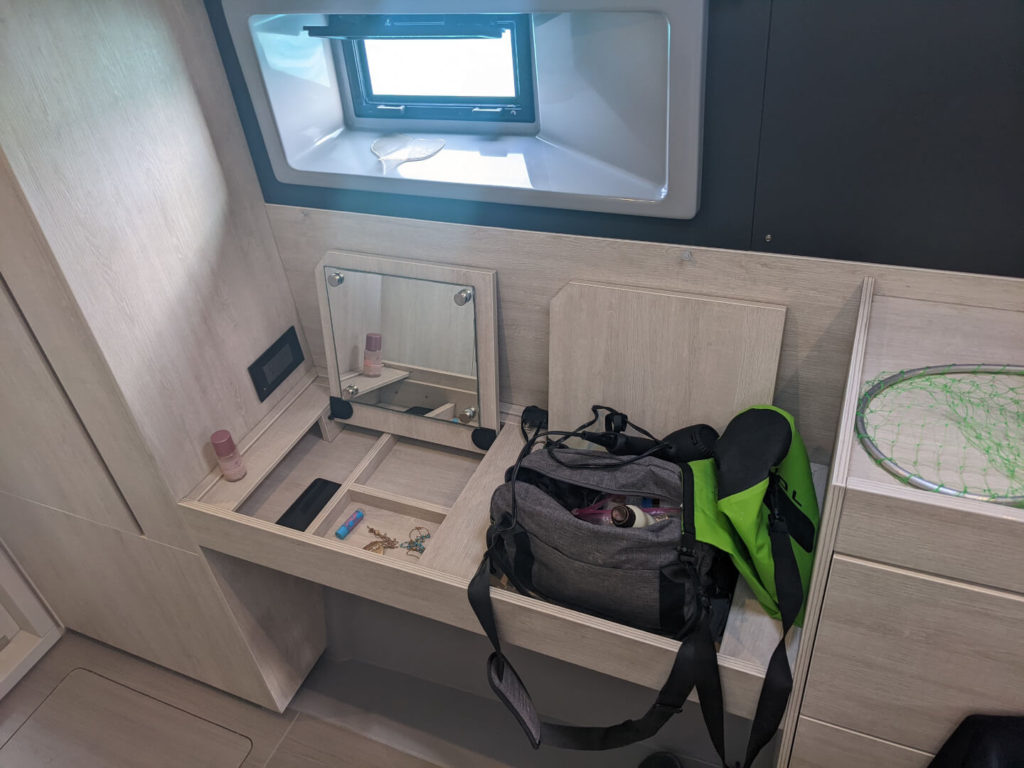
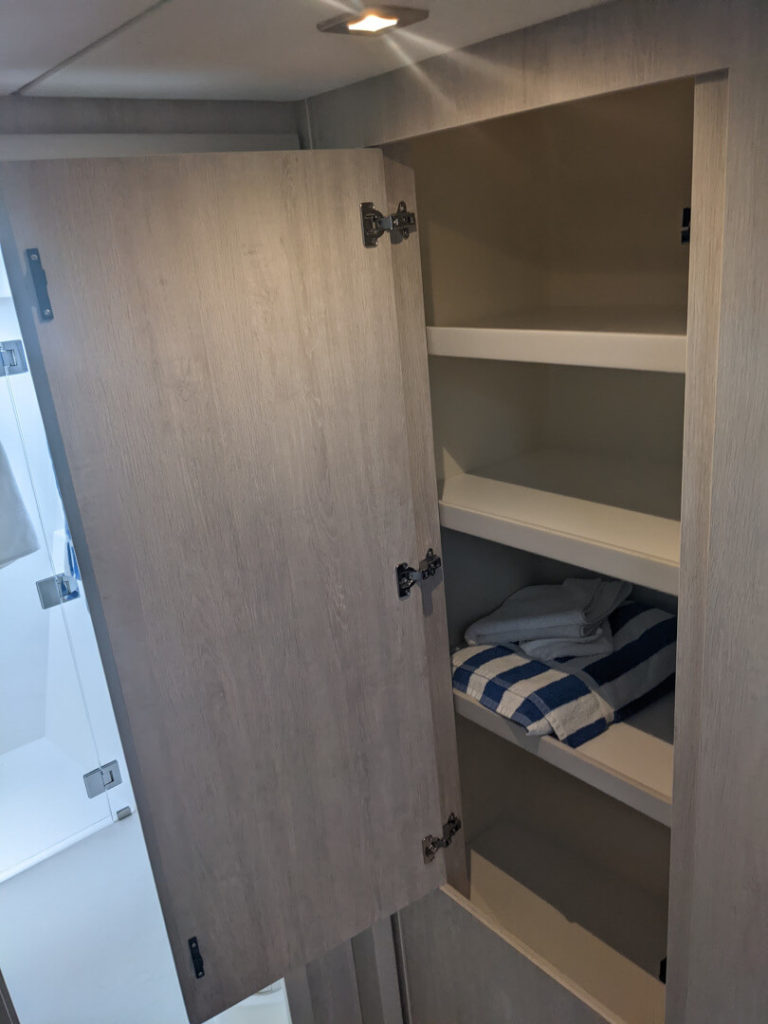
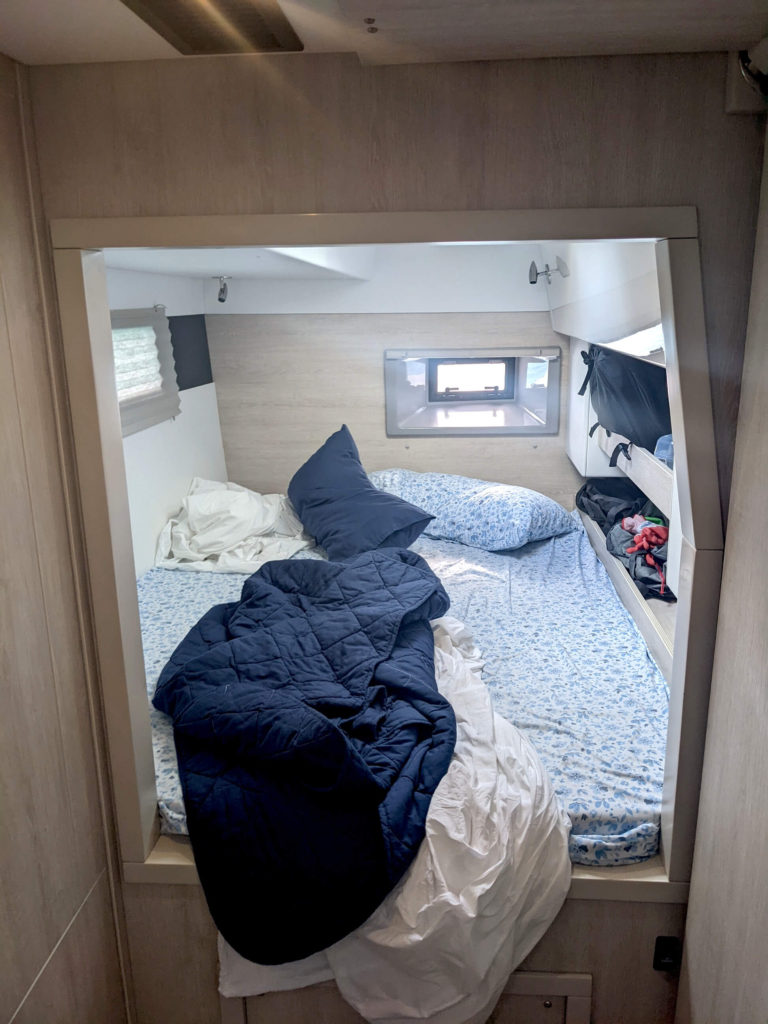
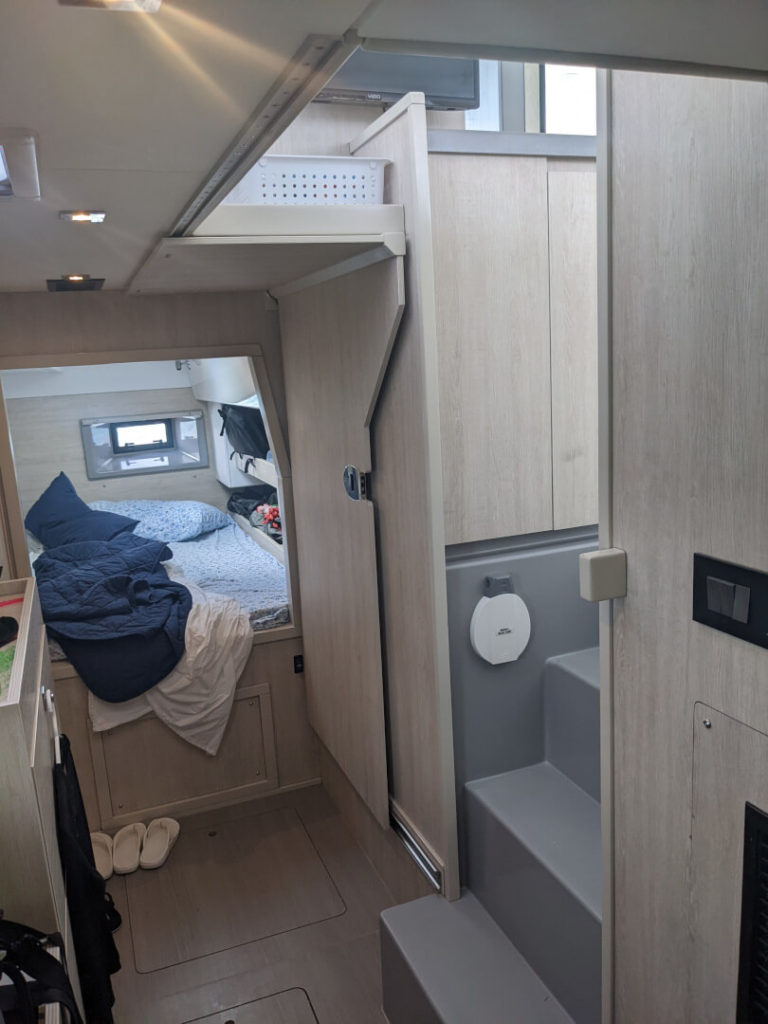
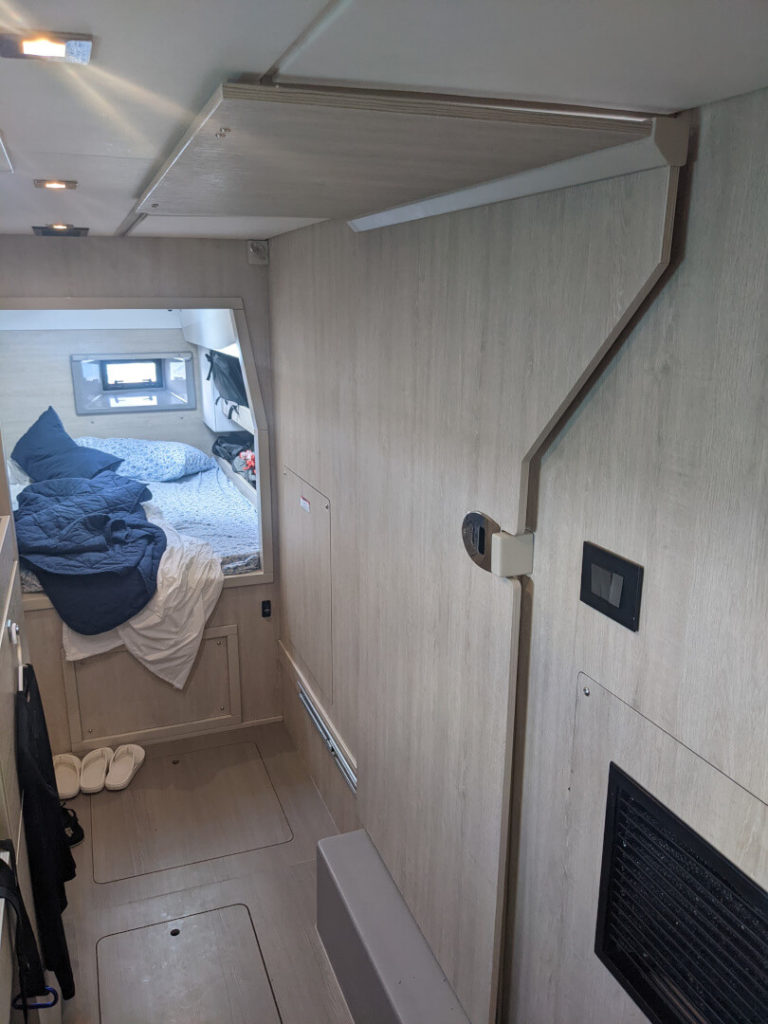
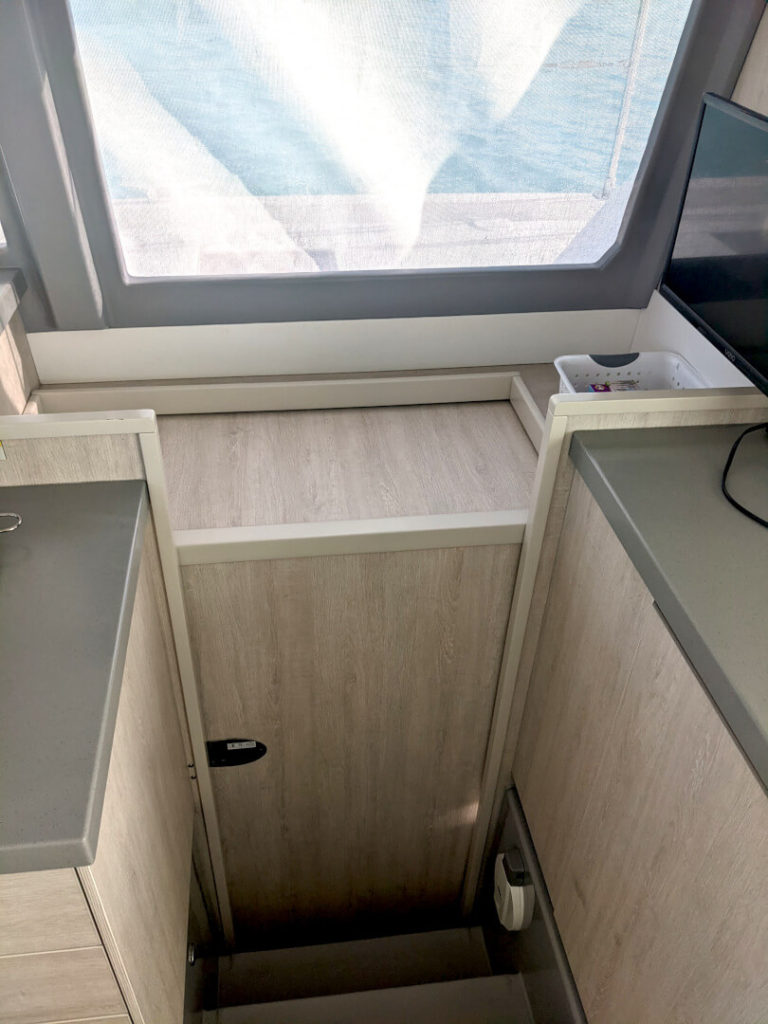
Instead of having a door to the bedroom, there’s a huge sliding piece of wood that closes off the hallway from the salon at the stairs to make one large room. We found two downsides to this design:
- First, opening the slider makes the area very open, so if one person needs to go in and out of the area while their partner is buck naked getting dressed, it’s hard to find a private place to stand while the door is open.
- The other issue is that the air conditioning is far less effective in this layout. The two air conditioning supplies, as well as the return, are all located in the hallway, creating a large space to be conditioned…furthermore, we were trying to cool the bedrooms while leaving all the exterior doors open to the salon. Every time you go in and out of that huge door, you let all the cold air out in this scenario. Aside from that, it is a pretty trick design.
The stern bed on the owner’s side matches the one on the port side.
Owner’s Head (Bathroom)
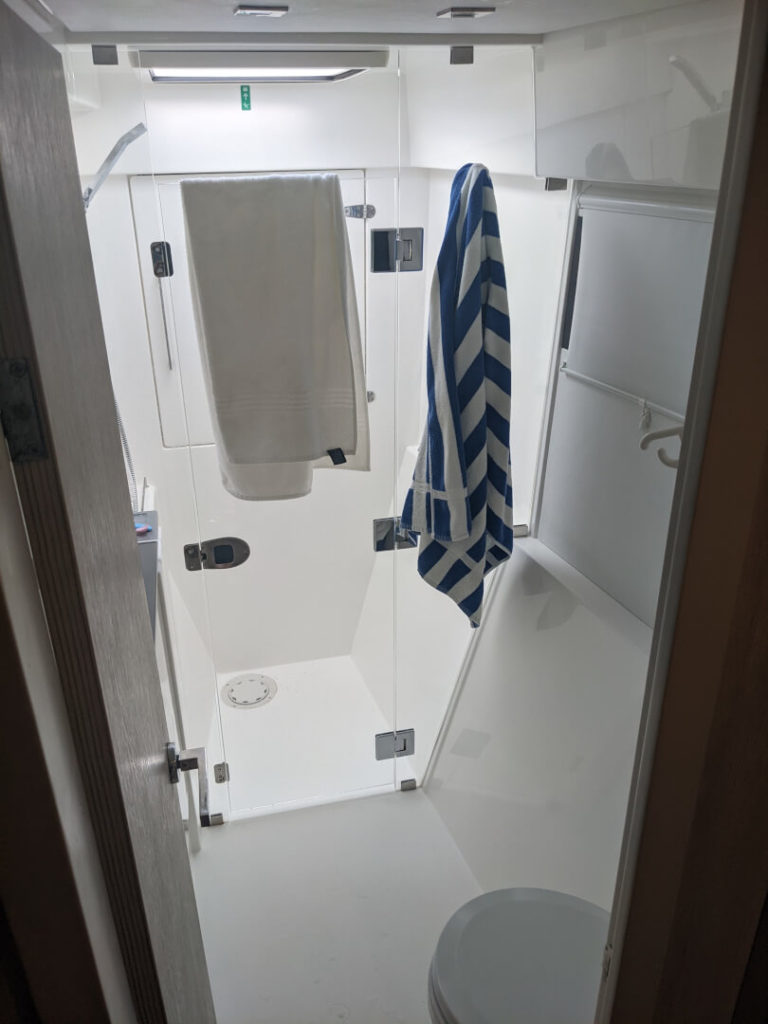
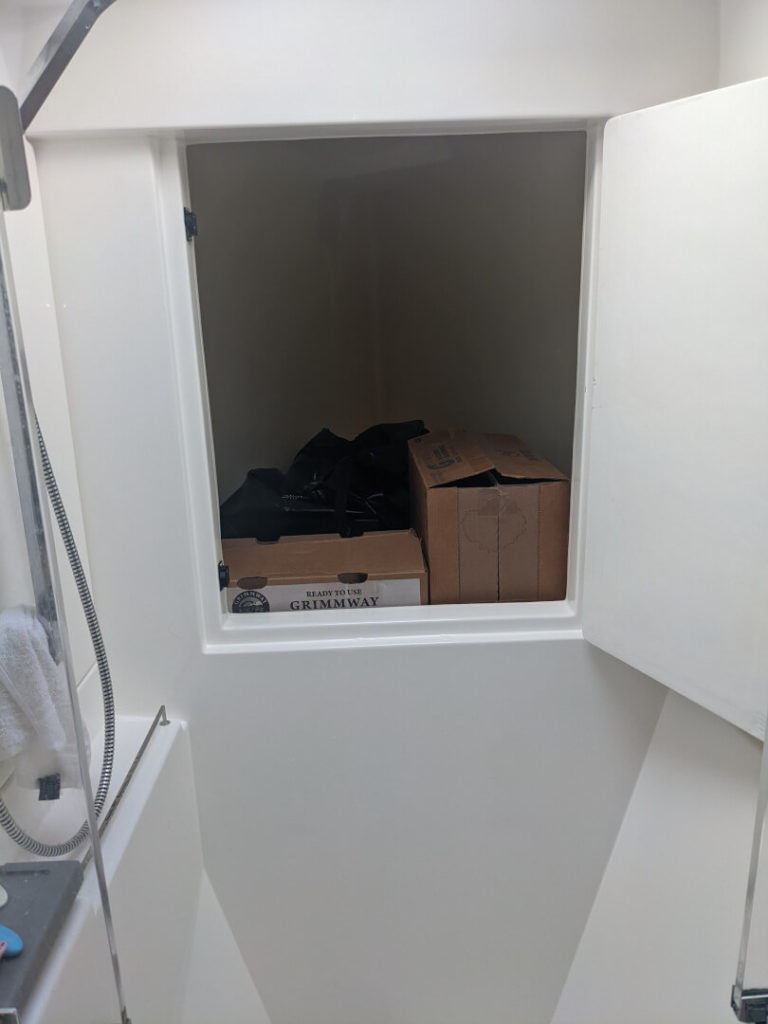
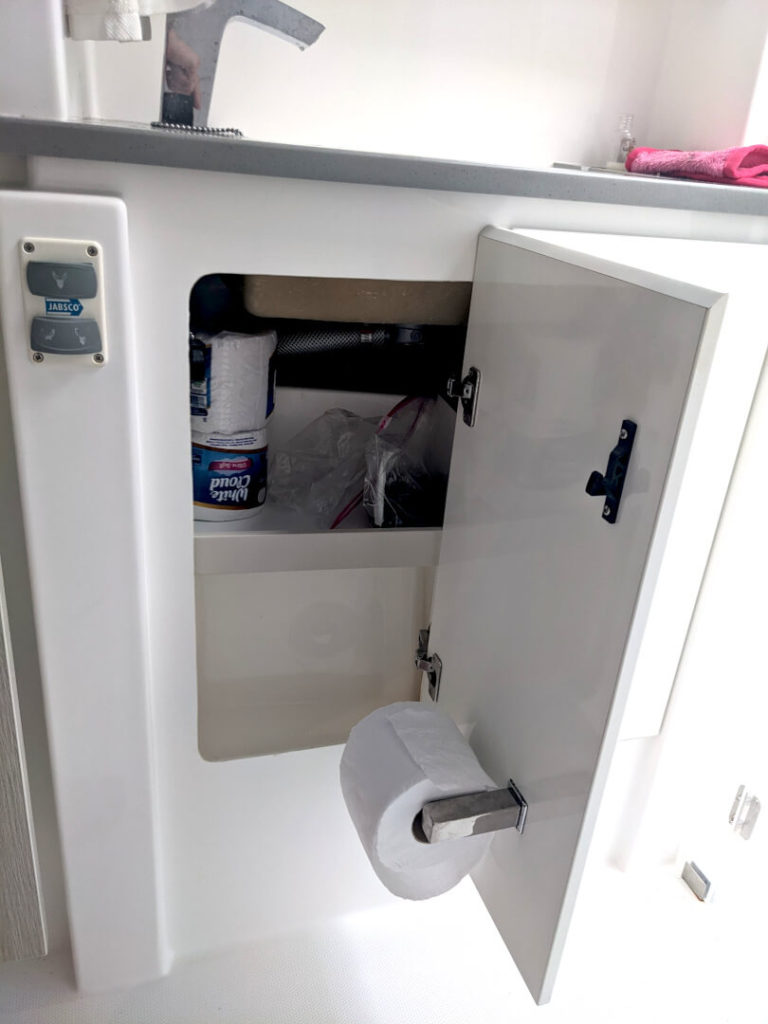
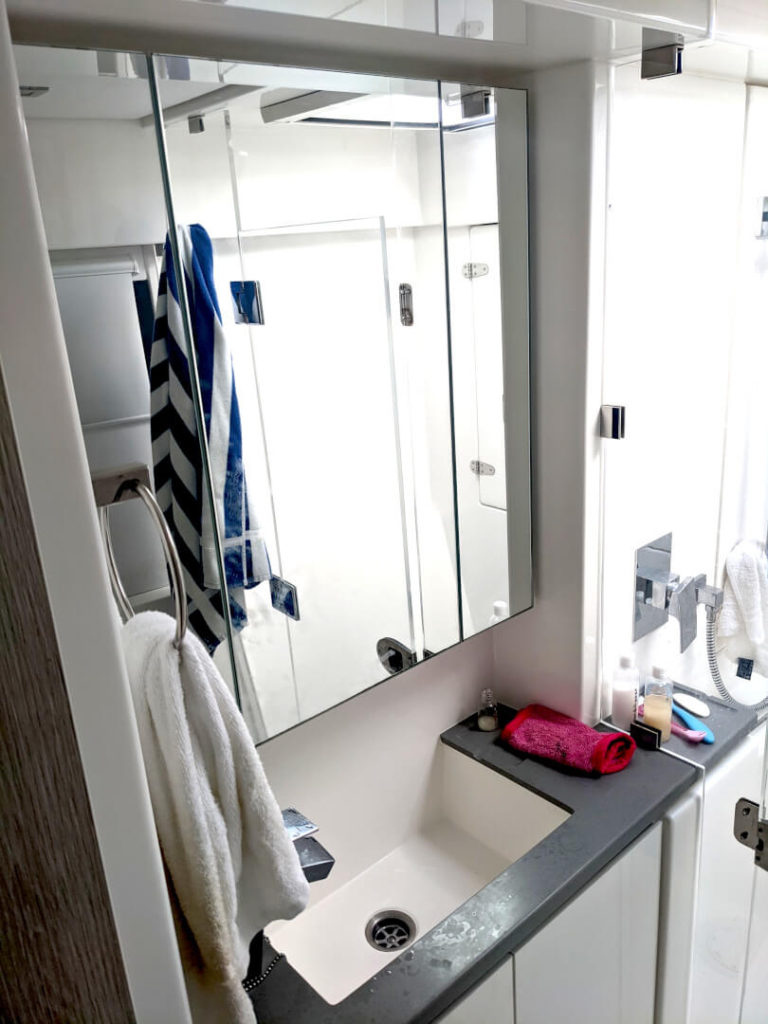
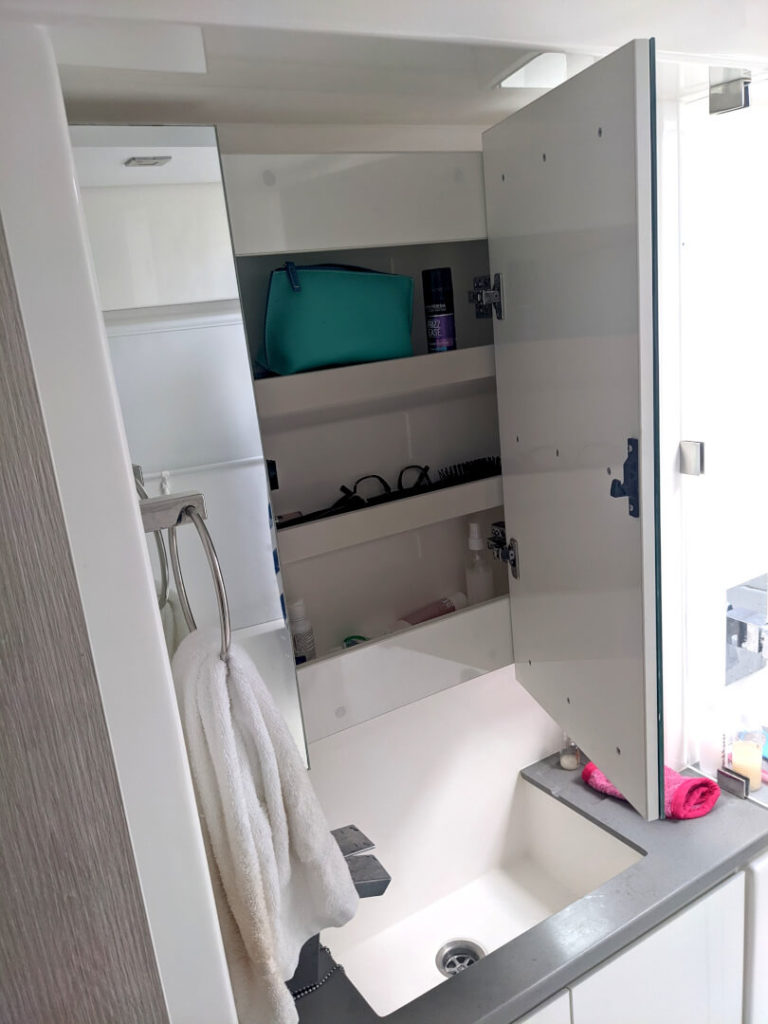
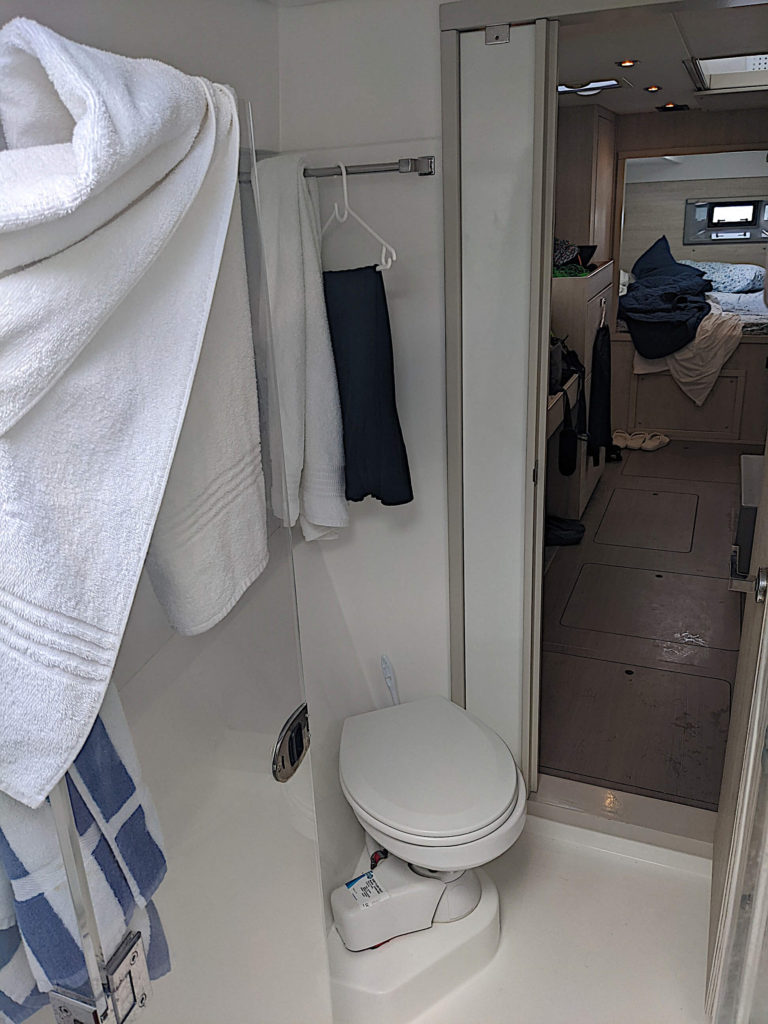
You’ll think the port head is great until you see the master head on the starboard side. Located in the bow, it has a very generous, fully enclosed shower stall. Even more generous storage in and around the vanity. There are lots of bars and hooks for drying. There’s also a huge cabinet forward of the shower where the V-berth is in the other hull. You can fill that sucker up with anything that can tolerate the bathroom humidity. We used it to store some more rigid bags and boxes, but barely put a dent in the space. The toilet is mounted in the corner behind the swinging door. This allows for plenty of knee room when you need a bit more purchase to get the job done. The fixtures and pumps are the same as the other head, but the hatch is much larger in here.
There’s a 120v outlet at the desk/vanity that can be used to blow dry and curl your hair with the generator on. Note that this outlet is on the galley circuit, so it will conflict with any appliance you might be running at the same time, such as the coffee maker.
Systems on the Leopard 43 Powercat
Air Conditioning
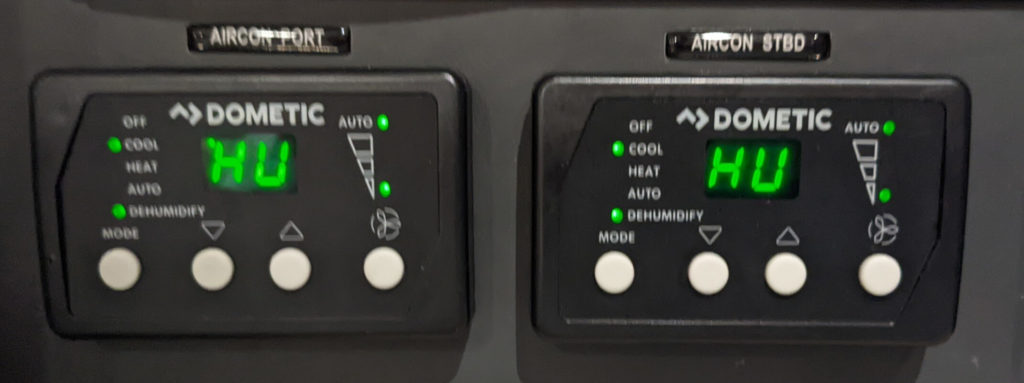
There are two separate air conditioning units that supply each hull and can be set to different temperatures. The port hull has one supply vent in each stateroom and a third in the salon, with the return air in the hallway. The starboard hull (owner’s side) has a supply vent at each end of the hallway, one in the salon and the return air in the hallway. On the port hull, the supply vents are located inside the staterooms.
Closing the stateroom doors on the port hull cooled those small areas very quickly. The large cooling area in the starboard hull, on the other hand, took longer to cool down and gave up its cooling quickly when sliding the giant door open if the yacht wasn’t completely closed. So, the system was most effective with the salon doors closed and cooling the entire yacht. Not a bad thing as some catamarans only have capacity to cool the staterooms. The air conditioners also have a dehumidify setting and can be run in reverse cycle to heat the cabin. You must run the generator or be on shore power to operate the air conditioners.
Electrical
The yacht is equipped with a 9 KW Northern Lights diesel generator. There is no inverter on these yachts, so any 120v application requires that the generator be running. This includes the a/c, watermaker, flybridge BBQ, kitchen appliances, water heater and 120v outlets. The generator isn’t disruptively loud, but it does rock the yacht a bit when starting; my crew appreciated a warning before firing it up. In cruising service, our yacht had twice as many hours on the genset as the engines. I would welcome an inverter to reduce fuel consumption and running hours when only a light load is needed. However, in charter service, this is likely to result in more severe experience for the batteries.
The fridges, pumps, and navigation equipment all run on 12 volts, allowing them to run off the batteries. With help of the solar panels and regular use of the generator, our checkout skipper said we shouldn’t need to worry about state of charge on batteries. However, we did get a low house battery warning on the Raymarine MFD on our 6th day away from shore power.
The anchor windlass and dinghy davit are both 12 volt, but have a big draw. So, like on most yachts, you should have an engine running to ensure adequate voltage for the motors and reduce wear on the batteries. In the case of the Leopard 43, the port engine carries the charging load and is the one to run.
Watermaker
Our yacht came equipped with a watermaker. Watermakers use a large pump to press saltwater through a high density filter, removing the salt. This process requires a lot of electricity, so the generator must be on to use it. Out islands in the Bahamas use the same type of reverse osmosis systems to make water on shore. Because of this the water hose at the fuel dock is not free. Rather it costs 40 cents or more per gallon, making the generator operation economical, even at $5 per gallon for diesel. However, our checkout skipper spent 20 mins or so tinkering with it and couldn’t get it started. Watermakers are notoriously finicky, so this was not a surprise. The watermaker is located underneath the forward port bed.
Water
The Leopard 43 Powercat comes with two 102-gallon water tanks and two 12-gallon hot water heaters. While the hot water heaters serve each side separately, the freshwater tanks serve the entire yacht and can be switched open separately. This allows you to open one tank at a time, so if you’ve got an overzealous showerer on your crew, they can’t tap both tanks in one shot; giving you an extra day to re-water. With four adults and three kids aboard for a week we refilled the primary water tank after the second morning and did not empty it entirely before returning the yacht. So the total capacity for both tanks would have been sufficient for the week. However, the kids mostly bathed in the ocean and just rinsed off with the fresh-water pump on the stern.
The supply water pump was located in the salon and very quiet, so you won’t wake the crew while washing your hands in the middle of the night. The water heaters were very effective in that we had hot water in the morning before turning on the generator and we never ran out. The automatic shower drains were nice (compared to manual drains), but they were not silent.
Heads
The yacht comes equipped with Jabsco electric heads. The Jabsco head is operated with sea water, with one button to fill the bowl before you do your business, and another button to suck it into the holding tank. Most charter yachts, well most yachts under 100 feet, are equipped with a similar system. While a manual pump is very common, electric pumps like this one is considered an upgrade. The electric pump makes it easier to go potty and to rinse the toilet, but might result in filling the holding tanks faster. It’s also harder to rinse the valves with the electric system (read on).
Using sea water for flushing reduces fresh-water consumption. However, that short cut has an unfortunate side effect: the saltwater reacts with your piss to crystalize into a stinky mess. The crystalized saltwater piss builds up on the toilet valves so that, over time, they don’t close. It also builds up in the hoses (making it easier to clog) and in the holding tank (reducing your capacity). Somehow, this cocktail also manages to leech through the hoses and stink up the bilge. If this type of system isn’t serviced after each week of use, this science experiment compounds, leaving the yacht with a perpetual sewage smell and a system that hesitates to accept and contain your waste…like on our yacht.
Like RVs, these systems clog easily, especially with toilet paper. Moorings has charterers supply their own toilet paper and instructs us to put the TP in the wastebasket…not only a hard reflex to overcome, but gross. It would seem more effective for the charter company to supply the yachts with sufficient RV toilet paper, which is what we see when chartering in the Pacific Northwest.
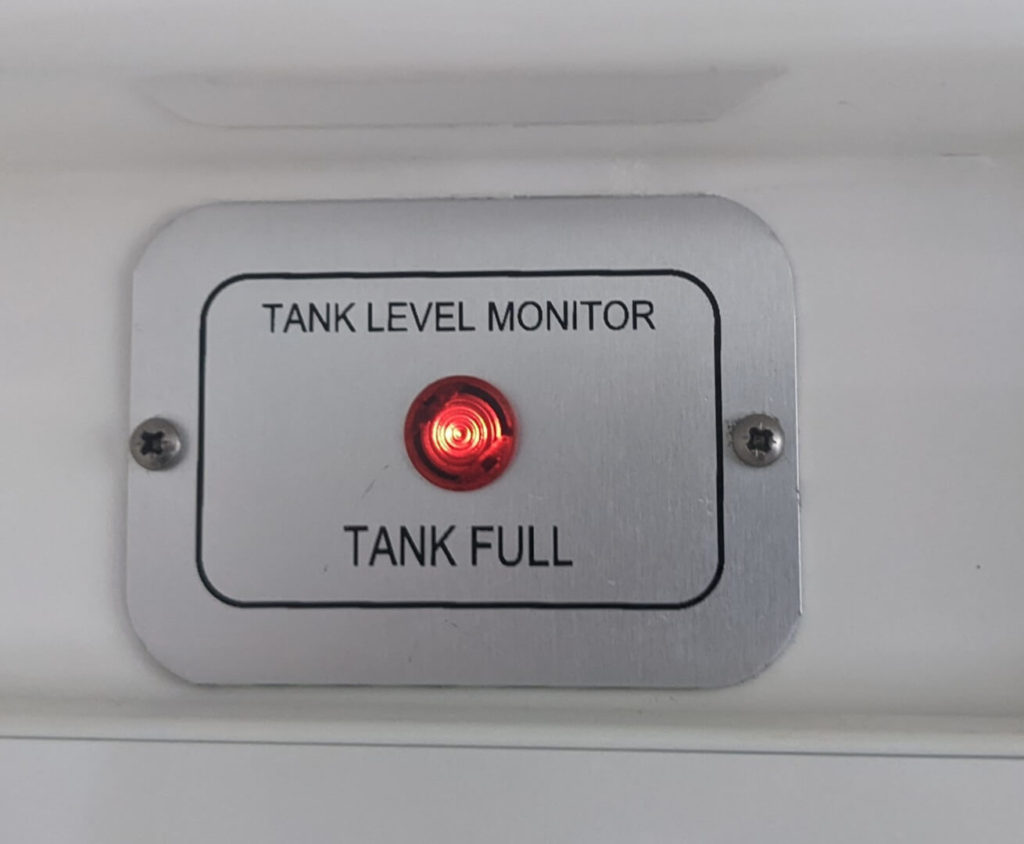
On our yacht, the port tank was full on the first night and clogged intermittently throughout the trip. The starboard head constantly leeched a stream of piss onto the bathroom floor. At one point we got an airlock on the starboard head and it wouldn’t fill the bowl with water. I was able to fix it by closing the seacock, removing and draining the filter, then putting it all back together. Then we only got 3 days out of the starboard head after emptying…then two days. Be sure to empty your tanks every chance you get.
When we returned our yacht to Moorings with a long list of safety issues, they didn’t have much of a sense of urgency, but once the dockhands got word that we had a clogged head, they were down there in a heartbeat. Apparently, the Nassau base policy is that charterers pay $100 cash to whomever unclogs the head. We refused to pay given the issues we had.
If you do get a yacht with a crystalized valve, you can put some vinegar in the bowl and ease a small amount of it into the drain system with a partial flush (easier to do with a manual pump than the electric)…I learned that after returning home from this trip.
Anchor Windlass
Our anchor windlass worked as expected. It is noteworthy in how easy it was to access. The windlass is located in a hatch next to the stairs outside the forward salon door. The remote is stored in this locker with a cable long enough to be walked to the edge of the bow while watching the anchor rode. From these locations it is very easy to look up and speak to the helmsperson on the flybridge.
An anchor bridle spans between the hulls beneath the bow to secure the anchor rode once the anchor is out. You can’t see much of it from the topside of the yacht, so it could be a bit confusing the first time you use it if you don’t have much experience with catamarans. There are no length markings on the anchor rode, so how much you let out will be a total guess. On the bright side, we set the anchor at least a dozen times and never had the chain bind in the windlass or need to fiddle in the chain locker.
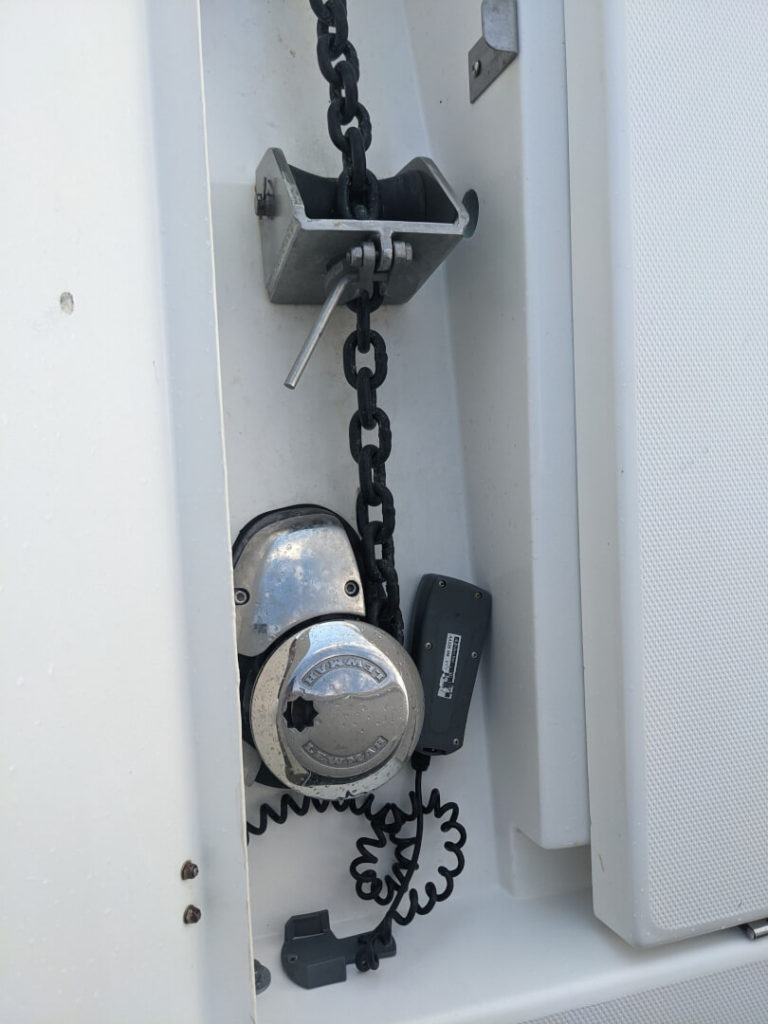
Because the anchor and windlass are mounted 15 or so feet behind the end of the bow, you have to drop the anchor at the windlass, then run up to the edge of the bow to watch while you let chain out, then run back to the windlass compartment to attach the bridle once the anchor is set. From these locations it is very easy to look up and speak to the helmsperson on the flybridge.
Our primary anchor was a big bitchin Delta anchor that dug in real nice. Even when the tide turned in some very shallow water and left us 90 degrees off our original position, the flat, low, wide shank dug into the sand and refused to drag.
Lighting on the Leopard 43 Powercat
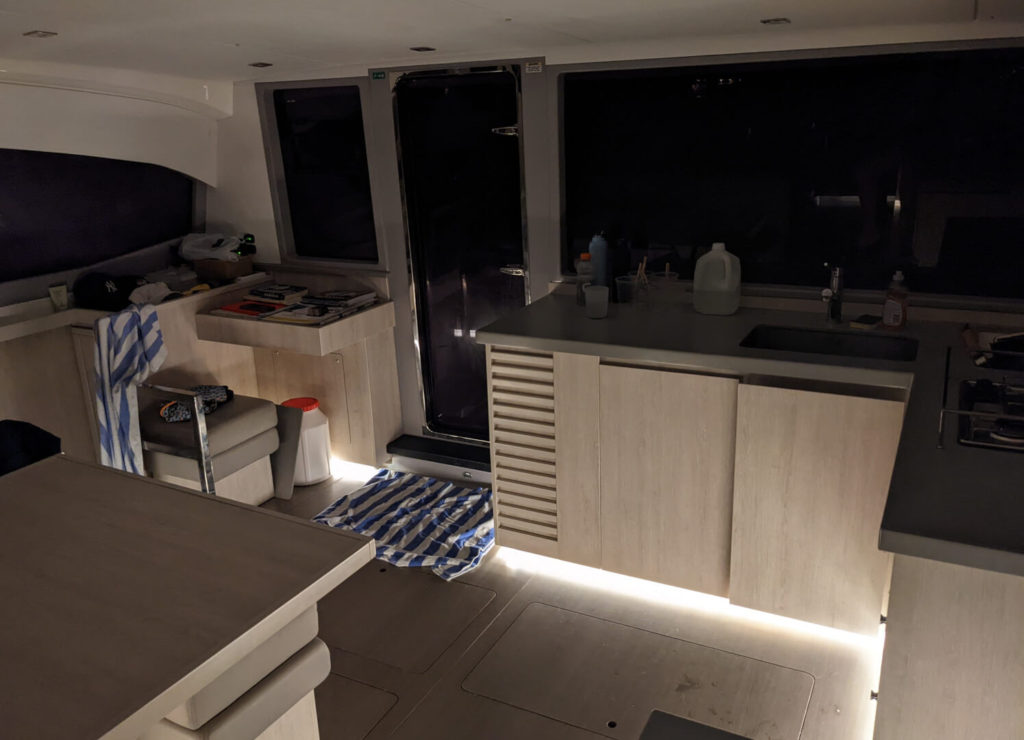
The Leopard 43 Powercat comes with lots of lights to ensure adequate lighting under many circumstances. The light switches were in logical locations mostly worked logically. The salon had three levels of lights, including a set of rope lights under the cabinets. It unfortunately did not have a low nightlight to allow some visibility while kids are sleeping on the settee. The flybridge also had under cabinet rope lights, white lights on the roof, and red lights for use while running at night. However, it did not have running lights to look forward (while in rental service, you aren’t supposed to run at night anyway).
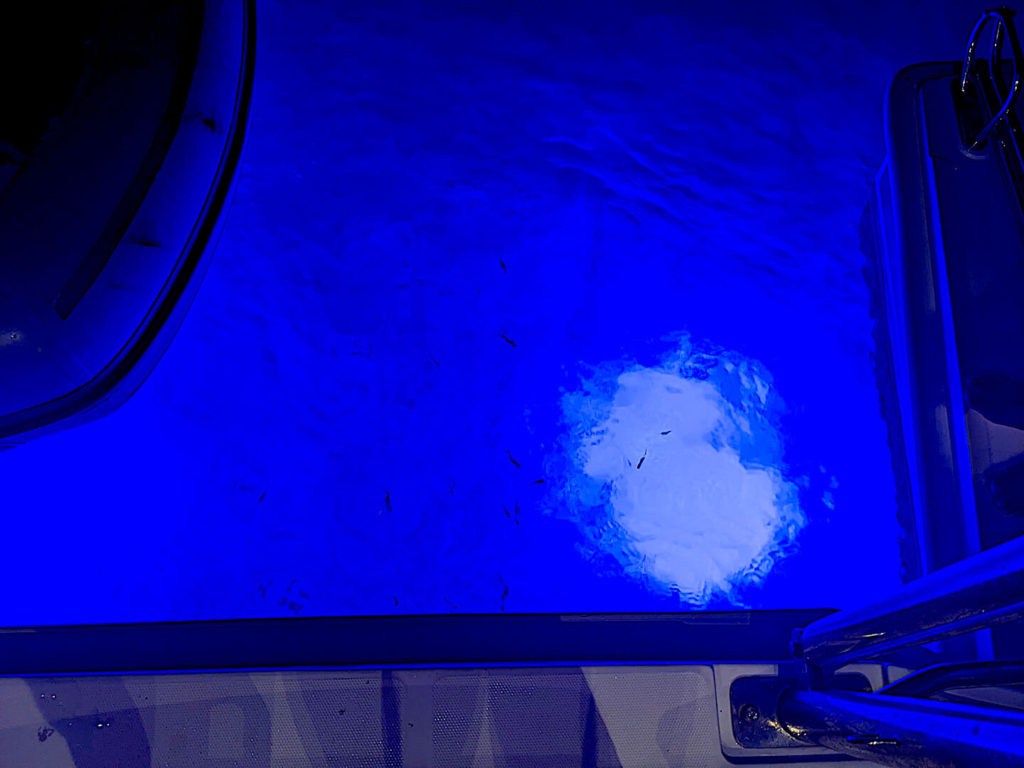
The yach had a set of blue underwater lights that made it easier to find the yacht when approaching with the dinghy at night. It also made for some cool views of the fish after dark and made it easy to confirm our running gear was in good order after we drug anchor and were not sure if we’d run aground. It also ensured we were visible while anchored after our anchor light fell over.
Problems with the Leopard 43 Powercat
Our Leopard 43 Powercat presented a surprising amount of problems on our weeklong bareboat charter. Especially considering our yacht was just over three years old at the time. I’ve already shared the problems we had with the heads, VHF, flybridge enclosure, anchor light, toaster, microwave, propane valve, inflatable life vests, both refrigerators, and the watermaker. So, I won’t repeat them here.
Unfortunately, this doesn’t seem to be an isolated issue. I spoke with a charterer before our trip that had recently gone out in an even newer yacht. He had problems with throttles, gauges, navigation, air conditioning, and the watermaker. I also spoke to the maintenance manager at the base. He acknowledged that the fleet was not being maintained as well as it should be and noted that he was recently hired to help the team start digging out, but was running into challenges.
After I reached out to The Moorings three times over 5 months, they responded with an apology and a credit for $1,304 towards our next charter, valid for three years. They did not offer an explanation or note whether conditions in Nassau have improved. In their defense, I think their customer service team got slammed dealing with other issues in the British Virgin Islands. I reached out to their press team for an update on these issues, but have not received a response.
Dinghy
The Moorings set us up with a sweet dinghy on our charter. It was a 10-foot RIB with a 25-horsepower motor. While it was rated for 5, we had plenty of room (and didn’t sink) with a crew of 7 and were still able to kick up a wake. While a 10-horsepower motor is more common on dinghies of this size, the transom was rated for 25 and it really did get us to shore nice and quick.
One day when I was in the dinghy alone, going into a bit of wind, I throttled up and the bow came a at least 5 feet out of the water, almost flipping the boat end over end! One disappointment that’s common outside the US is that it was a two-stroke engine. Two-strokes, if you don’t know, lose some unburned gasoline in the exhaust and ultimately into the water; they’re also less efficient and stinky. Worse yet, ours wasn’t delivered with a full fuel tank, so we had to fill it during our cruise and buy a full quart of two stroke oil (for $20!) to make the fuel mix.
The dinghy came equipped with a folding grappling anchor on a floating line (behind a bit of chain). While grappling anchors fold down nice and compact for storage, they really need rocks to bite, so it was useless at holding us in the sandy bottoms of the Bahamas. Additionally, the shackle pin was not installed tightly and fell out while we were using it.
If your itinerary includes regular use of a dinghy, (if you are anchoring or using mooring balls, it does), having a dinghy davit is a #GameChanger. Without a davit, you have to tow your dinghy. That means you’ve gotta remember to pull it in and keep the painter out of the prop while docking, and possibly remove the outboard while underway. Not docking? You’ll still need to bail the water out of it after towing. The Leopard 43 Powercat has a davit on the stern that makes it a cinch to launch and retreive the dinghy.
Bareboat Charter Equipment from The Moorings
The Moorings equipped our charter yacht with a strong supplies list. The kitchen was well stocked with storage and mixing bowls, plenty of cups, plates, bowls and cutlery for a crew of eight or more.
Navigational manuals included the top guides for our cruising grounds in the Exuma Cays: Explorer Charts and Pavalidis’ The Exumas Guide. The binoculars on the other hand were hilariously worthless. They were marked as 7×50 (meaning 7x magnification) with no brand name and weighted almost nothing. However, I don’t think they were even 2x magnification. Fortunately, we brought our own 7×50 binoculars which not only served to confirm there was something wrong with these, but allowed us to use binoculars, you know, when we needed them.
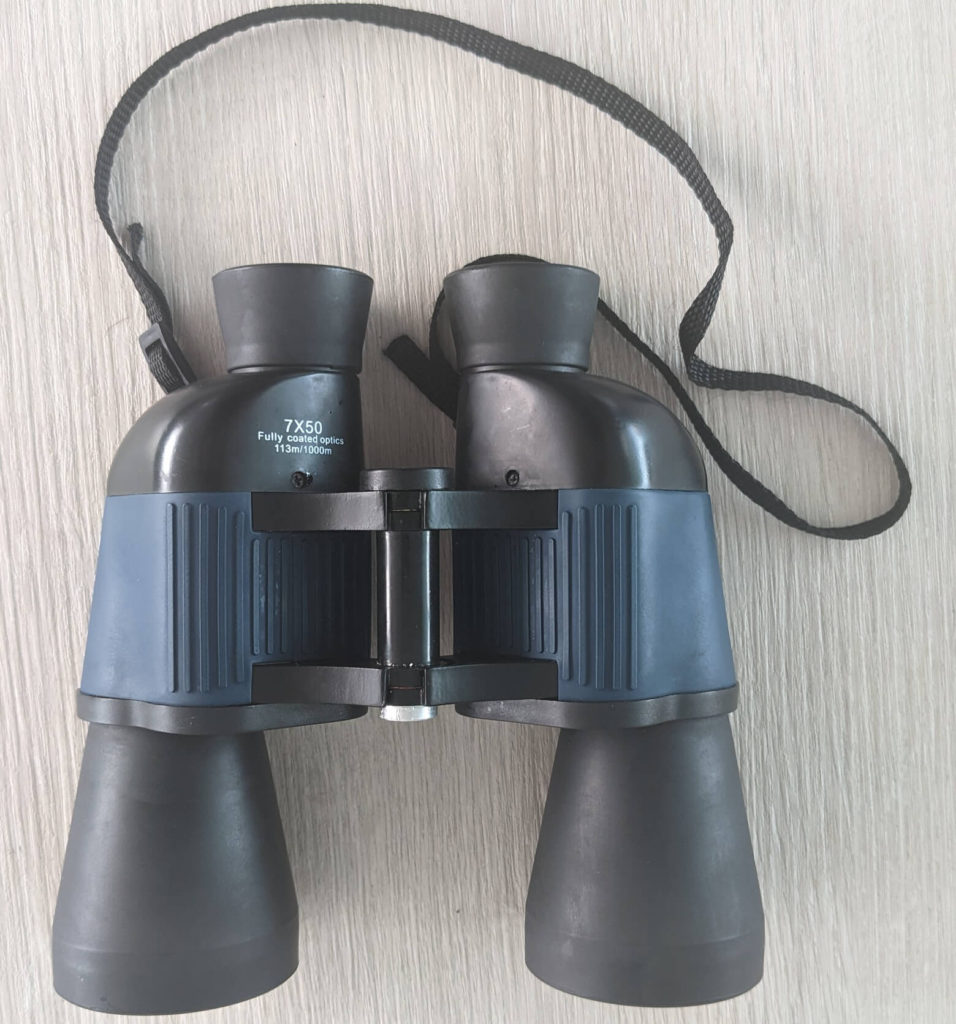
A full kit of inflatable life jackets was a welcome luxury compared to many charters with gross, old, ill fitting life jackets. However, as we learned, don’t trust a borrowed inflatable until you’ve verified that it is properly armed. Our yacht came with twice as many rearm kits as lifejackets, as well as safety harnesses beneath the salon settee. There was also a set of snorkel vests in the bow, which provided an extra level of safety when we ventured out with dive weights on. Snorkel vests are uninflated vests that you can self inflate if you run into trouble by blowing into a straw.
The toolkit consisted of two spare impellers (that we were told not to try to replace oursleves), spare fuses, spare hose clamps, a can of WD-40, a huge flathead screwdriver, phillips screwdriver, one allen wrench, and channel locks. Fortunately, we didn’t need it.
A plastic dry bin for the dinghy held some flares, and a flashlight.
Aside from the weak toolkit and lack of any working VHF, the other piece of kit we really would have liked to have was a broom and dustpan, or vacuum. The floors got pretty gross with a week of tracking sand through the yacht.
Features to Look For in a Leopard 43 Powercat
Options on the Leopard 43 Powercat are relatively limited, and when chartering from The Moorings, you from the fleet, not a specific named yacht. Your only choice is age. That said, the optional flybridge refrigerator makes for more food storage, which allows for more thorough provisioning up front. Depending on cruising grounds, this can save money and stress…or just eliminate the need to scurry down to the salon for bevvies while under way. The larger engines that our yacht was equipped with probably run a bit faster and eek out a few extra MPGs. Unfortunately, its a roll of the dice as to whether you’ll have these features on your charter.
The optional watermaker didn’t work on our charter, which is not surprising for watermakers. However, we would have welcomed it given the cost of water in the Exumas. In most cruising areas with access to water, it won’t be worth the fuel to operate a watermaker…and they don’t make water fast enough to take longer showers, so don’t think that’s an option!
How Much Does a Leopard 43 Powercat Cost and Where Can I Rent One
The shallow 3’1″ foot draft of this yacht allowed us to run up and down the shallow banks of the Bahamas’ Exuma Cays and anchor in some tight bays with confidence. These yachts are also available in The US and British Virgin Islands, Greece, The Seychelles, and Saint Lucia.
As of this writing, there are some dates available to charter the four stateroom 344 PC for as low as $3,700 of the three stateroom 433 PC for $3,900. At the other end of the spectrum, there are spring dates in Nassau currently listed for as much as $16,000. These yachts are also available in The US and British Virgin Islands, Greece, The Seychelles, and Saint Lucia.
Alternatives to the Leopard 43 Power Catamaran
If you like the general design of the Leopard 43 Powercat, but want to sail. The Leopard 40 will scratch that itch for 25-25% less in charter fees ($1k-$4k). Leopard has discontinued these models in favor of the Leopard 42 [sail] and (in 2023) the Leopard 42 Powercat. The new 42s have twin heads on the guest stateroom hull that likely comes at the expense of storage and the forepeak berth. Expect Moorings to keep the old models in bareboat charter for another five years while they’re slowly phased out in favor of the new models.
If you are looking to double down on the condo-cat vibe and rent something a bit more pontoony, Marine Max runs a charter fleet in the British Virgin Islands that is right up your alley. The 443 has a full beam owners suite and three heads with fully enclosed showers.
How Much Experience Do You Need to Rent a Leopard 43 Powercat
The good news is you don’t need any sailing experience to rent a powercat. However, your charter company will probably want you to have twin engine experience. Our checkout skipper did not expect us to be able to dock the yacht or maneuver within the tight Palm Cay marina. Depending on your comfort level, the checkout skipper can tow an extra dinghy out of the marina and use that to get back after setting you off; call the base and they’ll do the same in reverse. In addition to twin engine experience, you’ll need to be comfortable operating a similarly sized yacht (The Moorings will say +/- 5 feet) and have experience with the challenges of the particular cruising area you’ll be in.
Conclusion
A good friend of mine says sailing is about the journey, and powerboating is about the destination. My Spring Break Busy Boater crew was east bound and down: a long way to go and a short time to get there. The Exuma Cays were filled with cool stuff we wanted to see and do during the one week we had, and the powerboat speed was the insurance policy to get it done.
The generous storage, tankage, and electrical systems neutralized the lack of infrastructure for fueling, watering, docking, and provisioning in the Exumas. The vast living space on the Leopard 43 Powercat ensured that two families with three children ended the trip as friends. As long as we stayed on the calm West side of the Exuma Cays where our condo-cat was comfortable and forgot about the pee smell and lack of ability to call for help, the whole crew enjoyed the great weather and beauty of this unique part of the world.
However, I can’t ignore the fact that we missed out on the opportunity to hoist the sails in one of the most idyllic sailing destinations in the world with strong trade winds crossing calm, protected waters. The powerboat speed also comes at a price premium of $1k-$4k in additional weekly charter fees and, for the distances in the Exumas at $5/gallon, $700-$1,000 in additional fuel for the week, depending on how much sailing you missed out on.
